






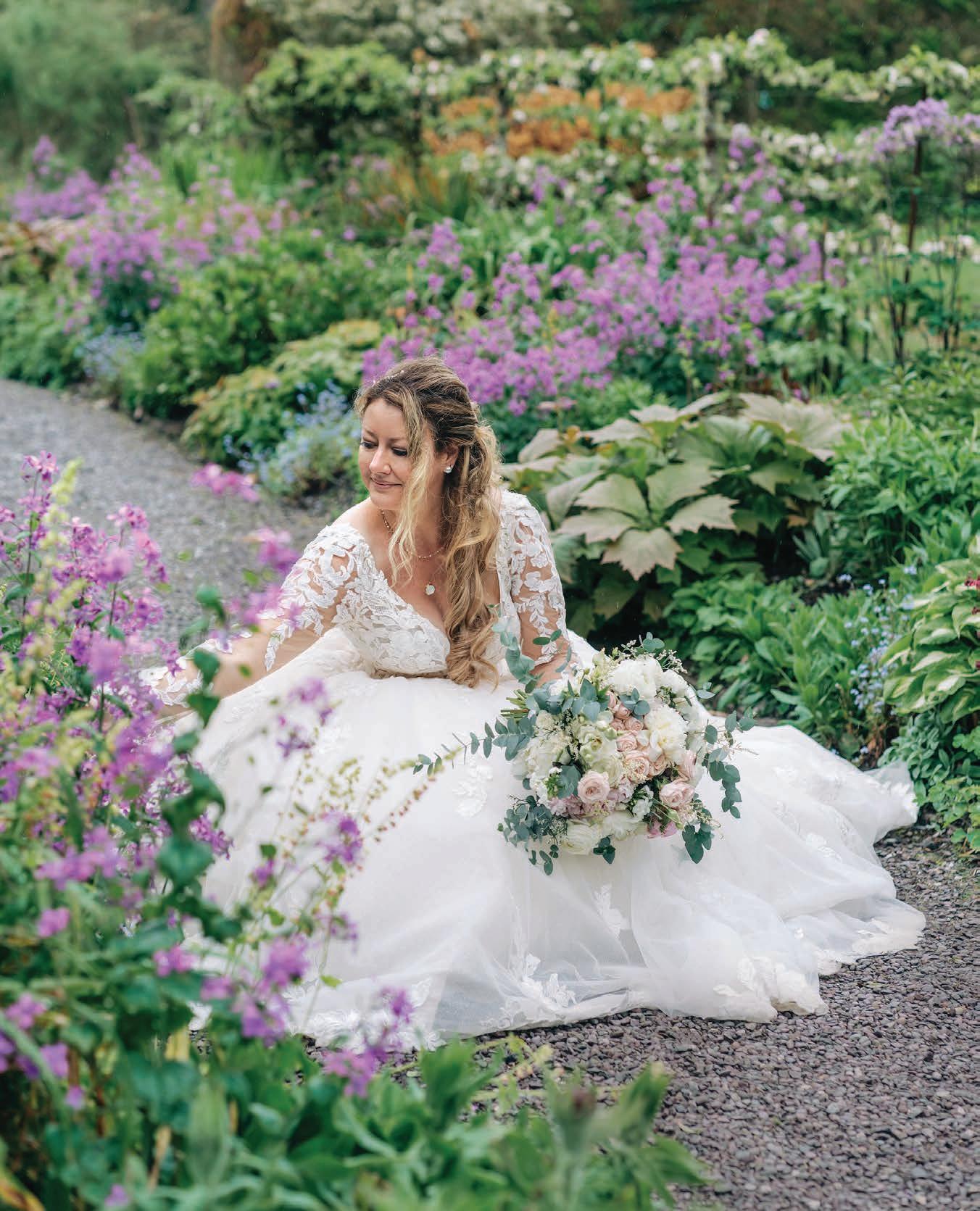
lush garden in Bantry, Ireland hosts the wedding of Brittany Swartz & Steven Thompson POP THE CORK! THE FIRST THE ONLY Magazine ® VeroBeach MARCH
A

















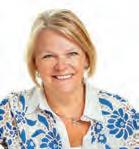



















Prezioso Managing Broker
Landers 772.473.7888 Gena Grove 772.633.0106 Michelle Clarke 772.263.0386 Dreams into Realty. Our Neighborhood Experts can help you turn your Becky Rossway 772.633.4190
Schulz-Long 772.559.4464 Juan Luis Vergez 305.775.7895 Brad Shearer 772.538.0330 Kelly Spence 772.453.9424 Katrina Yarick-Stawara 407.375.5247 Claudia Johnson 772.473.4345 Danielle Putis 201.788.3500
Owen 772.473.0828 Sherry Goff 603.714.5899 Stacy Katz 772.205.4855 Cynthia Palmer 305.710.5417
Jennings 303.518.0740
Martin 772.360.6956
Ratfield 512.663.2660
Fulchini 772.538.8365 Bethany Burt 772.766.4926 Bob Faller 772.538.5206
Hewett 772.321.4282
Hanson 772.713.6450
Livers 772.559.6958
Burge 772.538.0063
Carol
Chip
Cindy
Steve
Beth
Amanda
Pamela
Maria
Peggy
Gretchen
Beth
Cheryl
Burleson 772.774.4425
Leigh
Frances Driscoll 772.766.5942
Mary
772.696.0819
Lofaso 904.248.1357
Melinda
Pampallona
Natalie
512.751.6932
Bill Ratfield
Borenz 772.925.9277
Harper 772.633.6336
Steve
Andrew
772.473.7255
Delamarter 772.321.3056 Real Estate’s FOREVER Brand SM
Seeberg 772.696.0651
Debbie
Bell
Heather
Mark


Exclusively at 3325 Ocean Drive, Vero Beach, FL | 772.234.3404 SPECIAL EVENT With a Guest Appearance By Elizabeth Locke March 26th & 27th Very Vero. Very Veranda.

















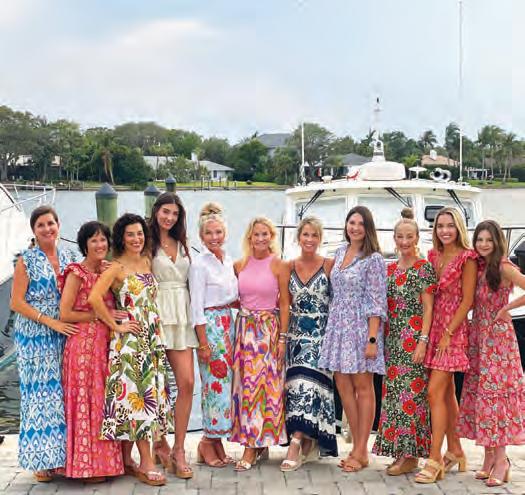

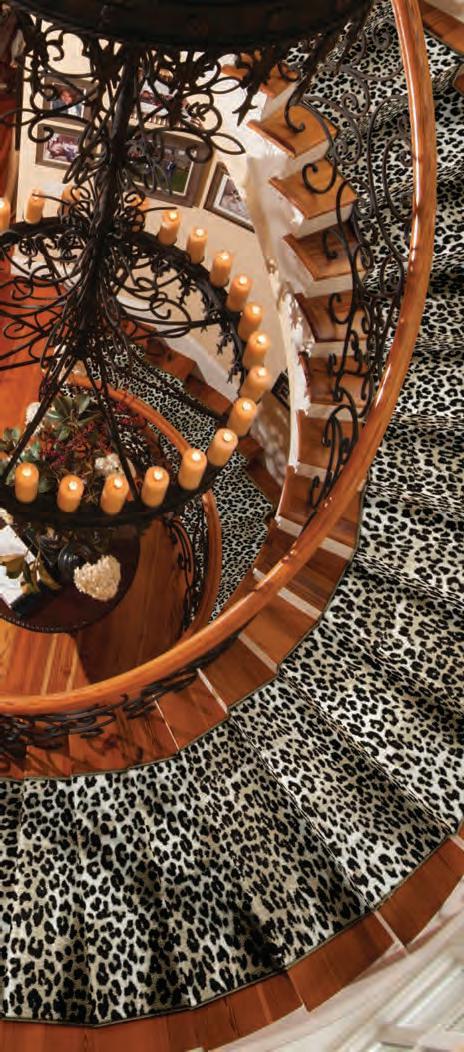



NEED A LITTLE ASSISTANCE? Call and schedule your complimentary in home design consultation today! 1715 Old Dixie Hwy. Vero Beach, FL 32960 (772) 978-9111 | www.designerstouchflooring.com Kim Black, Floor Specialist Visit Our Floor Gallery Today! NEED TO MAKE A FLOORING S E L E C T I O N ? LET THE EXPERTS HELP YOU! Exquisite Hardwood Floors, Area Rugs and Stair Runners

CROOMCONSTRUCTION.COM | @CROOMCONSTRUCTION | 772.562.7474 built for life SINCE 1978


INTERIORS coastal
Crystal Lemley Senior Designer




660 Beachland Boulevard, Suite 204 | Vero Beach, FL 32963 | 772.492.6881 | coastal.net
Gregory Allan Ness
Principal Designer






Welcome to John’s Island. A cherished haven enjoyed by generations who have discovered the undeniable allure of life by the sea. luxury
 800
800
Beach Road #171 : $2,975,000 Gorgeous and Serene Location : 2,250± SF : 2BR/2BA : Ample Space
estates : condominiums : homesites : townhouses : cottages 772.231.0900 : Vero Beach, Florida : www.JohnsIslandRealEstate.com
: $2,795,000
Updated : Chic Interiors : 3BR/3BA : Private
Bedrooms
777
Sea Oak Drive #702
Newly
Balconies For
90 Stingaree Point : $4,750,000
Build Dream Home : 1.56± Acres : Water Access : Private Gate Access
181 Coquille Way : $6,225,000 Beautifully Updated : 3BR+Bonus Room/4.5BA : Redone Outdoor Living & Pool
Freshly Completed : 5BR/5.5BA
7,473± GSF
Dock
120
Coconut Palm Road : $12,500,000 Soundfront Location :
:
:
$7,995,000 Stroll
4BR+Library
.55± Acres
who allure
6
Sea Court :
To Ocean :
:
: Spacious Interiors


860 Seaward Drive : 4,290± GSF : .32± Acres : Newly Completed : Offered at $7,595,000 : www.JohnsIslandRealEstate.com
Donna


PART BY THE STATE OF FLORIDA, DEPARTMENT OF STATE, DIVISION OF ARTS AND CULTURE, THE FLORIDA COUNCIL ON ARTS AND CULTURE, AND THE NATIONAL ENDOWMENT FOR THE ARTS.
SPONSORED IN
www.mckeegarden.org THE MYTH MAKERS
Dodson & Andy Moerlein THRU APRIL 28, 2024
©JPR Images
Photography



Vero Millwork, Inc. is Indian River County’s oldest locally owned and operated door, trim and accessories company. Come visit our showroom and sit down with one of our experts. 5150 42ND PLACE | VERO BEACH, FL 32967 | 772-569-7155 | VEROMILLWORK.COM
Features









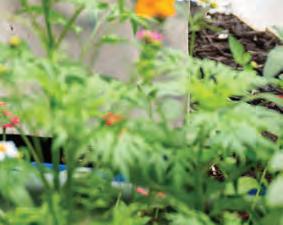



102


116

POP THE CORK!
Bri any Swartz and Steven Thompson tie the knot in a garden on the Emerald Isle
By Ann Taylor
110
A NOBLE DECISION


Terry Stough chooses to preserve his family’s land legacy in a way that will benefit us all
By Chris Fasolino
116
GIVING LIMITS THE BRUSH-OFF
Artist and teacher Dawn Miller has opened her heart and home for the Village Arts VB initiative
By
Ann Taylor

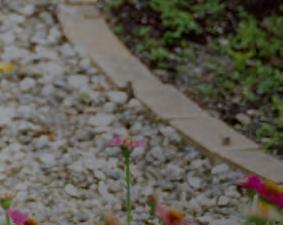
122
PLAYLAND WITH A PURPOSE
A couple’s seaside cabana welcomes what they value most: family, nature, and philanthropic causes
By Renáe Tesauro
130
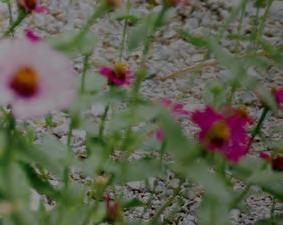

GOLDEN OPPORTUNITIES
For Barbara du Pont, unforge able photographs are born of patience and light
By Teresa Lee Rushworth

VERO BEACH MAGAZINE
CONTENTS
STEVEN MARTINE

32 east 57 th street , 2 nd floor , new york , new york 10022 · (212) 421-5390 FINDLAY GALLERIES 165 worth avenue , palm beach , florida 33480 · (561) 655-2090 Copyright © 2024, Wally Findlay Galleries International, Inc. All rights reserved. view our gallery online | www. findlaygalleries. com EXHIBITION ON VIEW PALM BEACH FINDLAY GALLERIES EST. 1870 PALM BEACH / NEW YORK Charles Neal | The Rose Garden, the Days That Have Past | oil on canvas | 36 1/8 x 66 1/8 in. COMMISSIONED PAINTINGS OF BELVOIR CAS TLE
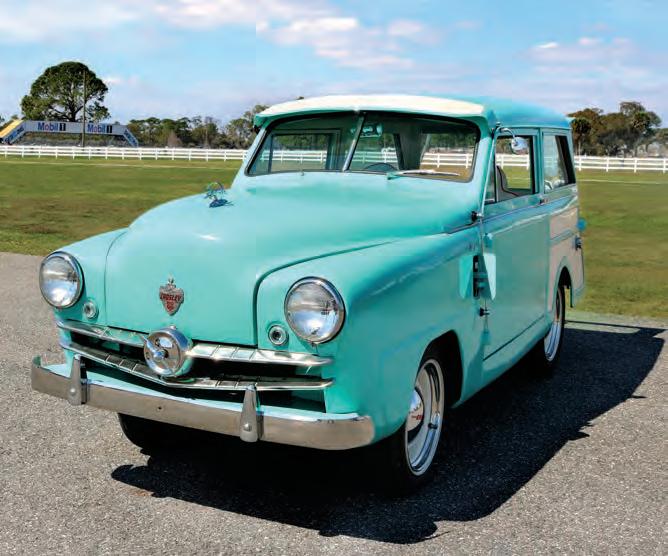

76
32 OUR 2024 ADVISORY BOARD
VERO VIBES
38
WILDE SIDE
The DNA of poetry runs through our lives; it may even live next door
By
Evelyn Wilde Mayerson
50 FACES
Artist Rick Kelly partners with the Land Trust to support preservation efforts
By Ann Taylor
54
INDIAN RIVER INSIGHTS
Artificial intelligence can describe, but never replace, authentic community engagement
By Jeffrey R. Pickering
66
CLASSIC CARS
The 1950 Crosley CD Super Station Wagon
By Patrick Merrell
COASTAL LIFE
Deciphering the intricacies of rug selection can underlie the revival of a room
By Valerie
Cruice
76
HOMEGROWN
Houseplants can bring joy without an overwhelming workload
By Nickie Munroe
14 VERO BEACH MAGAZINE CONTENTS
66
74 SPACES
Departments
PATRICK MERRELL




COMPLIMENTARY WILL & ESTATE PLANNING WORKSHOP -Discover how toProtect Yourself, Your Loved Ones, and Your Assets. Light Food & Refreshments Will Be Provided. Seating is Limited. RSVP Required. RSVP BY SCANNING THE QR CODE OR BY CALLING 772-589-5500 If you do not have a will or trust, you leave your financial & family decisions in the hands of the government. Workshops are presented by Attorney Alfred G. Morici, Attorney Jennifer R. Denorio, and Attorney Elle Nichols. Attorney Morici was admitted to the Florida Bar November 1971 MARCH 6TH, 2024 4:30PM - 6:30PM Hampton Inn & Suites 611 20th Place MARCH 13TH, 2024 11AM - 1PM Regency Park 910 Regency Square Vero Beach, FL 32967 772.589.5500 | info@lulich.com | lulich.com MARCH 27TH, 2024 1PM - 3PM Costa d’Este Beach Resort 3244 Ocean Drive Vero Beach, FL 32963
CONTENTS

80

162
80
LIVING WELL
With early diagnosis and proper treatment, children with ADHD can reach their full potential as adults
By Renáe Tesauro
90
BY THE BOOK
The Mystery Guest by Nita Prose
By Elizabeth Leonard
92
TRUE TAILS
Try teaching your old cat some new tricks
By Amy Robinson
NEW & NOTEWORTHY
140
ON THE MARCH
Local people and products are always keeping things interesting
LOCAL FLAVOR
162
THE DISH
Dignity Food Trucks are serving up opportunities for a better life
By Chris Fasolino
166
OFF THE VINE
Madeira was an early-American luxury we can share with our Founding Fathers
By Chris Fasolino
170
THE SCENE
With culture and caring, local nonprofits enrich the community in countless ways
188
GALLERY GUIDE
March to your own beat with art to suit everyone’s fancy
195
CALENDAR
Community events are at full throttle this month!
202
BUSINESS DIRECTORY
Thank you for supporting our local businesses
208 ROOTS
Before Sebastian’s 1923 incorporation, Main Street was beginning to buzz
By Ellen E. Stanley
ON THE COVER:
Bride Brittany Swartz Thompson glories in a breathtaking Irish garden.
See the story on page 102.
Photograph by Irina Duane
16 VERO BEACH MAGAZINE
KIM BOTTALICO










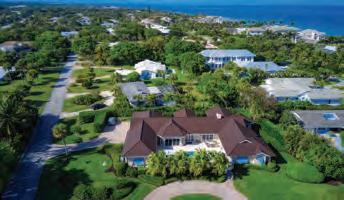

Season is in Full Swing! Thinking about Buying or Selling? I would love the opportunity to earn your business! REALTOR® (772) 559.1359 ccurley@dsreinc.com TOP PRODUCER @ BERMUDA BAY Offered at $11,995,000 RIOMAR Offered at $9,995,000 ORCHID ISLAND Offered at $3,895,000 #3 Real Estate Agent in Indian River County in 2023 FORSALE FORSALE RIOMAR Offered at $4,795,000 FORSALE FORSALE OCEAN CORP Offered at $1,975,000 FORSALE CACHE CAY Offered at $1,695,000 FORSALE SAN SEBASTIAN SPRING Offered at $995,000 FORSALE INDIAN RIVER CLUB Offered at $795,000 FORSALE OCEANGATE Offered at $1,025,000 UNDER CONTRACT FLORALTON BEACH Last Asking Price: $2,495,000 SOLD
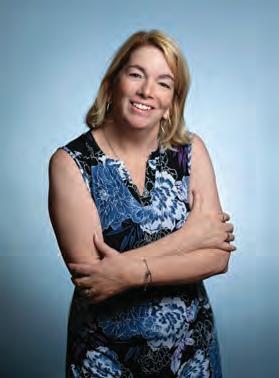
AHeart & Home
s we “March” forward into spring, I’m tugged back into memories of my home growing up in Connecticut. Mom had quite the green thumb— something I was not lucky enough to inherit. The gardens surrounding our home were beautiful in the spring, filled with bright yellow forsythias, lilacs, tulips, and my absolute favorite, pansies. She even grew summer vegetables in the backyard. But right there in the first flower bed just outside the front door was our version of a little Blarney Stone, a gift from a treasured neighbor and friend.
Our March issue is where we celebrate our homes and gardens, and two of our fabulous features bring both together with a bit of an Irish twist! Our cover feature takes us across the Atlantic Ocean to a gorgeous spot on the Emerald Isle where Vero Beach residents Brittany Swartz and Steven Thompson exchanged vows in 2023—Bantry House in County Cork. Kris Trustey and her husband, Sean McGraw, both with ties to the University of Notre Dame, tell their story of healing and renewal and how that connects to the cabana property they created next to their oceanfront home.
Sharing her home in the Vero Beach Art Village with other creatives is just what artist Dawn Miller loves to do. Two days each week, she opens her brightly colored front door (not to be outdone by the riot of color in her gardens or the murals on her fences) to adults with special needs. During their hours together, she shares her passion for art and does what makes her truly happy: giving back to others.
Barbara du Pont, local photographer and one of the artist-owners of Gallery 14, is right at home in the outdoors, as she has proven in her work from all over the world. She’s traveled to all seven continents with cameras in hand, documenting the wildlife of some of the most exotic and remote places on Earth. What’s her favorite subject to photograph? Moms and babies.
We can’t have all this talk of gardens and the outdoors without including the Indian River Land Trust in this issue. Executive director Ken Grudens recently announced the acquisition of a new property on the edge of the St. Sebastian River. We are lucky enough to tell you about the generous and heartfelt decision Terry Stough and his family made when selling the property to the IRLT to help with the nonprofit’s Indian River Lagoon conservation efforts.
If you’re out and about in what should be beautiful March weather, come see the staff of Vero Beach Magazine at Under the Oaks in Riverside Park March 8–10. We can’t wait to meet you!
 Kelly Rogers editor@verobeachmagazine.com
Kelly Rogers editor@verobeachmagazine.com
18 VERO BEACH MAGAZINE
DESK
EDITOR’S



3401 OCEAN DRIVE VERO BEACH 772.234.8522 WWW.LEIGHJEWELERS.COM GRADUATE GEMOLOGISTS CUSTOM DESIGN JEWELRY & WATCH REPAIR
Direct Oceanfront Living $1,445,000
1150 Reef Road #B28, Sabal Reef in The Moorings

Nothing but ocean! Top floor, DIRECT OCEANFRONT 3 bedroom condo with views that “WOW” you as soon as you open your front door. Updated in 2018, this unit has an open kitchen, new flooring, fresh paint, impact glass windows, storm shutters for every opening PLUS 2-car garage parking and a huge storage room. Sabal Reef in The Moorings is an intimate community of just 28 residences with onsite maintenance, community clubroom, heated pool and private beach access. A small pet (up to 20 lbs.) is allowed with board approval.




772.231.5131 www.TheMoorings.com Sales@TheMoorings.com 2125 Windward Way, Vero Beach, FL 32963

226A Worth Avenue Palm Beach, FL 561-833-0550 PROVIDENTJEWELRY.COM EXPERIENCE THE ULTIMATE LUXURY DESTINATION Now Open!
OUR INTERIORS STAND THE TEST OF TIME...JUST ASK OUR CLIENTS


INTERIOR DESIGN WWW.LKDEFRANCESANDASSOCIATES.COM 772.234.0078


VISIT US AT: ODAREBOGA.COM © 2024 ONE Sotheby’s International Realty. All rights reserved. Sotheby’s International Realty® and the Sotheby’s International Realty Logo are service marks licensed to Sotheby’s International Realty Affiliates LLC and used with permission. Vero’s #1 Team For Over a Decade. We Simply Do More. CINDY O’DARE | 772.713.5899 RICHARD BOGA | 772.559.4800 KRISTIN DOBSON | 772.321.6541 LILY O’DARE | 772.643.4938 DAN DOWNEY | 772.713.6314 MAZIE REGAN | 772.214.8708 ANNE WALLACE | 772.532.3226 DANIEL OCHSE | 772.633.8200 VANESSA BYNUM | 772.268.3135 JULIA BUSCH | 772.216.1048 CARLY WITTECK | 772.643.1039 WHO YOU WORK WITH MATTERS. CALL US TODAY #1 Team inVero Beach FROM LEFT TO RIGHT: DAN DOWNEY, CARLY WITTECK, JULIA BUSCH, DANIEL OCHSE, VANESSA BYNUM, CINDY O’DARE, RICHARD BOGA, LILY O’DARE, KRISTIN DOBSON, MAZIE REGAN, ANNE WALLACE
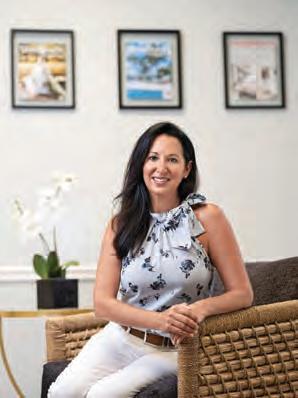
Make the Most of March
As we prepare to spring into the warmer months, I’ve been thinking about the significance of March for us in Vero Beach. It’s usually the month of one last cold snap before we put away our sweaters and start to change gears in our gardens. I recommend keeping an eye on the wise advice that Master Gardener Nickie Munroe provides in each month’s Homegrown article.
Winter’s swan song makes March what I consider to be “prime time” here on the Treasure Coast; season is still in full swing, so there are loads of activities and events to choose from, especially those that take place outdoors.
Of course, March is the month of the Vero Beach Art Club’s hugely popular Under the Oaks show, so be sure to check out this staggering array of art during the second weekend of the month.
Another perennial favorite is the annual AACA Car Show, also held at Riverside Park. It’s great fun to walk around, marvel at these impeccably maintained and restored classics, and even chat with their proud owners.
If you find outdoor music appealing, you may want to catch Jazz Under the Stars at St. Francis Manor on March 15—a chance to enjoy some smooth sounds while supporting affordable housing for our seniors.
Vero Beach Museum of Art will also jazz things up when pianist Mike Telesmanick plays the March 21 Concert in the Park. The Night Sounds concert March 23 offers an opportunity to enjoy more live music under the nearly full moon at Sebastian Inlet State Park.
Another musical event that intrigues me this month—an indoor one this time—is Vero Beach Opera’s March 24 presentation of “Scenes from Zarzuelas,” which will expose us to a distinctly Spanish form of musical theater.
Thank you for your continued support, and happy reading!
 Teri Amey-Arnold, Publisher publisher@verobeachmagazine.com
Teri Amey-Arnold, Publisher publisher@verobeachmagazine.com
24 VERO BEACH MAGAZINE
WELCOME

615 Beachland Boulevard | Vero Beach, FL 32963 | www.vbhome.us



KELLY
OLGA
RENÁE TESAURO Editor at Large
Valerie Cruice, Chris Fasolino, Elizabeth Leonard, Evelyn Wilde Mayerson, Patrick Merrell, Nickie Munroe, Jeffrey R. Pickering, Amy Robinson, Ellen E. Stanley
26 VERO BEACH MAGAZINE THE LAUGHING DOG GALLERY | CELEBRATING 2910 CARDINAL DRIVE, VERO BEACH • 772.234.6711 THELAUGHINGDOGGALLERY.COM
ROGERS Editor in Chief
M. GUSTINE Creative Director TERESA LEE RUSHWORTH Senior Editor
ANN TAYLOR Senior Writer JENNY FERNANDEZ-PRIETO Art Director
CONTRIBUTING WRITERS
JANINE FISHER Senior Graphic Designer LEONOR ALVAREZ-MAZA Digital Imaging Specialist
CONTRIBUTING PHOTOGRAPHERS
SINCE 1997 THE FIRST THE ONLY Magazine © VeroBeach
Kim Bottalico, Irina Duane, Barbara du Pont, Steven Martine, Patrick Merrell, Lauren Rubenstein, Sam Wolfe




28 VERO BEACH MAGAZINE TUE-SAT 11AM-6PM or by appointment 772-231-3900 3465 OCEAN DRIVE VERO BEACH, FL JMStringerGallery.com A Gallery of Quality and Tradition CUSTOMER PARKING IN REAR OF GALLERY J. M. Stringer Gallery of Fine Art world-wide collections of fine original paintings objets d’art • sculptures • select antique furnishings featuring paintings by John Phillip Osborne John C. Traynor & Important Painters from the Past exhibition opening Thursday - Saturday, March 14 - 16, 2024 Thursday 4-8PM | Friday & Saturday 11AM-6PM exhibition on view through April 27, 2024 paintings of today & yesterday’s masters Fernand Toussaint Belgian 1873-1956 At the Mirror | 13 x 10 | Oil on Canvas John C. Traynor | Pathwork Fields Donegal 18 X 24 Oil on Linen History in the Making John Phillip Osborne | The First InaugurationFederal Hall NY 1789 10 X 14 Oil on Canvas TERI AMEY-ARNOLD Publisher teri@verobeachmagazine.com MEGAN HYDE ROBERTS Production Coordinator megan@palmbeachmedia.com CATHY HART Executive Office Manager & Subscription Manager cathy@verobeachmagazine.com 772-234-8871 PUBLISHERS OF: Palm Beach Illustrated • Naples Illustrated • Vero Beach Magazine • Palm Beach Charity Register • Naples Charity Register • Florida Design • Florida Design Naples • Florida Design Miami • Florida Design Sarasota • Florida Design Sourcebook • Palm Beach Relocation Guide • Southwest Florida Relocation Guide • Fifth Avenue South • Palm Beach 100 Naples 100 • Art & Culture: Cultural Council for Palm Beach County • Pinnacle: Jupiter Medical Center Foundation • Waypoints: Naples Yacht Club • Naples on the Gulf: Naples Chamber of Commerce • Jupiter • Stuart • Aventura • Community Foundation of Collier County Community Report • Advances: Tampa General Hospital Published by Palm Beach Media Group North, LLC, P.O. Box 3344, Palm Beach, FL 33480 561-659-0210 • Fax: 561-659-1736 SUBSCRIPTIONS: One year $28; two years $45; three years $54. Subscribe online at www.verobeachmagazine.com or call 772-234-8871 weekdays from 8 a.m.–4 p.m. ET. American Express, Discover, Mastercard, and Visa are accepted. Our subscription information is never shared, rented, or sold. Group Publisher Terry Duffy National Sales Director Deidre Wade Chief Operating Officer Todd Schmidt Editorial Director Daphne Nikolopoulos HOUR MEDIA, LLC CEO Stefan Wanczyk President John Balardo Founder Elizabeth Moulton SINCE 1997 THE FIRST THE ONLY Magazine © VeroBeach




YOUR LOCAL TOMMY BAHAMA STORE 1295 US HWY 1 Vero Beach, FL 32960 772.569.0460 • sunshinefurniturecasual.com Mon-Sat 10am-5:30pm • Sundays noon-4pm Outlet Store: 1394 US 1 • Monday - Saturday 10am - 5pm



Vero Beach Magazine is the first magazine to be dedicated exclusively to Vero Beach and remains the only local magazine with verified circulation. A minimum of 10,000 magazines are distributed monthly, to at least 30,000 readers in almost every state, including Alaska and Hawaii.
Vero Beach Magazine’s staff is committed to using print media to make Indian River County a better place for all residents, mindful of environmental and historic preservation, while underscoring the best aspects of life in this charming oceanfront community.
Winner of numerous awards since its inception, starting with the Florida Magazine Association’s Best New Magazine Award in 1998, Vero Beach Magazine has made its greatest impact by providing meaningful information to readers about the needs of local nonprofit organizations in Indian River County, inspiring philanthropy and prompting nonprofit coverage by many other media companies.
Our office is located at 3375 20th Street, Suite 100, on the corner of 34th Avenue and State Road 60, in Vero Beach. Visitors are welcome by appointment from 8 a.m. to 4 p.m., Monday through Friday, for subscription, article, and advertising questions.
30 VERO BEACH MAGAZINE 3375 20th Street, Suite 100, Vero Beach, FL 32960 772-234-8871 hello@verobeachmagazine.com SANDRA MORGAN INTERIORS & ART PRIVÉ VERO BEACH · 772.234.2910 G REENWICH · 203.629.8121 WWW.SANDRAMORGANINTERIORS.COM
VERO
B EAC H · G
Game On! Complete Design Services at The Village Shops.
REENWI C H · WESTC HESTE R · N ANTUCKE T · HAMPTONS
ASID
Sandra
Morgan,
INSIDE VERO BEACH MAGAZINE
SINCE 1997 THE FIRST THE ONLY Magazine © VeroBeach
About Us
ASHLEY MEYER




MOULTON LAYNE ARCHIT EC TURE David Moulton | Scott Layne www.moultonlayne.com 772.234.0445 4887 Hwy A1A, Vero Beach, FL 32963 Member Of The American Institute Of Architects Connecticut #5131 Florida #AA0003621 New York #035227
OUR 2024 ADVISORY BOARD

SOPHIE BENTHAM-WOOD is a native of London. At Sheffield University, she studied the history of art, design, and film, earning a bachelor’s degree. She then embarked on an illustrious career in marketing and public relations that now spans 25 years. Sophie moved to the United States in 2008, and, since 2012, she has been the director of marketing and communications at the Vero Beach Museum of Art. In this capacity, she oversees enterprise activities, including Visitor Services, the Museum Store, and the Museum Café. She is also part of the senior management team. In her tenure, she has managed the introduction of an admission charge, overseen a rebranding of the museum’s logo, and played a major role in reenvisioning and shaping the VBMA’s strategic plan. More recently, she has implemented a fully integrated marketing campaign for the museum.

KEVIN GIVEN hails from White Sulphur Springs, West Virginia, home of the worldfamous Greenbrier resort and hotel, where he was a fourth-generation team member. He earned a degree in hospitality and tourism management, with a minor in business administration, from Concord University in Athens, West Virginia, and has now been in the resort/private club management field for over 40 years. He is a board member at the West Virginia University Foundation and a hospitality management advisory board member at WVU’s John Chambers College of Business and Economics. In 2001, he was one of the founding partners at Quail Valley, and he was also on the executive team developing Windsor and Orchid Island. Kevin has served on the boards of the Indian River Community Foundation, the Environmental Learning Center, and Saint Edward’s School.

TRUDIE RAINONE has lived in Vero Beach for 23 years and has served the community in leadership roles with a variety of Indian River County nonprofits. Her passion for outreach has her currently serving on the executive boards of Senior Resource Association, ORCA, Youth Guidance Mentoring Academy, and Senior Collaborative. She is also a health care partner volunteer with Cleveland Clinic Indian River Hospital and vice chair of Quail Valley Charities, which funds 43 local children’s organizations. A native of New York City, Trudie reared her children with her husband of 50 years, Donald, in both New York and New Jersey. She is the proud grandmother of two boys, Chase and Drew. She has a merchandising background in the fashion industry and was a business owner specializing in fine antiques.
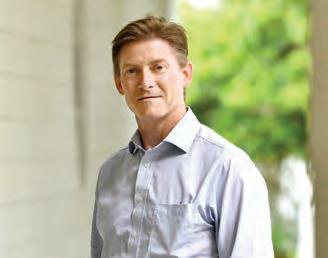
JON R. MOSES is the managing director and COO of Riverside Theatre, where he has worked for 25 seasons. A Treasure Coast native, he studied theater design technology at Florida State University’s School of Theatre, followed by graduate studies at Florida Atlantic University. He has been involved in every aspect of theater for over 32 years. He has even served as an adjunct faculty member at Indian River State College, where he taught and coordinated an associate of science technical theater program. Jon’s involvement in the community includes serving as treasurer on the board of the Indian River County Chamber of Commerce and as a member of the Exchange Club of Indian River. He was also a board member of the Oceanside Business Association and president of the Florida Professional Theatre Association.

JESSICA LINUS WATFORD moved to Vero Beach as a 10th grader and attended Saint Edward’s school. A graduate of Auburn University (War Eagle!), she lived in Atlanta and Raleigh before returning to Vero Beach in 2015 and joining her father and grandfather in the family business, Linus Cadillac Buick GMC. In 2019, she graduated from the National Automobile Dealers Association Academy and is now a proud third-generation dealer-operator at Linus. Jessica resides in Okeechobee with her husband and two young daughters. She enjoys the best of both worlds, between boating days on the water and country life, rodeos, and ranching.
32 VERO BEACH MAGAZINE
LEAD ADVISER


“They are quick to respond and the quality of work is outstanding. We never had any doubt that they had our best interests at heart. We would recommend them without hesitation.” – Windsor Resident
•CUSTOM-TAILORED SERVICES FOR YOUR HOME
•RESPONSIBLE & EXPERIENCED TECHNICIANS
•BACKED BY EXPERTS IN THE INDUSTRY
772.234.5722 | www.CaretakersVeroBeach.com | 1902 Wilbur Avenue | Vero Beach, FL 32960

VERO BEACH PALM BEACH | NANTUCKET
“I believe beauty is a way of life and a beautiful home has the power to bring you happiness, delight, ease and a sense of peace to your life.”

ALEXANDRA C. NUTTALL, ASID



WWW.ALEXANDRANUTTALL.COM O FFICE@ALEXANDRANUTTALL.COM
772.231.3746







MARCH 2024 37 Vero Vibes WILDE SIDE | FACES | INDIAN RIVER INSIGHTS | CLASSIC CARS 50 FACES Artist Rick Kelly partners with the Indian River Land Trust to support preservation. Detail of Early Morning Feeding by Rick Kelly

The Traverse of Time

THE DNA OF POETRY RUNS THROUGH OUR LIVES; IT MAY EVEN LIVE NEXT DOOR
 BY EVELYN WILDE MAYERSON
BY EVELYN WILDE MAYERSON
Adazzling start to Vero Beach’s fall season was the Laura (Riding) Jackson Foundation’s presentation of poet Billy Collins speaking at both a luncheon at Quail Valley River Club and, on the evening of the same day, at the Community Church of Vero Beach. Collins, a poet laureate of the United States who was inducted into the American Academy of Arts
and Letters in 2016, read selections from his collected works, including Aimless Love and Musical Tables. Conversational, witty, and often profound, Collins gave the audience his observations of the everyday, some with a sudden turn at the end, as in the poem titled 3 a.m. that read, “Only my hand is asleep, but it’s a start.”
It is entirely fitting that the appearance of Billy Collins,
hailed by critics as “the people’s poet,” was at the initiative of the Laura (Riding) Jackson Foundation, a notable presence in Indian River County since its inception by Marie Stiefel in 1992. Established in honor of the internationally known poet whose name it bears—who lived and worked in Wabasso for a number of years—the foundation aims to promote writing.
38 VERO BEACH MAGAZINE
WILDE SIDE
LITERATURE
Billy Collins
BILL HAYES


CUSTOM INTERIORS • FURNITURE & ACCESSORIES • SHOWROOM • CONSIGNMENT A Full Service Interior Design Studio 1865 14th Avenue Vero Beach, FL 32960 page2design.net 772-492-9220 Admin@Page-2-Design.com SERENITY
As an art form, poetry predates prose.

With accessible offices on Vero Beach’s 14th Avenue, the foundation offers teen workshops open to all high school students; adult writing workshops and groups; an all-day writer’s retreat held this year in February at the Vero Beach Garden Club; informal gatherings of the Porch Poets and the Pole Barn Poets, who read to one another from their works; plus a yearly poetry and barbecue event to be held April 13 on the campus of IRSC’s Mueller Center, less than 150 yards from Jackson’s relocated Wabasso cottage. This year’s event will feature poet B.H. Fairchild, winner of the Book Circle Award, and John Balaban, prize-winning author of 13 books of poetry and a former colleague at the

University of Miami.
Prominent in the workings of the foundation is Vero Beach artist, poet, and cattle rancher Sean Sexton, poet laureate of Indian River County and a regular presenter at the National Cowboy Poetry Gathering in Elko, Nevada. Like Collins, Sexton deals with his everyday experiences, in his case things such as “righting a leg” in the birthing of a calf. A working rancher, Sexton belies the image of poet as a lofty effete whose words and affectations are as frivolous as a doily.
Sexton and Collins’ use of the ordinary is not new. They, like most contemporary poets, are inheritors of a movement that began over 200 years ago when, in 1801, English poet laureate William Wordsworth announced a revolution in poetry. Declaring independence from the stilted conventions of poetic language, the private lexicon of men of letters, Wordsworth
proclaimed the equality of the reader with the poet and further declared that the poet’s mission was not only to choose incidents and situations from common life, but to describe them in language used by ordinary people.
Decades later, American poet Walt Whitman furthered the cause of unfettered verse by offering free verse, untrammeled by either rhyme or meter.
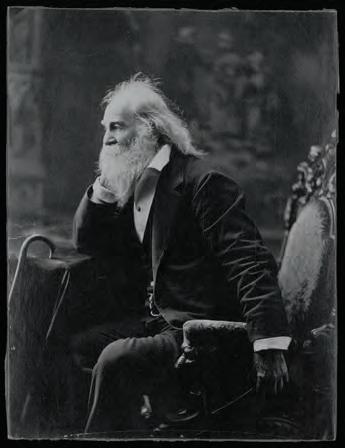
For some readers, whether rhymed or not, poetry might seem an acquired taste, an obscure and arcane literary form that perhaps they once had to memorize. The truth of the matter is that we have been tuned into its rhythms since before we were born. We find poetry in the alternation of night and day and light and dark, cosmic cycles ingrained
in our subconscious along with seasons and the pull of the tides from the phases of the moon that resolve in the circadian rhythms that govern our blood pressure, heart rate, and sleeping state.
As an art form, poetry predates prose. The metrical language of verse was how our ancestors preserved their history, a generational telling and retelling that eventually spawned the Norse Edda and Homer’s epic of the Trojan War. Poetry is found everywhere. It may be a personal
40 VERO BEACH MAGAZINE
WILDE SIDE
William Wordsworth (below) and Walt Whitman (right) both favored poetry reflecting everyday life, free of lofty, stilted language.


INVESTMENT OPPORTUNITIES 985 Clipper Road - Vero Beach 32963 Luxurious Beach home East of A1A. Available early 2024. Inquires welcome 233 Oak Hammock Circle SW - $1,500,000 Old Dixie Hwy - 50,000 sq. ft. mini storage Your Life, Your Style. Build with Us! 2020 Old Dixie Hwy SE | Suite 6 | Vero Beach, FL | 772-562-3715 | www.calbuildersinc.com EXPERIENCED | KNOWLEDGEABLE | RELIABLE FOR OVER 30 YEARS





bias, but Floridians seem to encourage it. Perhaps verse is inspired by our relative newness; our wildlife, glorious sunsets and warm, scented breezes; our diversity and our history, which on occasion turned the state into a battleground. is last is re ected in a poem by an unnamed Seminole, which begins, “ ere is a sickness in my heart. It began a long time ago with three evil spirits that came out of the sea.”
Nineteenth-century poet Sidney Lanier, known for his adaptation of musical meter to poetry and regarded by many Southerners as the “poet of the Confederacy,” was paid after the Civil War
to write a promotional tract on Florida. While living in Tampa, Lanier was inspired to write, in addition to a guide titled Florida: Its Scenery, Climate, and History, several poems about the state, including A Florida Sunday, A Florida Ghost, Tampa Robin, and e Bee, which “thrust up its sadgold body lustily, all in a honey madness hotly bound.”
Although Lanier’s tenure was brief, he was followed by other poets, some to be born in Florida, many others adopting the state as home—poets such as Miamians Hannah Kahn, winner of numerous national awards, and Donald Justice, who won the Pulitzer Prize for Poetry in





VERO BEACH MAGAZINE
WILDE SIDE WWW.LEAHMULLERINTERIORS.COM WWW.COASTAL-MODERN.COM
Southern poet Sidney Lanier penned several poems about Florida, as well as the guide Florida: Its Scenery, Climate, and History

Charlotte

Diane


Kit



Martin



Patty




Kimberly

Michele

Shannon


Cheryl


Carolyn


Kennedy 626-399-2826
Candace
Ritchie 772-532-7288
DeFrancisci 772-538-1614
O’Leary 772-205-4412
Fields 770-312-5165
Terry 772-538-2388
Valdes 772-473-8810
Keithahn 772-321-4656
Gerstner 772-539-2100
Carder 772-696-0131 BRAND AMBASSADOR
Watkins 772-696-3736 TRANSACTION LEADER
Keithahn 772-321-4656 Thanks to You, We Present Our 2023 Top Producers!
Sunkel 772-538-2339
Knapp 772-913-0395 TOP PRODUCING TEAM
Knapp 772-696-6302 A Global Mindset for a Community-Driven BrokerageSM alexmacwilliam . com OFFICE 772-231-6509 2901 Ocean Drive Vero Beach, FL 32963
P. Kennedy 772-473-2521
Ansley
Kimberly
Phil
Jim
Stephanie
T.
Lange 772-473-7982
Dietrich 772-532-0865 RISING STARS
Dietrich 772-538-3892
Kennedy 626-399-2826
Barbara
Courtney
Candace
WILDE SIDE
“Listen to this simple story, to this song of Hiawatha.”
– H.W. LONGFELLOW



1980; Key Wester Shel Silverstein—cartoonist, poet and composer of “A Boy Named Sue”; and the funny, sharp, and engaging Peter Meinke of St. Petersburg, who wrote the amusing words, “Marry a pretty girl after seeing her mother” and was named poet laureate of Florida in 2015.
Zen teaches us that everything is connected, which is why I don’t hesitate to introduce another form of poet, those who live on not only in their works but in their DNA— the epic poem, contained in our cells, that carries the record of our journeys. I know such a case—a story that brings illustrious poetic DNA to my very neighborhood.
This particular journey
begins with Zilpah and Stephen Longfellow, solid colonial stock with roots tracing back to the settlement of Plymouth. From there the voyage eventually extends over several generations south to Vero Beach, to Thayer Longfellow Baine, who resides with her husband, Kevin, in the community of Windsor.
Thayer shares her double helix not only with Samuel Sewell, the presiding judge of the Salem witch trials, but with America’s first acknowledged poet, Henry Wadsworth Longfellow, who, in his own time, like the contemporary Billy Collins, has been hailed as a “poet of the people.”
Thayer and her famous cousin share a common ancestor,
44 VERO BEACH MAGAZINE
Henry Wadsworth Longfellow sits for a daguerreotype circa 1850 (right) and in his study about 30 years later (below).


PROVIDENTJEWELRY.COM
WEST PALM NAPLES JUPITER FORT MYERS PALM BEACH WELLINGTON
Presenting Provident Jewelry’s EXQUISITE COLLECTION
WILDE SIDE
the poet’s great-grandfather, Stephen Longfellow II. It is through Stephen’s son William that their lines diverge, Henry’s to remain in the American Northeast, Thayer’s to eventually migrate to the Midwest.
When Henry Wadsworth Longfellow died in 1882, the year Henry Flagler visited St. Augustine and was inspired to build his FEC Railway, Longfellow was the most popular poet in the English-speaking world as well as the first, and up to the present time the only, American poet whose bust has been placed in the Poets’ Corner of Westminster Abbey.
In our own day there has been a resurgence of academic interest in Longfellow, about the
time his cousin Thayer enjoyed careers in both music and math education, each discipline, incidentally, an element of poetry. Taking time off to rear three children before returning to teach sixth-grade math for 20 years, Thayer has been a member of a chorus for 40 years and a bridge life master who loves to walk, play golf, and read to one of her eight grandchildren when the occasion arises. For 10 years, she has served, along with Sara Whiting, as co-chair of the Windsor Book Club.
Thayer even resembles a portrait of Henry’s father, Stephen Longfellow IV. When I look at Thayer, I see more than an accomplished neighbor. I see

a living link to one of America’s greatest poets. The association also triggers memories of lines I once memorized, lines from Paul Revere’s Ride, The Song of Hiawatha, Evangeline, and, from The Village Blacksmith, “a mighty man is he with large and sinewy hands.”

46 VERO BEACH MAGAZINE
The historic Laura (Riding) Jackson house, originally situated in Wabasso, now stands on the grounds of IRSC’s Mueller Campus in Vero Beach.
MARTINA TANNERY


1034 S. Harbor City Blvd | Melbourne, FL | TheHouseOfLights.com | 800-541-3048 LIGHTING ~ CEILING FANS ~ FURNITURE ~ ACCESSORIES ~ DELIVERY ~ ASSEMBLY AND INSTALLATION ~ WARRANTY MASTERSINLIGHTING AND BREEZEDESIGN



Custom Homes Renovations Property Management (772) 696-3736 | THWhitfieldConstruction.com Customized, High-Quality Property Management Services Consistently Exceeding Our Clients’ Expectations Let our Trust, Estate, Civil & Complex Litigation Attorneys serve as your trusted legal advisors. www.RosswaySwan.com Scan to learn more: Offices in: Vero Beach Melbourne Coral Gables (By Appt.) Thomas W. TierneyJ. Cole OliverPaul R. AmosLihua (Lily) ChenRayaan A. Hossain Trust & Estate Litigation • Civil & Complex Litigation • Matrimonial & Family Law • Real Estate Law Wealth Preservation / Estate Planning • Corporate & Transactional Law Probate / Trust Administration • Asset Protection • Local Government Law • Appellate Law Land Use Law • Employment Law • Healthcare Law • Guardianship • Elder Law

All information contained in this advertisement, including renderings and the configuration, elevation, and size of lots, lakes, common areas and roads, reflect preliminary plans only, are not to scale and are subject to change during the final design and permitting process, and should not be relied upon as representation, express or implied, of final detail. The developer expressly reserves the right to make modifications, revisions and changes which it deems desirable in its sole and absolute discretion. WindsorFlorida.com 772 388 8400 A private residential community in Vero Beach, Florida The latest chapter in the story of Windsor INTRODUCING
In His Nature
ARTIST RICK KELLY PARTNERS WITH THE LAND TRUST TO SUPPORT PRESERVATION EFFORTS
BY ANN TAYLOR
Meet Rick Kelly, an award-winning artist whose paintings celebrate the glorious gifts nature has bestowed on us. With each stroke of his brush, images of lush landscapes and native vegetation come alive, forming visual stories of the beauty that surrounds us—beauty we all too often take for granted.
Robinson Waterfront Trail.
“I absolutely love nature, and I’ve always liked what the Land Trust does, so I asked Melissa [DePriest, director of philanthropy and marketing] and Ken [Grudens, executive director] if there was something I could do to help raise funds. A few years ago I donated a painting to one of their auctions, and I thought

That’s what prompted Kelly to partner with the Indian River Land Trust on a fundraising project that showcases Land Trust properties along the Indian River Lagoon where preservation won out over development, among them Bee Gum Point Preserve, Oyster Bar Marsh, the Lagoon Greenway, and the Toni
maybe I could do something similar,” says Kelly, going back to the beginning.
“The three of us had a number of conversations, and it was decided I would do 12 paintings. They gave me free license to roam their properties alone or with one of their staff. I did a tremendous number of sketches to
make sure everything was correct—which way the light was coming from, that sort of thing. There’s a lot of editing involved. It basically took me a year and a half to get all of the sketches and paintings done. As it turned out, I ended up with 18 paintings. I showed them to Ken and Melissa and they chose them all for the annual benefit at Rock City Gardens.”
When DePriest saw Kelly’s paintings, her immediate reaction was “Wow!”
“They’re amazing,” she says. “Rick’s a creative genius, and his paintings are another way for people to see our properties. Three of them are part of a triptych, so when viewed together they create one scene of the Toni

Robinson Waterfront Trail, a mile-long path through scrub habitat and oak forest to the mangroves.”
If Kelly has a favorite, it’s probably those three, due in part to his admiration for Robinson, IRLT director emeritus and passionate preservation advocate. He explains: “As you walk through the trail, especially the mangrove swamps, you get these little openings and see a beautiful bird or fish jumping. It just takes your breath away! Kudos to Miss Toni Robinson and many, many people like her who are protecting places for us, plus the birds, to enjoy.”

50 VERO BEACH MAGAZINE
FACES
ENVIRONMENT
Great Blue, 20 x 30 inches, Toni Robinson Waterfront Trail
Roseate Spoonbills , 20 x 30 inches, Oyster Bar Marsh


Kelly’s love of nature began early, when, as a young boy, he traveled around his home state of Florida with his father and brother, savoring the sights, sounds, and times spent fishing for snook.
A retired Fort Pierce firefighter, Kelly was a student of well-known landscape artist A.E. “Beanie” Backus. He learned well.
In 2007 Kelly received the Florida Senate Medallion of Excellence commemorating his artistic visions of Florida’s
natural beauty. A year later, he and ecologist Camille Yates authored Treasured Waters, a book that combines art with the history and biology of Florida.
Kelly continues to use his art to inspire others to appreciate the natural environment and help preserve it for future generations. On every painting, above his signature, he paints a Jesus fish. “I have a talent I never learned or earned; it’s a gift from God. That’s what I’m about, end of story.”



MARCH 2024 51
Early Morning Feeding, 24 x 30 inches, Coastal
Preserve
Paradise of Birds , 20 x 30 inches, Bee Gum Point Preserve
Oaks
Butterfly Orchids , 18 x 36 inches, Coastal Oaks Preserve
Above: Royal Courtyard North , 24 x 18 inches, Toni Robinson Waterfront Trail
Right: Kelly with Ken Grudens
Staged Scenes from ZARZUELAS!
This is the real deal.
Our Artists specialize in Zarzuelas! Transport to the heart of Spain with passionate melodies & stories brought to life by four remarkable singers, a brilliant ensemble of musicians, and a group of fiery dancers.
March 24 at 3 pm
With English SupertiTles
VBHS Performing Arts Center
MEET THE CAST & PURCHASE TICKETS AT VeroBeachOpera.org






Did you know?
• We invite the top young rising opera singers in the world today to compete for major cash prizes, and we cast many of them in our operas and concerts.
• A two-day pass to the competition rounds is only $20!
Semi-Finals: April 10 at 3 pm
Finals: April 11 at 3 pm
• The formal Awards Concert is April 12 at 7 pm with Master of Ceremonies Ian Campbell
VBHS Performing Arts Center
MEET THE JUDGES & PURCHASE TICKETS AT VeroBeachOpera.org


RisingStars
2024 vocAL Competition april 10, 11 at 3 pm • April 12 at 7 pm

TOCQUEVILLE Melbourne PORSCHE Audi Mercedes-Benz
Everyone Loves a Good COMPETITION!
Dancing
photo by JPR IMAGES from our 2019 production of Carmen










OFFICIAL JEWELER VIP PREVIEW BENEFICIARY THE MOST IMPORTANT INTERNATIONAL MODERN +CONTEMPORARY FAIR OF THE WINTER SEASON TICKETS + INFO AT: WWW.ARTPBFAIR.COM MARCH 21-24, 2024 | VIP PREVIEW MAR 21

The Real Thing
ARTIFICIAL INTELLIGENCE CAN DESCRIBE, BUT NEVER REPLACE, AUTHENTIC COMMUNITY ENGAGEMENT
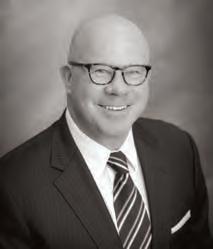 BY JEFFREY R. PICKERING
BY JEFFREY R. PICKERING
For the better part of the last three years, I have had the privilege of writing this Indian River Insights column in Vero Beach Magazine. That’s 36 columns, give or take, written on the topic of philanthropy and charitable giving in our Indian River County community. I submit each by a monthly deadline.

This one was due January 1. Deadlines have a funny way of getting me to pay attention. While there are some months when the specific subject of the column is one that inspires me to start writing well in advance of my deadline, this is one where the words just wouldn’t come. At least not for this writer.
Over the course of the last year, like many people, I read articles and listened to news stories about the rise of artificial intelligence. One aspect of this new technology that piques my curiosity is its ability to compose written content, including articles, social media posts, essays, and other creative material that simulates
54 VERO BEACH MAGAZINE
INDIAN RIVER INSIGHTS
PHILANTHROPY


Your wealth, your life, and your goals are unique. Whether you’re looking to protect and grow your assets for future generations, succeed in your business ventures, or prepare for the unexpected, Wilmington Trust is here to help guide you through life’s transitions. For more information about how we can help you achieve your goals, contact Kate Freeman Senior Wealth Advisor Managing Director, Vero Beach 772.925.3221 kfreeman2@wilmingtontrust.com wilmingtontrust.com Wilmington Trust is a registered service mark used in connection with various fiduciary and non-fiduciary services offered by certain subsidiaries of M&T Bank Corporation. Wilmington Trust traces its roots to the founding of WTC in 1903. ©2024 M&T Bank and its affiliates and subsidiaries. All rights reserved. AMP 6392 240110 VF A heritage of A modern approach. TRUST.

Childcare Resources relies on making connections in the community through fostering empathy with residents who want to help local children.
the work of an actual human being. ChatGPT is one application that has been getting a significant amount of attention lately. Could it be the answer to my writer’s block? I was about to find out.
ChatGPT, which stands for “Chat Generative Pre-trained Transformer,” is an artificial intelligence chatbot developed by the company OpenAI. Once this application is downloaded onto a computer, tablet, or smartphone, it works by attempting to understand a text input, otherwise known as a prompt, and generating a dynamic response. It can do this because the algorithm can search and curate
virtually any content that exists on the internet and present it in a usable format.
As an example, when ChatGPT is given the prompt “What is the best recipe for bread pudding?” it responds, “A classic bread pudding is a delightful treat that brings comfort and warmth.” This statement is followed by a list of ingredients and cooking instructions.
While ChatGPT’s result is both accurate and thorough, and its speed is impressive, there is still something not quite right about this artificially intelligent dessert, at least for my taste, because the recipe calls for two ingredients that
no self-respecting amateur chef living in the South would include: raisins and chopped nuts. Just ask any of the countless neighbors, friends, or family members who have ended a dinner party at my home with a warm serving of my “Pick’s New Orleans–style Bread Pudding.” No raisins, no nuts. Just bread, milk, sugar, cinnamon, eggs, a pinch of salt, and caramel sauce.
Sure, a bread pudding minus raisins or nuts could be considered a personal preference. In my opinion, however, it is my personal preferences that make my bread pudding authentic.
Personal preference also has
56 VERO BEACH MAGAZINE INDIAN RIVER INSIGHTS

Use of ChatGPT in some circumstances can be helpful, but it’s not human.
quite a bit to do with the charities that people choose to support as volunteers or donors. It is a person’s authentic engagement or investment that makes these acts of kindness and generosity special.
Ask ChatGPT, however, to describe why charitable giving is important, and while the answer is both thorough and succinct, something inspiring is certainly missing. Take the following answer, for example:
Charitable giving, at its core, is a powerful force for positive change that extends far beyond the act of donating money or resources. It is a conduit for fostering empathy, creating connections, and analyzing tangible improvements in society.
Okay, ChatGPT. I’ll play along.
So, how does charitable giving foster empathy?
Firstly, charitable giving has an intrinsic emotional bene t. It cultivates a sense of purpose and ful llment in individuals by allowing them to contribute to causes larger than themselves. e act of giving, whether through donations, volunteering, or fundraising,

can bring about a profound sense of joy and satisfaction, enhancing one’s overall wellbeing.
I recently helped clients donate to Childcare Resources, a local charity that provides high-quality early education to children from low-income families. Previously, these clients had donated primarily to similar causes a liated with their church. When they learned about the impact this local charity makes in the lives of some of the more vulnerable members of our community beyond their congregation’s membership, including homeless children, they were inspired to learn and eventually do more.
ey were familiar with much of the data that speaks to the importance of quality early childhood education, but it was the individual stories of the children served by the organization that touched them at a deeper level and motivated them to give. is act of charitable giving was special not because of the transactional nature of a donation but because of the







MARCH
1.1 million Floridians live below the ALICE*
the
for household survival. In Indian River County alone nearly 31,250 residents are struggling to make ends meet. LIVE WITH PURPOSE. GIVE WITH COMPASSION. UNITEDWAYIRC.ORG ® When you give to United Way, you help promote healthy habits and well-being. *ALICE stands for Asset Limited, Income Constrained, Employed. The household survival budget for an individual living in Indian River County is $27,516. of Indian River residents lack health insurance? 12%
DID YOU KNOW? Over
threshold -
income needed
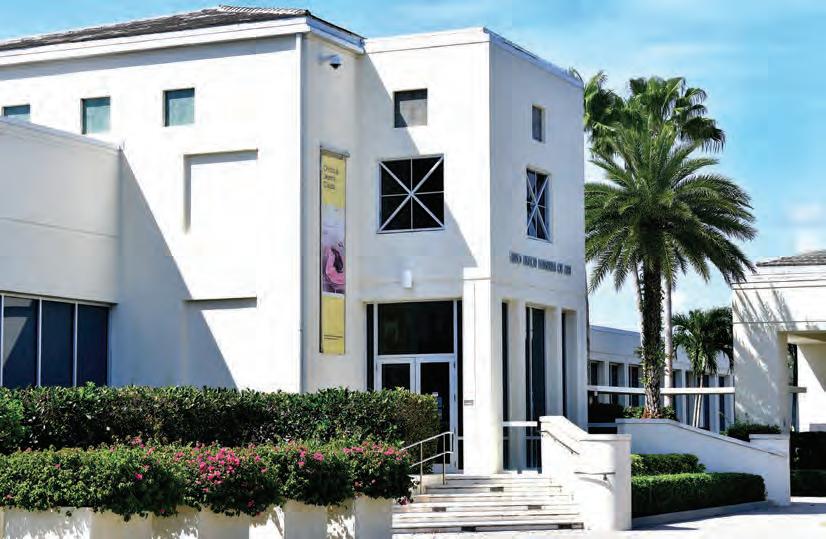
human connection between my clients and the children they will help.
So, what does ChatGPT have to say about the connections created through charitable giving?
The impact of charitable giving transcends mere monetary value. It stimulates a ripple effect, inspiring others to contribute and creating a culture of generosity. Through the power of example, it encourages compassion and kindness, fostering a more empathetic society.
Walk through any of our community’s anchor institutions where philanthropy plays an important role in the organization’s history and ongoing operations. Donor recognition walls

58 VERO BEACH MAGAZINE
INDIAN RIVER INSIGHTS
Inside the front entrance of the Vero Beach Museum of Art, one of the first things you’ll see is the donor wall.
KELLY ROGERS
I see authentic connections between donors that artificial intelligence knows nothing about.
list the names of benefactors whose generosity helped get important things done, such as building a stage at Riverside Theatre, growing a permanent collection for the Vero Beach Museum of Art, or equipping an operating room at Cleveland Clinic Indian River Hospital with 21stcentury medical devices.
Taking a closer look at these lists of names, I see authentic connections between donors that artificial intelligence knows nothing about. One of dozens that come to mind is the special relationship between two clients of mine who met and fell in love after the deaths of their respective spouses. For years, their names were listed within the same grouping of top donors to the Vero Beach Museum of Art, but their introduction came when a mutual friend
hosted the widow and widower at a reception in advance of an exhibit opening. The word they both use to describe their connection means “destiny” in Yiddish. When I see the mutual respect these two have for each other’s pasts, combined with the loving way they spend time together as each other’s “bashert,” there is nothing artificial about it.
What are the tangible improvements that ChatGPT suggests are made possible by charitable giving?
Charitable giving plays a pivotal role in addressing societal challenges. Charitable donations fuel organizations and initiatives that tackle pressing issues such as poverty, education, healthcare, environmental conservation, and more. By supporting these causes, individuals become active participants in shaping





MARCH 2024 59
Choose local. Choose VNA. Call 772.202.8570 or visit www.vnatc.com The Visiting Nurse Association. Helping you enjoy what matters most. Home Health • Hospice • Private Care Whether it’s recovering from a hospital stay, learning to live with a life-limiting illness or you just need a little help at home with daily living activities, the Visiting Nurse Association (VNA) is here for you. Call us today to find out how we can help you get back to enjoying what matters most to you. License# HHA299991281/HHA21276095/HPC5038096 • Hospice License Issued in 1986
between people cannot be replaced with artificial intelligence.
Connections
INDIAN RIVER INSIGHTS
Donors give because they believe in a cause, such as their place of worship or alma mater, or a health care charity.
a better world, effecting positive change in communities locally, nationally, and globally.
In the fall of 2014, I brought my wife and youngest son from Bakersfield, California to Vero Beach for my second in-person interview for the role of CEO of Indian River Community Foundation. On one of our strolls down Ocean Drive, we spied the playground at Humiston Park and walked over to look. After a quick glance at a rickety teeter-totter and a rusty set of monkey bars wrapped in yellow “caution” tape, we opted to skip the potential trip to the emergency room and
continued toward the beach to watch the waves.
One year later, a ribbon cutting was held to unveil the new playground at Humiston Park. The public-private project was made possible with donations collected by a group of mothers organized as Go Play Vero and construction by the City of Vero Beach Parks and Recreation department. Parents, grandparents, and other concerned citizens who rallied to make this playground possible are recognized on engraved bricks, and a monument lists the names of the project’s top donors. I am proud to see Community Foundation listed



60 VERO BEACH MAGAZINE
SAM WOLFE
Above: Former City of Vero Beach recreation director Rob Slezak, founder of Go Play Vero Kelley Della Porta, and City of Vero Beach assistant recreation director Patty Howard were instrumental in getting a new Humiston Park playground (below) installed.

CREATE THE LIFESTYLE YOU CRAVE.



PERSONAL TOUCH. PROFESSIONAL APPROACH. PROVEN RESULTS


Placing a premium on craftsmanship, quality and client care, the award-winning RCL has extensive experience building lifestyles that elevate each homeowner’s vision. With over 50 years of construction capability, our commitment to deliver exceptional homes is renowned for timeless designs, precision and state-of-the-art techniques.
CONSTRUCTION RENOVATIONS DEVELOPMENT 772.234.0140 WWW.RCLDEV.COM

there and continue to point this out as a tangible improvement made possible by charitable gifts, big and small, that have made our community better.
Sure, ChatGPT, there are
other practical benefits that come with charitable giving, such as tax deductions. In my experience, this typically affects what donors give— such as appreciated stock, or when donations are made—
often bundled as one large gift to a donor-advised fund that pays out to multiple charities over several years. However, a tax deduction is rarely the reason why someone chooses to make a donation.
Donors give because they believe in a cause, such as their place of worship. They give to show their appreciation, as when they donate to an alma mater. Grateful patients often give to a hospital or other healthrelated charity for the care
they received or to help others in need to receive the same.
Founders and other dedicated volunteers give to a wide range of organizations to help animals, promote the arts, support education, preserve the environment, or give vulnerable individuals and families needed relief. These acts of generosity tap into a wide range of emotions because of the difference they make.
“Tears of joyness” is the phrase my daughter uses for the contagious laughter that sometimes ensues when she is moved by a stranger’s act of kindness or generosity. There is nothing artificial about that.

62 VERO BEACH MAGAZINE
INDIAN RIVER INSIGHTS




1855 14th Ave, Vero Beach, FL 32960 | 772.257.6036 | www.palmbeachdesignerfabrics.net Fabrics Furniture Accessories
design is the art and science of enhancing the interior of
building to achieve a healthier and more aesthetically pleasing environment. NOWOPEN
Interior
a
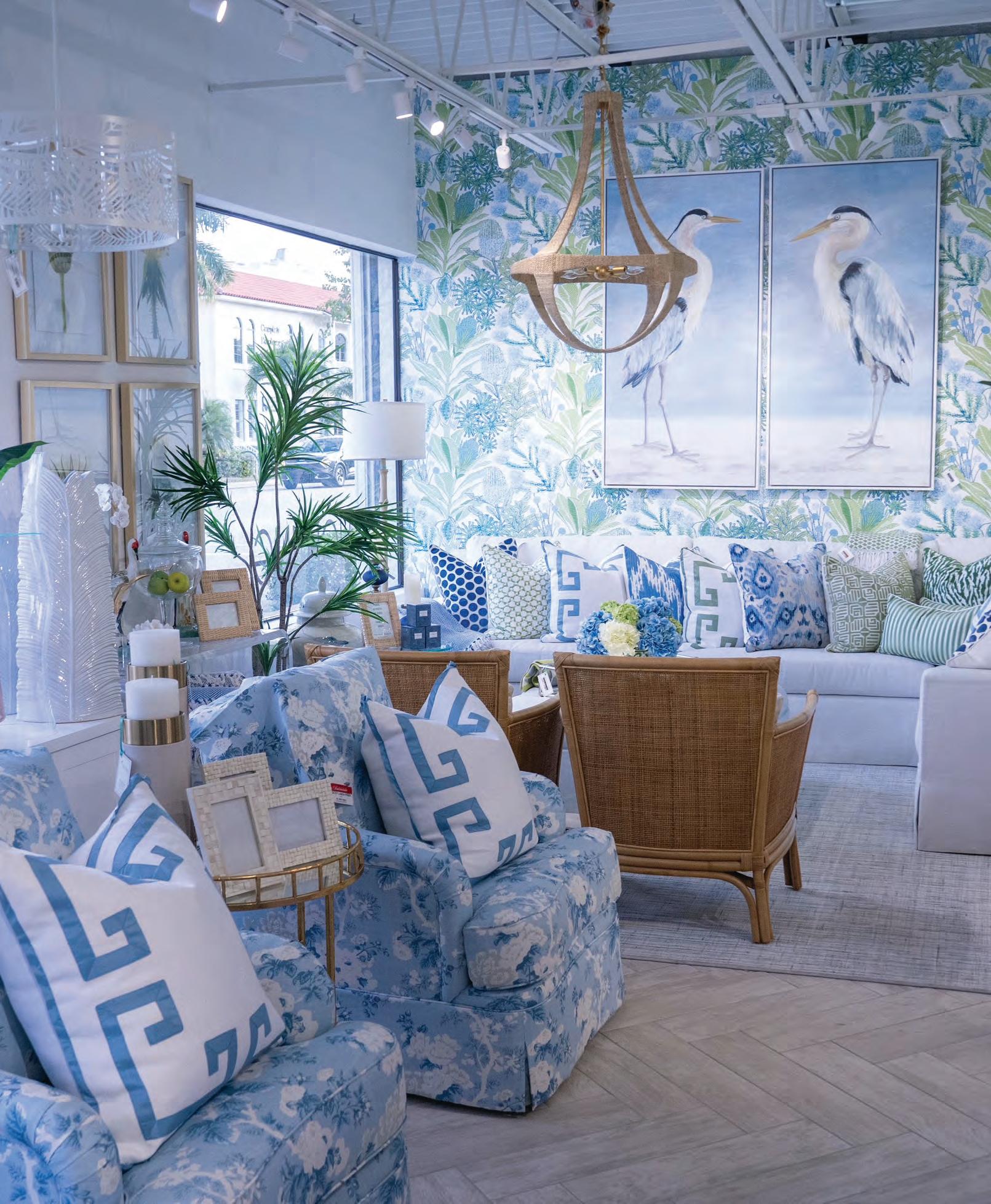

ECONOMY AUTOMOBILES
Winner and Loser
FROM THE COLLECTION OF DARRELL AND CHERYL ZERAN IN VERO BEACH: THE 1950 CROSLEY CD SUPER STATION WAGON
 WRITTEN AND PHOTOGRAPHED BY PATRICK MERRELL
WRITTEN AND PHOTOGRAPHED BY PATRICK MERRELL
The year 1950 was a dismal one for Crosley Motors of Cincinnati, Ohio. It sold only 7,612 vehicles that year, and the road ahead looked worse. The one bright spot for the company came from its tiny new sports car: the Hotshot. At the last minute, a Hotshot was entered in the first sports car endurance race held in the United States, a six-hour event at Sebring Raceway. Although it competed against Ferraris and Fiats, the results took engine size into account, and when the calculations were completed, the Crosley was the overall winner!
Powel Crosley Jr. was a serial entrepreneur and innovator whose first big success came in 1916 from selling automobile parts by mail. His bestseller was Insyde Tyres, a liner he invented to prevent tire punctures. In 1921, he established the Crosley Radio Company, producing a wildly popular line of inexpensive radios. A string of other successes followed over the next 20 years (more about that later), making him one of the most well-known people in the country.
Crosley’s first love was automobiles, however, and in 1937 he built a prototype of a small car
66 VERO BEACH MAGAZINE
This Crosley Hotshot won America’s first sports car endurance race, based on calculations that took engine size into account. The rules were changed for the next race, with the winner being the car that covered the most distance.
CLASSIC CARS
OF THE
COURTESY
CROSLEY AUTOMOBILE CLUB
he nicknamed the CRAD, an acronym of Crosley Radio Auto Division. Luckily, that name didn’t survive; neither did the positioning of the back tires, which were just over a foot apart. In 1939, Crosley Motors introduced its rst production automobile, a spartan convertible that weighed just 975 pounds. It sold for $325 to $350, well below any other American make.






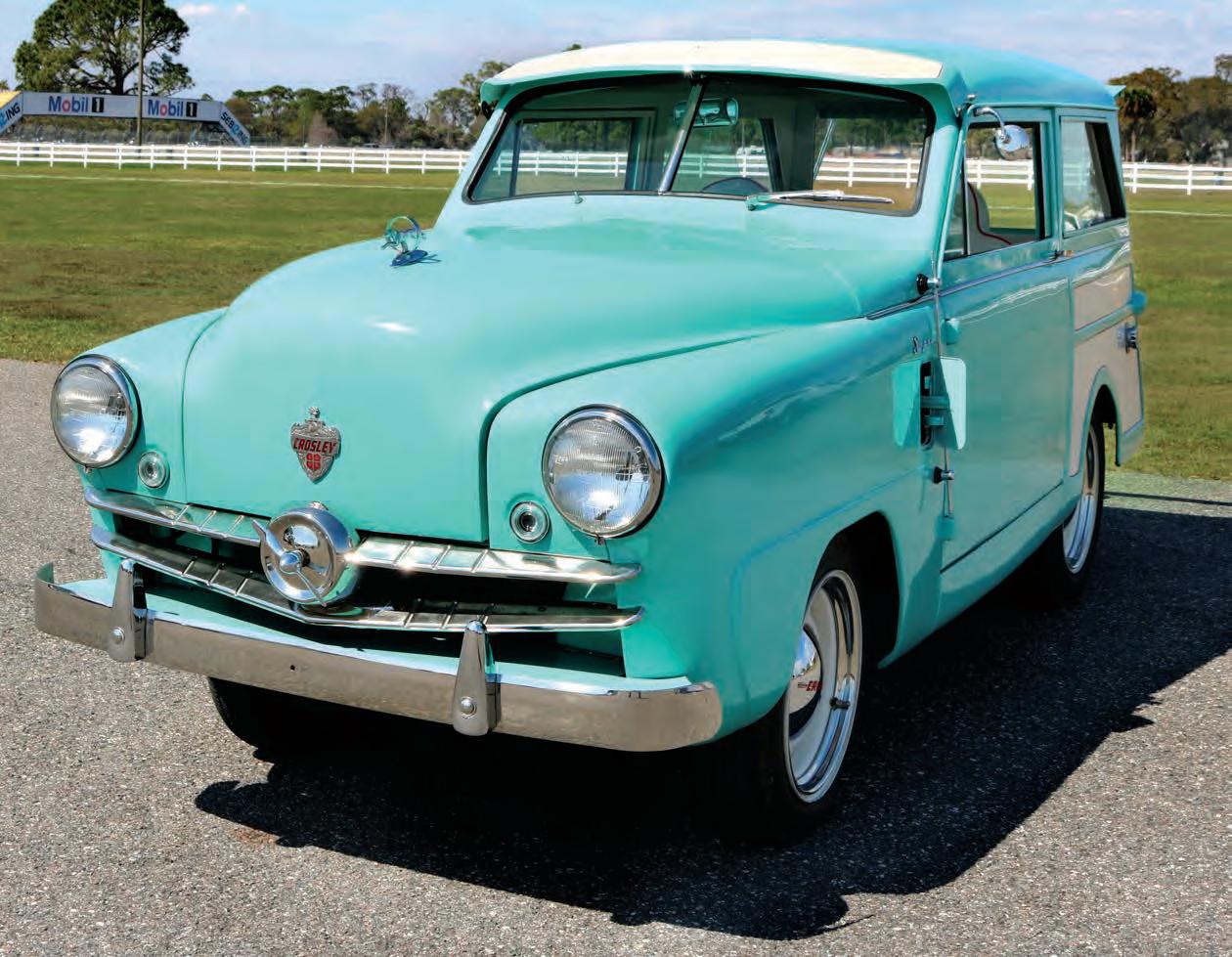 This Crosley station wagon was on display last year at Sebring Raceway, the site of the Hotshot’s moment of glory 73 years earlier. The grille and propeller on this 1950 are from a 1951 model, swapped in when Darrell Zeran restored it. The greyhound hood ornament is an a ermarket item from another manufacturer.
The bestseller in Crosley’s mail-order business
This Crosley station wagon was on display last year at Sebring Raceway, the site of the Hotshot’s moment of glory 73 years earlier. The grille and propeller on this 1950 are from a 1951 model, swapped in when Darrell Zeran restored it. The greyhound hood ornament is an a ermarket item from another manufacturer.
The bestseller in Crosley’s mail-order business
CLASSIC CARS


Below: Even with a

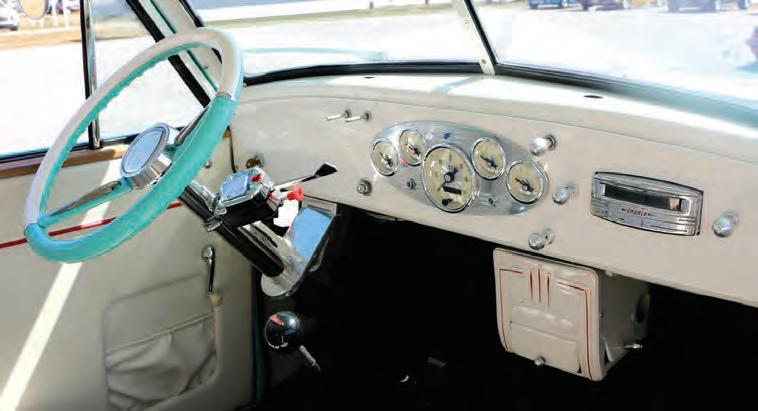
The car was available as a two-passenger coupe or a four-passenger sedan. Both had a tiny 80-inch wheelbase and a two-cylinder engine capable of a top speed of about 50 mph. Customers could buy them at their local hardware or appliance store, alongside other Crosley products.
In 1941, the car line was expanded to include a deluxe sedan, a “woody” station wagon, and two trucks. By the time production was shut down for the war in 1942, Crosley had sold 5,757 vehicles.
After the war, Crosley was one of the first carmakers to offer a new design. It built and sold 5,000 cars at the tail end of 1946; 19,000 in 1947; and, with the introduction of a popular station wagon, 28,000 vehicles in 1948. Unfortunately, it was all downhill from there.
In 1949, the Big Three ramped up production, at long last offering all-new vehicles. Crosley couldn’t compete with the larger, plusher, and more powerful products Detroit was putting out—but that was only half the problem.
After several years of use, Crosley’s sheet-metal CoBra (copper-brazed) engines began to corrode and crack. Customers were furious, and Crosley scrambled to replace the defective engines—and outfit the 1950 models— with a cast-iron design.
Although Crosley hoped the bad publicity would die down, just the opposite happened. The company’s innovative use of disc brakes in its 1949 vehicles proved equally disastrous. Snow and road salt in the winter caused them to lock up, and the alloy parts deteriorated much more quickly than expected.
Sales plummeted over the next two years, and on July 4, 1952, the last Crosley cars rolled off the assembly line.
CROSLEY SUCCESSES
In 1920, when radio was still in its infancy, Powel Crosley Jr. went to buy a radio for his son. Shocked to find it cost $135, he decided he could do better. In 1921, the Crosley Radio Company came out with a model priced at just $7. Other models followed, and within a few years the company had grown into the largest radio manufacturer in the world.
68 VERO BEACH MAGAZINE
The hood emblem (left) was based on the Crosley family crest, minus its motto: “Per Crucem Confido” (I Trust Through the Cross). The trunk emblem (right) includes the Crosley Motors slogan: “A Fine Car.”
cluster of modern gauges on the dashboard, the Crosley’s interior remains spartan. The heater, under the dash, was one of the extras that came with the “Super” model.








In 1922, Crosley established WLW radio in Cincinnati, “the Nation’s Station,” as it came to be known. Its 500,000-watt transmitter, built in 1934, was the most powerful in the world, broadcasting shows that could be heard from Alaska to the Amazon basin. Red Skelton, Doris Day, and Fats Waller were among its on-air personalities. During World War II, its sister station, WLWO, broadcast Voice of America programming.
In 1929, Crosley introduced the Icyball, a refrigeration system requiring no electricity. Although popular, it almost never needed to be replaced, so sales soon began to decline. Four years later, the company had another hit with its patented Shelvador electric refrigerator, the rst to o er storage on the door.
In 1934, Powel Crosley Jr. bought the Cincinnati Reds and a year later held Major League Baseball’s rst night game. FDR ceremonially ipped a switch at the White House as the lights came on at Crosley Field in Cincinnati.
During World War II, Crosley built generators, gun sites and turrets, and several prototype vehicles for the military. Its most important project, however, was helping to produce one of the Allies’ most important secrets: the proximity fuse.
e device, used to detonate shells when close enough to a target, sped up the war in the Paci c. It also played a huge role in thwarting Hitler’s V-1 assault, as well as the German army’s last major o ensive. “ e funny fuse won the Battle of the Bulge for us,” General Patton said.


MARCH
Above: Crosley started producing radios in 1921, refrigerators in 1927, and proximity fuses for use in World War II in 1942.
The lightweight CT-3 Pup was designed for military use, but only 37 were built. The fenders are heavy canvas over wire frames.
This Mule, as well as several motorcycles and the amphibious Duck, never got past the prototype stage.
JOHN LLOYD
JOHN LLOYD


©2024 All rights reserved. Beachland Homes Corp., LIC#CGC1506797, is an independently owned and operated franchise. 407-935-9115 Family Owned & Operated for Over 25 Yrs www.SunShadesofCentralFlorida.com SERVICE GUARANTEE AND MANUFACTURER WARRANTY PROVIDED WITH EVERY INSTALL
Custom motorized retractable shade solutions for privacy, sun and insect control
Offering free estimates for both residential and commercial properties
Custom canvas awnings and canopies

Since 1982 772.589.4994 • 9339 U.S. Highway 1
A
recent
collaboration with Leah Muller Interiors


MARCH 2024 73 92 Coastal Life SPACES | HOMEGROWN | LIVING WELL | BY THE BOOK | TRUE TAILS TRUE TAILS Try teaching your old cat some new tricks.
Area Code
DECIPHERING THE INTRICACIES OF RUG SELECTION CAN UNDERLIE THE REVIVAL OF A ROOM
BY VALERIE CRUICE


Sisal, serapi, jute, or flokati?
Serged, scalloped, taped, or fringed?
Legs on, legs off?
Choosing the right area rug can really tie you into knots. These carpet conundrums roll into our homes at some point. Selecting the right style, the right material, and the right size of an area rug can be as mysterious as Area 51.
Area rugs have warmed floors since ancient times, particularly for nomadic tribes; the earliest known example is the hand-knotted Pazyryk Carpet, discovered in Siberia and dating to 500 B.C.
The word “rug” is thought to be derived from the Old Norse “rokk.” The first known use of the word appeared in England in 1591. Fast-forward to 1950s Lord & Taylor, where carpet designer Edward Fields coined the term “area rug,” describing his new collection for the department store. Seventy years later, Edward Fields Carpet Makers pays tribute to this heritage with a line called “Area by Edward Fields.”
Vero Beach interior designer Rod Mickley calls area rugs “art for the floor.” He prefers wool, says sisal has “run its course” (he’ll throw a dhurrie on top for color), and cites NIBA Designs in Miami as his “go-to.”
A mainstay of the area rug industry is Stark. Founded 80 years ago, the company is now in the hands of its third generation: Chad Stark is CEO, and his cousin Ashley Stark is creative director of the New York City–based business. Last year the cousins cofounded Ashley Stark Home, an omnichannel brand anchored by a collection of area rugs.
74 VERO BEACH MAGAZINE
SPACES DESIGN
Sophistication is important in the home office.
Leah Muller Interiors, the company behind all the decor seen in these photos, ensures a good first impression with this attractive and practical seagrass rug in a client’s foyer.

“Statement rugs are having a moment,” says Ashley Stark, whose designs are inspired by fashion and travel. “We’re leaning into neutral hues paired with touchable textures, proving that simple can make a statement.” In the Southeast, Stark notes, “We’re seeing a high demand for area rugs that are quiet with occasional pops of color. Nature-inspired hues like green, soft blue, and teals also continue to grow in popularity.”
Over 50 years ago, Jafar Falasiri opened Falasiri Oriental Rugs in New York. He and his wife, Barbara, relocated their business to Vero Beach in the 1990s after stints elsewhere in the state. All their rugs are handmade in organic materials. Their Florida Collection, which features both curated and commissioned pieces made by their artisans in Nepal, reflects the coastal aesthetic.
“This collection speaks to the sun, the sand, the verdant landscape; you bring the outside in,” says Barbara Falasiri. The designs are “tone on tone, modern impressionistic, and a lot of painterly style,” she explains. She notes that people are buying larger rug sizes, beyond the typical 8 by 10. “They’re moving to 10 by 13, filling more space with area rugs.”
Size is important when dealing with area rugs. Crystal Lemley of Coastal Interiors says, “The biggest mistake people make buying rugs is that they’re too small.” A living room rug, for example, should accommodate at least the front legs of a sofa and
any chairs should rest completely upon it.
Distance from the wall should be 24 inches in a large room and a minimum of 18 inches in a small one. Jute, seagrass, or sisal work well here. In a bedroom, designers like to see 24 inches all around the bed. Softer viscose or silk blends add extra comfort underfoot.
In a dining area, 36 inches from the edge of the table to the edge of the rug is ideal. Wool, cotton flatweave, and dhurries are good choices for cleaning spills. For hightraffic areas or those with indoor-outdoor function, designers are calling for highperformance rugs, made from recycled plastic, that feel soft and can be hosed down.
So, pile it on with area rugs; you just might be swept away on a magic carpet ride.



From the top: A chevron print adds whimsy and an unexpected art element to the floor; funky patterns elevate a modern room; shag rugs can be fun in a game room or entertainment space.
MARCH 2024 75
Leah Muller Interiors celebrates coastal decor but brings in a muted ticking stripe in the area rug.


HORTICULTURE
Botanical Buddies
HOUSEPLANTS CAN BRING JOY WITHOUT AN OVERWHELMING WORKLOAD
BY NICKIE MUNROE



My friends and family try to encourage me through the winter by giving me new houseplants.
ey are pretty, and my friends are sweet and well-meaning. What am I to do with seven jade plants? e darling friend who repots my African violets when she does hers receives payment in brioche French toast. ey are doing well, and I do not want to jinx it. e rest receive new

digs on their birthdays, so I do not feel overwhelmed.
e bene ts of having houseplants are numerous. ey help clean the air, add a nice ambience to a space, and are lovely to look at. e drawbacks for many who visit my o ce are about the maintenance of the plants. Some people claim all their plants die within three months. ( at’s not bad if you are a snowbird and only need them for a few months.)
Almost everyone who objects to having a houseplant claims it is because they o er room and board to ants, gnats, or other insects. My mission is to help people nd the perfect plant and help them gure out how to have the best relationship with it.
If you are like me, you want to add beauty to a space. It
cannot be high maintenance. ere is so much more to life than managing 13 houseplants. I also travel for work, so they must be okay with me going away for a few days. My favorites to share with others are jade, peace lily, and select herbs for kitchen windows.
I tell my friends to follow a very easy regimen with their new plant babies. ese tips will also work for you:
• Do not water your indoor plants unless there are signs of wilting, or the top 1 to 2 inches of soil are dry. Many people have a watering schedule, and you will eventually gure out that is dependent on the conditions of your home. E cient watering will help keep the plant healthy and reduce the likelihood of insects nding refuge. Ensure all pots with
VERO BEACH MAGAZINE
HOMEGROWN
The peace lily and select herbs are great choices when it comes to gi ing plants.
drainage holes are on saucers to catch excess water.
• Repot the ornamentals annually. Most pest issues develop and remain poorly managed because of soil conditions. Plant health is dependent on soil health. Most potting mixes for indoor plants provide enough fertilizer to last until the following changeover. Select the specialty blend that is right for your plant.
• Pot and plant size relate directly to your ability to manage and handle them. I have only two 12-inch pots inside my house. Most of the others are 6 inches or less. At these sizes, I can do everything I need to do with them independently if required.
Navigating my small house without plants obstructing walkways and taking up limited flat surfaces is also easier.
• Enjoy your plants—place them where they can add to your happiness. In a pinch, using a regular houseplant as a table centerpiece is easy. One of my jades is in a very colorful 6-inch pot. I use it when someone stops by and we have an impromptu tea party.
My indoor plants are unconcerned about whether March allows the winter one last hurrah. As for outside, I remain vigilant until All Fools’ Day. Of course, April comes with its troubles—insects preparing for a resurgence and transitioning my vegeta-

Watering of houseplants should be done when soil is dry, not on a schedule.
ble gardening beds. I will use Florida-Friendly Landscaping techniques for those problems. Bring on the warmth!
Nickie Munroe is an environmental horticulture agent with the University of Florida’s IFAS Indian River County Extension


MARCH 2023 77 Congratulations to the Shambo | Schwibner Wealth Management Group Data and sources for all Forbes awards and their rankings provided by SHOOK® Research, LLC. Past performance is not an indication of future results. For more information, please see www.SHOOKresearch.com. Awards are based on in-person, virtual and telephone due diligence meetings and apply an algorithm that measures best practices, client retention, industry experience compliance records, firm nominations, assets under management and firm generated income. Investment performance is not a criterion. Merrill Lynch, Pierce, Fenner & Smith Incorporated (MLPF&S) is a registered broker-dealer, registered investment adviser, and Member SIPC. Bank of America, N.A., Member FDIC and MLPF&S are wholly owned subsidiaries of Bank of America Corporation. The Bull Symbol and Merrill are registered trademarks of Bank of America Corporation. © 2024 Bank of America Corporation. All rights reserved. | MAP6241592 | 01/2024 Forbes “Best-in-State Wealth Management Teams” list in 2023-2024. Published annually in January. Rankings based on data as of March 31 of prior year. Shambo | Schwibner Wealth Management Group 660 Beachland Blvd. • Suite 101 • Vero Beach, FL 32963 • 772.231.9051 • www.fa.ml.com/shamboschwibner Shambo_6241592_7.75x4.75_ad.indd 1 1/22/2024 11:57:35 AM





Schedule a Membership Tour at GrandHarbor.com 772.299.6623 | Resident and Non-Resident Memberships Available. Now Accepting Applications for Summer Membership.
Father/daughter REALTORS® , each with their own style, sharing a symbiosis that enhances and enriches their individual and collaborative work for their client’s.



2901 Ocean Drive | Vero Beach, FL 32963 | 772-231-6509 OakHarbor-Properties.com Jim Knapp realtor ® 772-913-0395 Stephanie Knapp realtor ® 772-696-6302 40 years as Vero Beach Residents 24 years in Commercial Banking & Mortgage Lending 20 years in Retail Sales, Merchandising, Interior Design, Staging & Photography
years Combined Sales in Oak Harbor, Grand Harbor, the Barrier Island & Beyond
years Combined as the Most Experienced Oak Harbor Sales Agents Offering a Legacy of Excellence
27
16
A Global Mindset For A Community-Driven Brokerage SM

LEARNING
Your Attention, Please!
WITH EARLY DIAGNOSIS AND PROPER TREATMENT, CHILDREN WITH ADHD CAN REACH THEIR FULL POTENTIAL AS ADULTS
 BY RENÁE TESAURO
BY RENÁE TESAURO
We all know them.
The child who cannot sit still or follow instructions. The adult who is constantly distracted and can’t seem to focus on the task at hand. They could be among the more than 6 million children and 8 million adults with attention-deficit/hyperactivity disorder (commonly known as ADHD or ADD).
“I was diagnosed with ADHD
when I was in third grade,” says 32-year-old Natalia of Miami. “My parents had me evaluated at the recommendation of my teachers, who said I was very bright but that I was easily distracted and talked too much in class.”
“There was a stigma about ADHD at the time, and there weren’t many resources for parents and children,” Natalia recalls. “Unlike now, the school
didn’t provide accommodations for test taking and I had a hard a time in the elementary grades, despite having tested as a gifted student. When it came to test taking, I would make careless mistakes because I read through the material very quickly. If someone in the room happened to be tapping a pencil, for example, I became easily distracted.”
80 VERO BEACH MAGAZINE
LIVING WELL

Advocate for your health, and guide you through the system
Take the time, and truly get to know you, and develop a personalized care plan


Discover Why Island Health Concierge

Our Patients Are Saying NOW ACCEPTING NEW PATIENTS
“I truly feel seen for the first time in a long time in the medical realm.”

What CONTACT:
“She even does home visits if you live within a certain distance. Who does that today?”
“I could not be happier with Dr. Latia Ilyadis and her staff at Island Health.”
“She listened and took action!”

Dr. Latia Ilyadis Dual Board certified Pediatrics and Internal Medicine
Medicine is Right for You
“I had been misdiagnosed and mistreated for months prior to Dr. Ilyadis advocating for me and guiding me through the proper specialists.” INFO@ISLANDHEALTHVEROBEACH.COM 772-205-6361 9301 HWY A1A, SUITE 202 ISLANDHEALTHVEROBEACH.COM
Limited space available
Ensure you will receive the proper diagnostics and specialist care
The best way to fix it is to have a doctor who will...

In 2022, more than 10 percent of U.S. children aged 3 to 17 were diagnosed with ADHD, according to the Centers for Disease Control and Prevention. A developmental disorder characterized by ongoing symptoms of inattentiveness, hyperactivity, and/or impulsivity, ADHD has no known cause or cure. However, with the proper combination of treatments, the symptoms can be minimized and managed throughout a person’s lifetime, enabling those who once felt stigmatized by the disorder to become highly functional adults.
“ADHD symptoms have traditionally accounted for the largest number of referrals to child health specialists,” says Joseph R. Feist, PhD, a licensed clinical psychologist who o ers evaluation and therapy for students from pre-K to adulthood at o ces in Vero Beach and Coral Gables. “Teachers would say the incidence is up, but it may
also suggest that more cases are being diagnosed.”
ere are three main types of ADHD, according to Feist, each centered around a cluster of symptoms ranging from mild to severe. People with inattentive ADHD are easily distracted, have trouble paying attention, or have diculty following instructions or completing tasks that require sustained focus. ey may be perpetually forgetful, have trouble keeping appointments

RESOURCES FOR PARENTS
and meeting deadlines, and often lose things.
ose with hyperactive/ impulsive ADHD may have trouble staying seated (as in a classroom), waiting their turn, or engaging in hobbies quietly. ey may talk excessively, interrupt others who are speaking, or act impulsively without thinking about the consequences.
e third and most common type of ADHD is a combination of the two, in

If you suspect your child has ADHD, consult a licensed psychologist, pediatrician, pediatric neurologist, psychiatrist, or nurse practitioner with expertise in the field.
For more information about evaluation services and educational opportunities for students with ADHD, contact the School District of Indian River County Exceptional Student Education Department at indianriverschools.org.


those in need.
which there are symptoms of both inattentiveness and hyperactivity/impulsivity. Regardless of the type of ADHD, the symptoms can wreak havoc on a child’s relationships with parents, teachers, and friends as well as school performance.
“Early detection is the key to treating most attention and learning disorders, and ADHD in particular,” says Feist, who performs detailed psychoeducational evaluations to assess students’ learning strengths and weaknesses, as well as to identify learning disabilities, including the presence and severity of ADHD, or any emotional condition that may be interfering with their education. “If undetected and untreated, these children are often labeled by others as di cult. By addressing their symptoms early, they can avoid a lot of collisions at home, school, and—later in life—with bosses at work.”
Studies show that more

VERO BEACH MAGAZINE LIVING WELL
One of the fi rst steps in diagnosing a learning disorder in children is to evaluate behavior and address symptoms early. School resources are available to
DIVYA HARYANI, MD
DOUBLE BOARD CERTIFIED DERMATOLOGIST AND MOHS SURGEON
Acquired specialized expertise in cutaneous oncology/skin cancer through training at Moffitt Cancer Center, renowned for its leading Cutaneous Oncology Program and recognized as one of the foremost advanced skin cancer and melanoma programs nationwide.
Northwestern University Clinical Dermatology Research Fellowship: pioneered the latest trials in scar therapy and cutting-edge laser technologies
Featured in Women’s Health Magazine, New Beauty Magazine and ABC News
Expertise in skin cancer surgery, pathology and facial reconstruction
Grew up in Vero Beach, returned home to serve her community
ANAND HARYANI, MD, MBA
DOUBLE BOARD CERTIFIED DERMATOLOGIST AND MOHS SURGEON
Completed dermatology residency at the world renowned John H. Stroger Jr. Hospital of Cook County in Chicago, IL
Graduated Magna Cum Laude from Northwestern University
Published research in cardiology, oncology and dermatology at Northwestern Memorial Hospital and Rush Medical Center
Extensively trained in skin cancer surgery and skin cancer pathology
Leading expert in laser aesthetics and cosmetic dermatology
Followed his beautiful wife to Vero Beach and is loving the community and patients here!

YOU NOW HAVE OPTIONS FOR YOUR SKIN CANCER TREATMENT
IMAGE GUIDED SUPERFICIAL RADIATION THERAPY
A non-surgical approach to skin cancer.

Transform your skin cancer care with our revolutionary Image-Guided Superficial Radiation Therapy (IG-SRT), a nonsurgical treatment utilizing low-level X-ray energy to precisely target and eliminate cancer cells, fostering the regrowth of normal tissue. Enhanced by ultrasound technology, our treatment ensures precision, offering a clear insight into the depth of the cancer.
Boasting an impressive 99% cure rate for most early non-melanoma skin cancers.
Learn more by scanning with your phone’s camera!

MOHS MICROGRAPHIC SURGERY
Proven Expertise: Our skillfully trained surgeons are board certified in mohs surgery and have successfully completed thousands of cases, ensuring a level of proficiency and confidence that you can trust.
Gold Standard Treatment: With a 99% cure rate, mohs surgery is the gold standard for treating skin cancer, ensuring the highest cure rates and minimal impact on healthy tissue.
Plastic Surgery: We have expanded our practice by integrating a skilled and board certified plastic surgeon to complement our expertise in mohs
than 80 percent of adults with ADHD are unaware they have it, and anywhere from 35 to 78 percent of people diagnosed with ADHD during childhood have symptoms as adults.
ADHD is a lifetime condition that changes over time, Feist points out. “With children, the biggest challenge is often the con nement that occurs during the rst years of school. ey are made to sit still and study a generic curriculum, which is di cult if they have these symptoms. Our education system is like a giant hourglass. When you’re in preschool, it’s wide open. In grades one through 12, we squeeze everyone to be the same. If children can come
out of that without damage, things open up and get easier in college or the world of work, where individuals have more free time to pursue subjects or activities they enjoy.”
“ADHD can occur in people who are brilliant, average, and below average in intelligence,” Feist adds. Although the causes and risk factors are unknown, research suggests that genetics may play an important role. More than half of children with ADHD have a parent with the disorder. Research has also shown an increased incidence of ADHD among premature and low birthweight babies, babies whose mothers smoked or used alcohol, children with



frontal lobe head injuries, and those exposed to toxins that may interfere with brain development.
Although there is no cure for ADHD, its symptoms can be managed with a multipronged approach, which may include medication; cognitive behavioral therapy; self-control, quieting, and mindfulness techniques; and various proven coping strate-
gies. Treatment also extends beyond the patient: “It’s important to train families to positively intervene with ADHD behaviors,” says Feist. “Parents sometimes threaten, scream, or get frustrated when their children ignore their requests. It’s best to give them the tools they need to promote compliance e ectively and gracefully through self-control techniques or




VERO BEACH MAGAZINE
LIVING WELL Della Porta Cosmetic & Recon structive Dentistry COMPREHENSIVE DENTAL CARE RECONSTRUCTIVE DENTISTRY IMPLANT DENTISTRY VENEERS Committed to Lifelong Dental Health We accept all major credit cards and most major dental insurance. Raymond A. Della Porta, DMD Raymond A. Della Porta II, DMD Scott Elliott, DMD Serving Indian River County For Over 40 Years! 1300 36th Street | Vero Beach 772.567.1025 | drdellaporta.com
reward systems implemented at home or in collaboration with their child’s school.”
Students of all ages who are diagnosed with ADHD can bene t from policies that require schools to be on the lookout for signs of learning disabilities, conduct evaluations, and provide classroom-based behavioral interventions and/or academic accommodations if necessary. Interventions might entail helping the student to better manage classroom behavior or study skills, while accommodations might include extra time or a smaller, quieter location for test taking; preferential seating in the classroom; or





















MARCH
© 2023 ONE Sotheby’s International Realty. All rights reserved. Sotheby’s International Realty® and the Sotheby’s International Realty Logo are service marks licensed to Sotheby’s International Realty Affiliates LLC and used with permission. Each franchise is independently owned and operated. Any services or products provided by independently owned and operated franchisees are not provided by, affiliated with or related to Sotheby’s International Realty Affiliates LLC nor any of its affiliated companies. The information contained herein is deemed accurate but not guaranteed INTRODUCING YOUR E XC E P T I O N A L C U S T O M N E W B U I L D W I T H D O C K , B O AT L I F T & J E T S K I L I F T 3 3 6 L I V E O A K D R I V E | O F F E R E D AT $ 3 , 4 5 0 , 0 0 0 C O M P L E T E LY R E N O VAT E D L A K E F R O N T P O O L H O M E I N I N D I A N T R A I L S 9 0 0 R I V E R T R A I L | O F F E R E D AT $ 1 , 7 2 5 , 0 0 0 9 Both Top 1.5% of all Real Estate Professionals in the United States ranked by REALTrends 9 Both Top 1% of all Realtors® in Indian River County 9 $60M+ Total Dollar Volume Sold 2023 9 Extensive network in the local, regional, and global markets 9 Extensive digital marketing, world-wide property distribution and exposure and exclusive media partnerships 9 Local print advertising in VB 32963, TC Palm and Vero Beach Magazine Sherry Brown 772.633.1472 SBROWNVERO@GMAIL.COM VEROBEACHISLANDREALTOR.COM Sherrie Coleman 772.633.0021 SCOLEMAN@ONESOTHEBYSREALTY.COM SHERRIECOLEMAN.ONESOTHEBYSREALTY.COM S CA N H E R E TO AC C ES S O U R L I ST I N G S & M O R E Island Lifestyle Experts Positive interactions within families can help children learn be er, more controlled behavior.
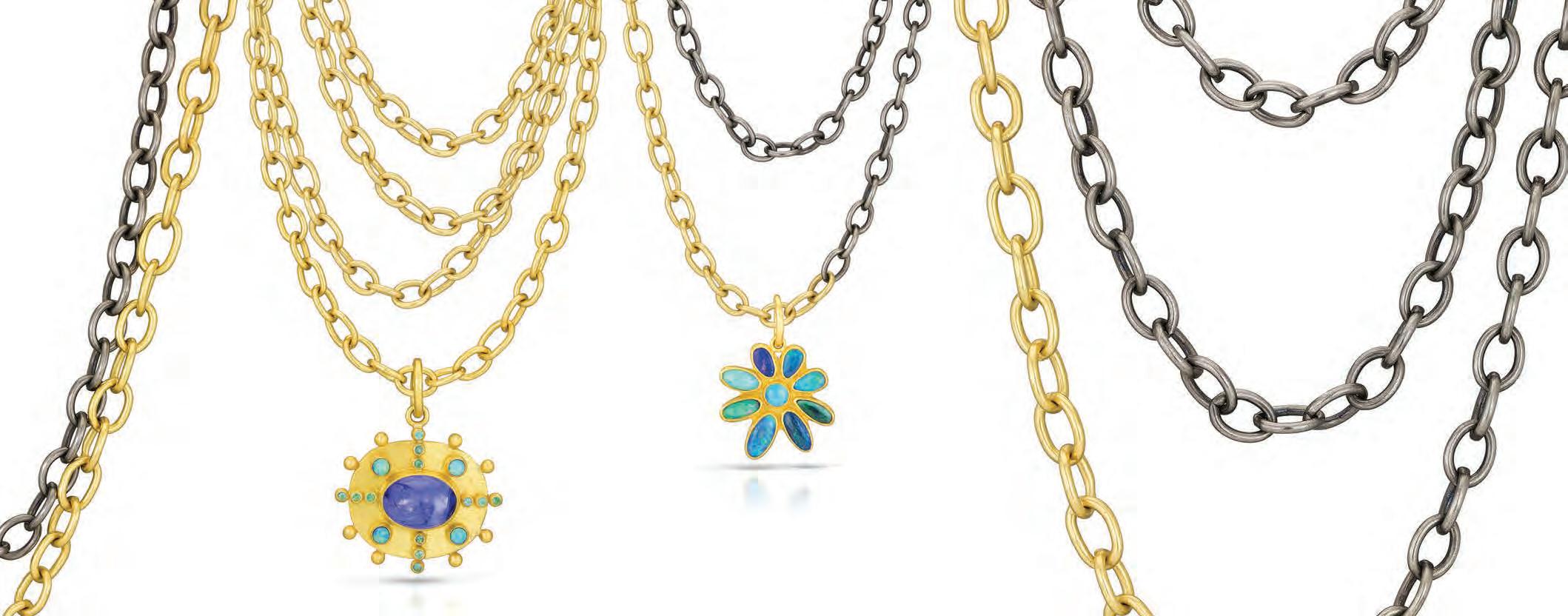

a reduced workload. ese interventions and accommodations, experts say, can help level the playing eld for students who would otherwise be inadvertently discriminated against in a traditional classroom setting.

In Indian River County, resource specialists in public and charter schools act as intermediaries between teachers, problem-solving teams, and parents when a disability is suspected, according to district resource specialist Beth Miller. e school team, which includes parents, reviews all available data to determine what is impeding the student’s learning. is may prompt tiered interventions in the area(s) of struggle, which may include behavior.
If the student shows progress following the targeted intervention, the team may decide to continue those interventions, as they are usually standard practices in the general education tool kit. If the
student doesn’t show progress, the school team may consider a change in the frequency, duration, or type of intervention; an evaluation for either a 504 plan (part of a federal civil rights statute) if the team nds that specialized accommodations are needed due to a suspected or documented disability; or an individualized education program (IEP) if the student requires specialized instruction along with accommodations. e interventions and accommodations are all dependent upon the data and needs of the individual student.
“ e evaluation process includes information provided by the parent, teacher(s), and an assessment by our school psychologist,” explains Miller. “ e psychoeducational evaluation may include observations and rating scales related to ADHD. However, IQ and academics may also be assessed, as many learning disabilities can
VERO BEACH MAGAZINE
772.234.6711
THE LAUGHING DOG GALLERY | CELEBRATING 2910 CARDINAL DRIVE, VERO BEACH
•
THELAUGHINGDOGGALLERY.COM
PREMIER EXPERT IN SKIN CANCER TREATMENT

Monika Srivastava MD, FAAD, FACMS
DOUBLE BOARD CERTIFIED
DERMATOLOGIST & MOHS SURGEON
Monika Srivastava MD, FAAD, FACMS

DR. MONIKA SRIVASTAVA has earned the distinction of being among the first in the nation to achieve certification in the new Micrographic Dermatologic Surgery (MDS) Subspecialty. She is one of the few Mohs surgeons in the country to achieve this outstanding level of recognition, and this certification continues to solidify her expertise as one of the premier surgeons in this procedure. Dr. Monika specializes in Mohs surgery and advanced reconstructive techniques.
FELLOWSHIP TRAINED MOHS & RECONSTRUCTIVE SURGEON
Specializing in the prevention, early detection, and treatment of Skin Cancer, as well as Cosmetic and General Dermatology
TRAINING
Harvard Medical School
NYU Department of Dermatology
Georgetown University
SUPERFICIAL RADIATION THERAPY (SRT)
Trust your care to the experienced radiation experts on staff, having treated hundreds of patients. A proven, non-surgical method of treating some non-melanoma skin cancers such as basal cell carcinoma or squamous cell carcinoma PAINLESSLY.

Johns Hopkins School of Medicine
Brown University
EDUCATION PROFESSORSHIPS
Assistant Clinical Professor
Columbia Medical School
FELLOWSHIPS
Fellow of American College of Mohs Surgery
Fellow of American Academy of Dermatology
Fellow of Florida Society of Dermatology, Dermatological Surgery
Expert in Melanoma and Skin Cancer, with over 20 years of experience and has completed over 30,000 Mohs, dermatologic and laser surgeries
ACCEPTING NEW PATIENTS
MOHS SURGERY | SKIN CARE SERVICES | COSMETIC PROCEDURES | DERMATOLOGY 1600 36th Street ∙ Suite B ∙ Vero Beach, FL 32960 ∙ 772-567-1164 ∙ www.SelectSkinMD.com PLEASE ASK DR. MONIKA IF THIS IS A TREATMENT OPTION FOR YOU.
present with characteristics resembling ADHD. If parents suspect their child has a disability such as ADHD, they should contact their local school for assistance.”
Natalia was initially put on medication to manage her symptoms, but she didn’t like the way it made her feel. Fortunately, a reevaluation by Feist made her eligible for accommodations that were available by the time she entered high school. Natalia took full advantage of extended test-taking time; testing in a quiet, distractionreduced setting; teachers’ office hours; and peer-to-peer tutoring. She captained the robotics team, played varsity
sports, and started a group that made medical missions to the Dominican Republic.
By the time Natalia entered the University of North Carolina at Chapel Hill, where she also received educational accommodations, she had developed more coping skills and study mechanisms. For example, she credits the Pomodoro Technique, which involves breaking work into 25-minute intervals with fiveminute breaks in between, for helping her to stay focused during long study sessions.
After graduating with bachelor’s degrees in psychology and nursing, Natalia worked as a critical care nurse, a school nurse, and, during
“Early detection is the key to treating ... ADHD in particular.”
– JOSEPH R. FEIST
COVID, a traveling nurse. Now in graduate school studying to be a nurse practitioner, Natalia says that a nursing career suits her strengths perfectly. “I could never work in an office job, sitting at a desk for 12 hours a day,” she admits. “To be a nurse, you need to be able to do several things at once and work under pressure. I’m never bored. I’m constantly challenged, and it’s ideally suited for me!”
“For most people with
ADHD, the world of work affords opportunities to find something they can do versus something they can’t,” observes Feist.
Today, Natalia feels 100 percent in control of her symptoms, thanks to her own self-awareness and the coping mechanisms she has acquired during her lifetime of living with and learning about ADHD. Plus, she has something very positive on which to focus—her December wedding!

88 VERO BEACH MAGAZINE 3355 Ocean Drive LyraHome.com 772.257.4777 Mon - Sat 10am - 5pm
LIVING WELL

ADVANCED CANCER CARE IN VERO BEACH
When faced with an illness like cancer, we band together. And the team at the Scully-Welsh Cancer Center at Cleveland Clinic Indian River Hospital has your back. From routine screenings and advanced cancer treatments to comprehensive support services, we’re with you on this journey. For every infusion and follow up. For every step of the way. For every care in the world. Complete cancer care is close to home.
Learn more at ClevelandClinicFlorida.org/Cancer or call 877.463.2010 to schedule an appointment.
Cleaning Up Crime
AN UNCONVENTIONAL HOTEL MAID INADVERTENTLY BECOMES AN ASSET TO LAW ENFORCEMENT
BY ELIZABETH LEONARD OF THE VERO BEACH BOOK CENTER
THE MYSTERY GUEST
by Nita Prose
If you loved The Maid, Nita Prose’s debut novel starring the endearing Molly Gray, you will be just as delighted with this second installment in the Molly the Maid mystery series.
As head maid at the five-star Regency Grand Hotel, Molly finds herself, yet again, in the middle of a scandalous murder investigation after guest speaker J.D. Grimthorpe, a mystery writer, collapses to the floor in front of an audience, dead as a perfectly shined doornail.

Grimthorpe had drawn hundreds of diehard fans, many of whom bordered on obsession with the author. As police try piecing together the crime, Molly inadvertently becomes the best witness and eventually the sidekick of her onetime accuser (in The Maid), Detective Stark, because Molly knew Grimthorpe long before his untimely death at the Regency Grand.
Narrated by Molly, the story unfolds from the perspective of a person with autism. Her unique mind interprets everyone around her literally, leading to some awkward but humorous exchanges that make her one of the most innocent and lovable characters I have ever had the pleasure of reading. Despite the humility she feels regarding her condition and station in life, she knows her duties and takes pride in her work, and sometimes a little in herself.
Molly’s love for cleaning and perfecting the world around her, instilled in her by her Gran, is expressed with such solemn respect it almost seems like a sacred act or an art. All I know is that I couldn’t wait to clean my house after I finished The Mystery Guest. (Maybe my kids should read it too.)
If you haven’t yet read The Maid, you may wish to do so in order to become familiar with Molly and the backdrop of this engaging series.
STAFF PICKS

RED STRING THEORY
by Lauren Kung Jessen
In this romantic novel, artist Rooney Gao believes in the legend of the red string, an old Chinese belief that everyone is tied to their true love by fate. After questioning this theory herself, she meets skeptic Jack Liu.

BEST-LOVED FOLKTALES OF THE WORLD
by Joanna Cole
This collection of 200 folktales, originally handed down orally from generation to generation, offers a window into dozens of cultures spanning the globe, in a way that perhaps no other art form can.
90 VERO BEACH MAGAZINE
BY
THE BOOK REVIEW






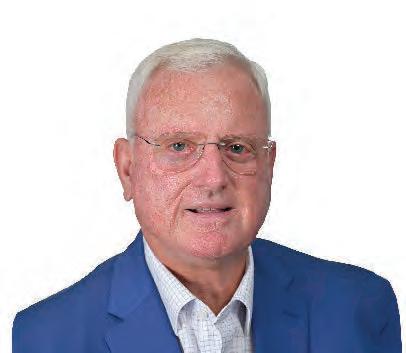

2901 Ocean Drive Vero Beach, FL 32963 GRANDHARBORPROPERTIES.COM Diane DeFrancisci resident realtor ® | gri 772-538-1614 Brenda Montgomery realtor ® | gri | cren 772-532-4170 Martin Carder broker associate resident realtor ® 772-696-0131 Buyers are moving here to enjoy the Grand Harbor lifestyle. Call us anytime for information on these fine properties or to list your home. Wood Duck | 2/2 | $475,000 Harmony Island | 2/2 | $450,000 Harbor Point | 3/3 | $1,300,000 Harbor Village Riverfront | 3/3 | $1,100,000 Your Grand Harbor Neighborhood Experts!

TRAINING
Smarty Cat
TRY TEACHING YOUR OLD CAT SOME NEW TRICKS
 BY AMY ROBINSON
BY AMY ROBINSON
Cats are thought to be mysterious, unknowable, and perhaps a bit disdainful of us, their human roommates. These assumptions add to their enigmatic reputation, but cats would beg to differ. They want us to know that they are clever, interactive, trainable, and possess excellent problem-solving skills. Just ask them.

Cindy Wold, owner of A Dog’s Life daycare, is certainly a dog person. Prizes and photos from her agility champions line the walls of the lobby. “I like cats,” she says. “I don’t understand them, but I like them a lot.” Her two rescued cats, Tater and Spud, are informal greeters at A Dog’s Life and have interesting side jobs: they model for
pet product photo and video shoots at Chewy, the leader in e-commerce sales of pet products. This requires a level of control on set that most cat owners would envy.
The feline duo is foodobsessed, which is Wold’s control mechanism. Her cats will interact with dogs for photo shoots, be nice to human actors, and even wear
92 VERO BEACH MAGAZINE
TRUE TAILS
Tater is one of two feline greeters at A Dog’s Life daycare in Vero Beach.

costumes like pros as long as food is involved. “‘People food’ is their primary goal,” says Wold. “Spud is relentless; he will try to use his nails to grab something off my plate. If I hold a bite of food away from him, Tater will jump up out of nowhere, snatch the food right out of my hand, and exit in a flash,” she laughs. “Yesterday, they ate my entire chicken Caesar salad, lettuce and all.”
Wold is in a position to observe and affect the behaviors of both cats and dogs at work and at home. “With my cats, it’s more about taking their normal cat behaviors and encouraging those, marking those with a cue and reward,” she says. “Anything that the Chewy crew wants Tater and Spud to do on set generally comes from their toolbox of normal behaviors, such as reaching up to something with a paw, watching something, showing interest in something.”
Far from being unknowable and distant, Tater and Spud are engaged with their human and their surroundings, but does their relentless snack seeking mean they are smart? A peek inside a cat’s
brain reveals that the cerebral cortex is larger and more complex compared to that of dogs. This is the part of the brain that rules information processing, action planning, the interpretation of language, and memory.
Cats will also spend more time solving a problem than their canine counterparts. Take the cat that learns how to smack the treat jar onto the floor so that it pops open, and when the same jar is then hidden inside a cabinet, that clever cat will spend hours or even days learning to open that cabinet so he can toss the jar onto the floor all over again.
“Cats learn by association and by consequence, just as dogs do,” notes Zazie Todd, animal expert and author of the popular books Wag and Purr. “People don’t think of them as trainable, but they absolutely are.
“Most people have already trained their cats to do a few things, perhaps without realizing it. If you take the treat pouch from the cupboard, and the cat hears the rustling of the pouch or even the cabinet opening and comes running, then you are training the recall.


3,864
2,144
578
562
6,860
3,024
43,334
95%

MARCH 2024 93
PAWSITIVE IMPACT
Many cats can be trained using food as a motivator.
Ask Amy
amy@verobeachmagazine.com
My mother is moving in with me and my playful dog, Bingo. He and I like to wrestle a bit on the floor and play some tug, but I am worried that he will try to treat my mother in the same way. When Bingo is bored and wants to play while I am working in my office, he signals this by wrapping his mouth around my wrist. I’d like him to stop that but it is an ingrained habit for both of us. What should I do?
– Riley in Vero Beach

Good for you for addressing this now instead of after your mother moves in. Look at the situation from Bingo’s point of view: he mouths your wrist and you react by looking at him. Success! Bingo got your attention, but that doesn’t mean you should ignore it and let him gnaw on you until he gets tired. Make a food puzzle toy for him. Stuff a toy made for this purpose with a bit of cream cheese or canned dog food along with bits of kibble, or make your own: an empty paper towel tube with kibbles inside and the ends folded shut. Have it on your desk, and when he starts mouthing, say “Leave it,” then take the food toy and place it at your feet. The message is that mouthing does not equal play. He can be with you, but when you are occupied, he must entertain himself for a bit. You might also get a gate for your office so he doesn’t try his toothy overture on your mother.
I like to walk my dog, Star, with my friend and his dog in the afternoons. It is a good social time for the dogs, and we enjoy it too. His dog walks with a prong collar and is very well behaved. My friend suggested one for Star, since she does pull to the point that my back gets sore. It looks kind of mean, but should I try it?
– April in Wabasso

My approach is to use different equipment for different circumstances. A prong collar is great for this type of walk, in which you would like to chat with your friend and have the dogs enjoy each other’s company, and for the veterinarian’s office or other places where you need extra control. That being said, you will want to work with your dog first on that collar before attempting a longer walk. Avoid applying steady pressure; that will be uncomfortable for Star. Instead, the leash should be mostly slack, but when she starts to pull, give her a command like “Wait,” and then you stop completely. When she turns to see what the delay is about, offer a treat so she has to circle back to you to get it. The reward happens when she stops and the leash gets slack. Rubber tips on the end of the prongs will make you feel better about using this collar, and a bandana hides it from opinionated neighbors.
94 VERO BEACH MAGAZINE TRUE TAILS

Take me home for 3, 6, or 12 months. Love me forever.
Become a puppy raiser with Southeastern Guide Dogs and open a world of magic to those with vision loss, veterans with disabilities, and children who need a best friend.
Your mission as a puppy raiser is simple. Take home a cuddly bundle of joy and bring back a happy, socialized, well-mannered dog. That’s the magic of making a difference.
✴ Choose your own adventure: The joys of puppy raising are endless, but the time commitment doesn’t have to be. Raise a puppy for 3, 6, or 12 months! You can even share the journey with family, friends, colleagues, and more.
✴ Take a paws: Have a getaway planned? Take the vacation or well-deserved break. Our puppy sitters jump in and take the leash.

✴ Just add love (+ food and water): We’ll take care of the rest. Puppy raisers receive a kit stocked with all the necessities to raise a happy, healthy pup. Plus, we cover all veterinary care and medical expenses.

Unleash the fun! We’ll support your puppy-raising adventure from start to finish—no matter where you live in the United States.
Be a part of the magic . Raise a puppy.

GuideDogs.org/pup
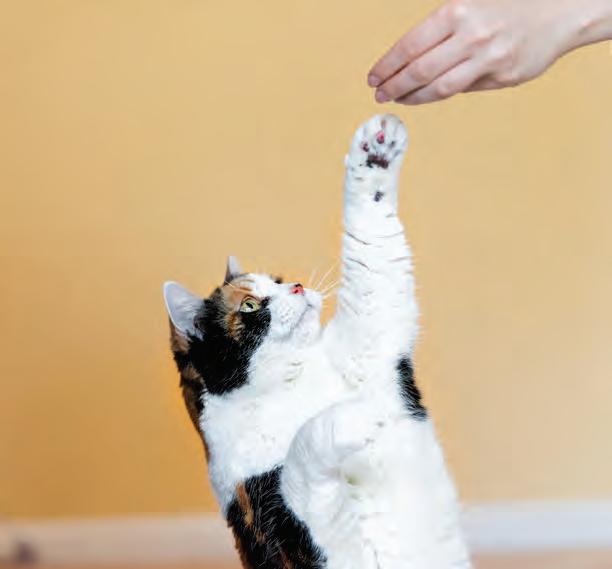
“Owners can further de ne this behavior by calling ‘Come,’ or just calling the cat’s name, and then rustling the treat pouch. e cat hears the cue word, then the treats being handled, and comes when called. In this learning process, you are trying to make the contingency really clear.”
ere is a perception that cats do not have the innate desire to please that dogs have, which makes them harder to train.
“ at is a sweeping generalization,” says Todd. “Some dogs appear to want to please, but they are learning by consequence.” Dog lifts paw adorably, person delivers pets and rewards. e assumption that dogs are slaves to our desires whereas cats couldn’t care less about us prob-
ably stems from the miniscule amount of time we have spent training them as compared with time spent training our dogs.
“Cats don’t have that history of going to class that dogs do, so we don’t have that reference point,” Todd adds, “but they can learn some fun behaviors, like sitting up, since they naturally sit on their haunches in the grass to look around.” Cats are inquisitive, so following a target stick with a catnip toy or treats stuck to the end may allow you to lead them into another room or even into an open carrier for those necessary trips to the vet.
Tater and Spud have informed Cindy Wold’s thinking about cats. “ ey really do have untapped potential,” she says. “Cats thrive on interactions with their people,

VERO BEACH MAGAZINE
TRUE TAILS
Aligned with your goals Sophisticated, personalized wealth solutions designed to preserve and protectyour legacy. Glenmede 222 Lakeview Avenue, Suite 1160 West Palm Beach, FL 33401 PRW-ADV-026-Z01 Contact us today Mark R. Parthemer Mark.Parthemer@glenmede.com 561-571-4917
Muster all of your patience to start cueing cute tricks with your cat.
but often don’t get enough and then behavior problems can come up. Dogs are easier to predict; we know that retrievers want to hold and fetch and terriers want to go to ground, so we can make assumptions about their genetic hardwiring. We don’t really have that information about cat traits that match their breed, but we know the behaviors we will see if we show the proper stimulus.
“In training, we are trying to get them to react predictably to a trigger, be it their name,
our hand signal, or similar cue, and then o er play or treats as payment for behavior we have asked them to do.”
Muster all of your patience to start cueing cute tricks with your cat. What is she good at already? Jumping up to high places? You can cue that with “Up!” and place a treat in her favorite spot, then pretend not to care if she does it or not. If the treat is gone later, you win.
Does she like to reach up with a paw to investigate things? Try sticking a treat to a little smear of cream


cheese on a spoon, then raise it in front of her just over her eye level. If she rises up on her haunches or lifts a paw, choose a word to mark that result and let her lick the goodies. Your cat may even start to initiate these minisessions with a pointed meow or just by looking at you. is overture is an open door to a real bond with your cat that is ful lling for both of you.

In general, cats have not been as well trained as dogs; their learning potential hasn’t been tested.


MARCH
772-774-8449 dandyliongiftsandthrifts.com Mon–Sat 10am–3:30pm Follow Us! 1605 10th Ave Vero Beach Across from Tambourine


We are donating $500 per closing to the Humane Society of Vero Beach. BETHANY BURT & MELINDA PAMPALLONA Realtors® and animal lovers 772.766.4926 | 772.696.0819 1105 22nd Street | Vero Beach, FL 32960 772.569.5522 | www.elmoreinteriors.com Owner of A Shade Better for 38 years Lampshades | Lamps | Lamp Repair | Home Furnishings



WE’VE GOT OPTIONS! Visit our showroom when planning your next project.

Dealer & Installer of
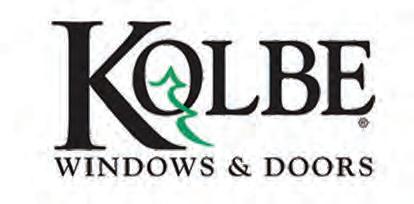
Kolbe is known for their superior quality and innovative designs.



Timeless 5099 NORTH A1A VERO BEACH, FLORIDA 32963 772-234-4427 LICENSE #IBF000165 www.spectrumvero.com CONTRACTOR: GIARDINA CONSTRUCTION SPECTRUM PROJECT MANAGER: SHELLY CRAFT PHOTOGRAPHER: © NICK SARGENT
Pop the Cork!
BRITTANY SWARTZ & STEVEN THOMPSON TIE THE KNOT IN A GARDEN ON THE EMERALD ISLE
BY ANN TAYLOR PHOTOGRAPHY BY IRINA DUANE
“Do you ever feel like you’re home, even though you’ve never been there before?” asks Brittany, recalling how she felt five years ago when she and a friend visited Ireland, the land her great-grandfather called home.
While venturing up the west coast, the two women stopped in the small village of Glengarriff in County Cork, where they were told that before going any farther they needed to visit Garnish Island, known for its beautiful gardens.
“I didn’t really go there with any expectations, but I was blown away! It was so spectacular! Everything just happened to be in bloom, and I knew immediately that I would love to be married there one day,” says Brittany, recalling the aha moment that stayed with her while waiting for Mr. Right to appear.
Make that reappear.
Throughout high school and college, Brittany had dated a classmate named Steven Thompson; however the two took different paths after graduation. Thanks to mutual friends, they met again 15 years later and sparks flew.
“It was basically instantaneous!” Brittany enthuses. “Steven told me after he kissed me for the first

102 VERO BEACH MAGAZINE

MARCH 2024 103
Expansive views from Bantry House provide a dramatic backdrop for this couple’s wedding photographs.

104 VERO BEACH MAGAZINE
The gardens at Bantry House underwent extensive renovations in the late 1990s, with more planned for the future. It’s a popular venue, open for events during the warmer months of the year.
“It was an absolutely incredible experience; I wouldn’t trade it for the world.”
— BRITTANY SWARTZ THOMPSON


time—again—that he was going to marry me, and he did!”
It took awhile. Steven moved to Vero Beach to be with Brittany in 2020. While she was busy managing the Farmers Market Oceanside, his IT work took him on the road. They were like two proverbial ships passing in the night.
Then COVID hit. The Farmers Market shut down, the road trips stopped, and Brittany and Steven found themselves together 24-7. Without missing a beat, they put their heads together and created the Farmers Market Drop-off, an online marketplace and delivery service that kept customers supplied with their favorite products and market vendors in business.
It was a win-win with an added bonus, as Brittany happily points out: “Steven and I learned that living and working together in such a high-stress scenario actually made us stronger and better as a couple, and in ’21 Steven proposed.
MARCH 2024 105



“When we started talking about where we wanted to have our wedding, I said, ‘I know just the place. Garnish Island.’ Steven loved the idea, but we were really nervous about what it would cost. What sealed the deal was we learned it was so affordable to get married in such an absolutely stunning fairy tale setting.”
With that decision made, wedding plans kicked into high gear, then came to a screeching halt when Brittany’s father passed away. “We pushed the date forward a year, giving me time to grieve.
“I think the thing Steven and I hung onto during that time was that the goal for us was to get married surrounded by those we love. My dad passing away really highlighted how important it is to cherish each other and make memories with our loved ones while we can.”
The 12-month delay resulted in losing the Garnish Island venue, so, sight unseen, they selected nearby Bantry House, a historic estate where hillside gardens abounding with rare flowers and statuary overlook Bantry Bay.
“We had never been there; we’d just seen photos, which were beautiful, but you never know if they’re going to match real life. In this case they did,” Brittany notes happily.
“We stayed with our guests at the historic Eccles Hotel, which is very elegant, very old-world, and we had the reception there as well. The hotel coordinator was wonderful. I can’t sing her praises enough. She was with us every step of the way and helped with so many things,” says Brittany, adding that making the arrangements
106 VERO BEACH MAGAZINE
Clockwise from left: The bride surrounded by Bantry’s gorgeous gardens; the ring; Sarah Tobias, Shina Liu, Brittany, Justina Gioia, Hannah Schoenfeld


long distance wasn’t always easy, considering the fivehour time difference and communication delays.
Yet, slowly but surely, things fell into place.
“Britt had done a lot of hunting to find the perfect photographer,” Steven points out. “It seems the trend nowadays is to have high-contrast photos, but we wanted photos that captured us. Britt had found an amazing photographer we clicked with right away during our intro phone call.”
Brittany cites another example: “I had never met my florist before the wedding. She ended up having a family emergency, so I didn’t really have a chance to finalize things, but as it turned out, the flowers were absolutely stunning.”
“Our videographer called the day before the wedding saying he had just come down with chicken pox, so we
MARCH 2024 107
Brittany and Steven said their vows overlooking Bantry Bay in Ireland on May 3, 2023.

went with a backup one. We just trusted that at the end of the day it would all work out—and it did!”
“Actually, every single vendor we worked with was amazing,” adds Steven. “They all over delivered, and on top of that, they were really kind, wonderful people.”
That included the seanchaí, a traditional Irish storyteller, who charmed guests with colorful tales about Irish history and love
stories during the cocktail hour after the rehearsal dinner.
“I had a hard time finding a storyteller,” says Brittany. “There are only about seven official ones in all of Ireland.
“They play an important role; in some remote places of Ireland they didn’t get [electrical] power until the late ’70s or ’80s, so people would gather in the pubs and tell stories. We wanted our guests to have a
connection to Ireland.”
After their May wedding, Brittany and Steven traveled with their guests to Galway, the Cliffs of Moher, and Dublin before heading off on their honeymoon in Italy, where their first stop was Rome, then Lake Como. They lasted three days in Northern Italy. “It rained almost the entire time we were there; everything was soggy and sloshy,” Steven groans. “We were supposed
108 VERO BEACH MAGAZINE

to finish in Venice, but it just kept pouring, so we returned to Ireland to continue our honeymoon.”
Much of their trip was spent behind the wheel of a car in order to get from point A to point B. Oh, the tales they love to tell.
“We had some amazing adventures, like driving down mountain roads that were one lane for two-directional traffic, then making a wrong turn,” says Steven,

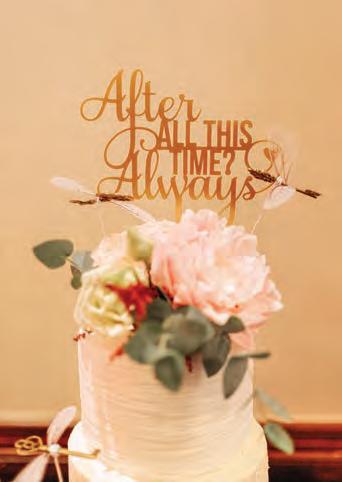

the designated driver, as he recalls more than a few near misses. “First of all, in Ireland they drive on other side of the road; second, I was driving a manual. A lot of the narrow roads have switchbacks and rock walls, so you’re busy shifting while passing within inches of other cars.”
“We drove through mountains in pitch dark and fog, and the directional signs for switchbacks were so intense, they looked
like spaghetti. Everyone was squealing,” laughs Brittany, recalling a white knuckled memory.
She and Steven have many more memories shared with those they hold dear in a country they have grown to love. Given the opportunity, would they do it over again?
Brittany doesn’t hesitate. “Yes! 100 percent! It was an absolutely incredible experience; I wouldn’t trade it for the world.”
MARCH 2024 109
Left and above: The gardens, created by Richard White in the 1800s, include seven terraces.
Top: Simple and elegant details adorn tables during the reception at the Eccles Hotel.
A Noble Decision

TERRY STOUGH CHOOSES TO PRESERVE HIS FAMILY’S LAND LEGACY IN A WAY THAT WILL BENEFIT US ALL
BY CHRIS FASOLINO PHOTOGRAPHY BY SAM WOLFE
You might feel as though you’ve stepped back in time, into Florida’s frontier past. A barbed wire gate opens onto a narrow pathway through a cattle pasture. It leads to another gate and an even narrower path, this time through dusty green scrubland. Wildflowers blossom amidst the long grass, attracting varied butterflies: gulf fritillaries with glistening silver iridescence; monarchs, renowned for their continental migrations yet seemingly at home here; even a queen butterfly, far from an everyday sight, with its amber wings marked by white spots as if from an artist’s paintbrush. As you walk a little farther, the trees take over—majestic live oaks and ancient, elegant cypresses.

110 VERO BEACH MAGAZINE
Top: Terry Stough and his dog Red visit the Land Trust property, an heirloom of the Stough family. Above: Terry’s grandfather, Roy Stough Sr.; father, Roy Jr.; mother, Marian; grandmother, Nellie; uncle, James Stough; and a young Terry with sister Barbara Ann.































“This was a transaction that made everybody feel good.”
— KEN GRUDENS

Le : Terry Stough’s grandparents built a home on a nearby parcel of land a er their arrival in 1918. It no longer stands. The communications involved in the 1940s property purchase show a personal touch characteristic of the times.












Now under their welcoming canopy, you have stepped from the blazing sun into the quiet and restful lighting that exists only in a forest. A blackwater creek meanders its way through the lush vegetation.
You feel as if you are far away from the busy, noisy, and troubled world of the 21st century. And this place is going to stay that way. It is, in a sense, a gift.











e 36-acre property is just south and west of the Sebastian city limits. For its previous owner, Terry Stough, it is a living heirloom, as it had been in his family since the 1940s. Now, Stough has refused lavish o ers from developers who wanted to buy the property; instead, he has chosen to sell it to the Indian River Land Trust. Since the price he will get from the Land Trust is only a fraction of what the developers were o ering, this is indeed a gift as much as it is a sale. He is making the choice so that the site will be preserved in all its natural beauty.




Standing under the cypress trees and listening to the soft murmuring of the creek, Stough recalls how the history of the property and his family history go together. His grandparents moved here more than a century ago, in 1918. His grandfather’s family was from Alabama and his grandmother’s from North Carolina. ey built a homestead on a property nearby, where his grandmother would wash clothes in the creek. She spoke of seeing Seminoles washing their clothes nearby and said they would just look at each other and continue their work. Stough’s wife, Maribeth, says of his grandmother, “She lived to be 96, and she had so many stories.” Stough himself smiles sharing the Seminole story and says, “Believe it if you want!”




With the next generation came citrus. “My dad planted a grove here in 1949,” Stough says. ere were red grapefruits, white grapefruits, navel oranges, and Valencia oranges, along with about a dozen tangerine trees.
e property also hosted festive occasions over the years. “When I was 12 years old, we had a big family reunion—all my kinfolk from Alabama and North Carolina—and we came here,” Stough recalls. e creek had a one-plank bridge back then. “You’d walk across, one person at a time, and it would wobble.”

The family fished frequently in the creek, and one of Stough’s uncles once caught an eel. “He told us it was an electric eel, and he chased my sister and me across the field with it.” Stough laughs at the memory.
When greening became a widespread plague on the citrus industry, the orchard was lost, and the land was leased to a family friend who pastured Florida longhorn cattle there. The scale of the horns could be quite impressive. “You wonder how they can hold their heads up,” Stough marvels. “One had horns longer than I can stretch my arms—and it was a female!”
The area near the creek is rich in wildlife, and the family has always been appreciative of that. They have often seen deer here, and, Maribeth notes, “There are lots of owls.”
As befits his interest in the preservation of nature, Terry Stough served as a park ranger for years at Fort Pierce Inlet State Park. So when the developers came calling for the family property, he was definitely not interested. “All the development around here just breaks my heart,” he laments. “You wonder where all the animals are going. Gopher tortoises, foxes, maybe even some of those scrub jays—where are they going?” From

MARCH 2024 113
Old Florida scrub, including oaks and cypress trees, cover part of the landscape of the Stough property donated to the Indian River Land Trust.

this heartfelt concern and empathy, his arrangement with the Land Trust was born.
And it was certainly a welcome one. “This was a transaction that made everybody feel good,” says Ken Grudens, executive director of the Land Trust. The creek on the property flows into the St. Sebastian River, which, Grudens notes, is “a unique river. It has species of globally rare fish,” as well as manatees, alligators, heron rookeries, and the gar—a spear-shaped fish that is considered a living fossil. Furthermore, the St. Sebastian River is a major
Left: Terry Stough and Ken Grudens peruse the property. Below: An elusive queen butterfly finds nourishment in the property’s rich plant life.

tributary of the Indian River Lagoon. Protecting the Stough property, with its creek and forests, helps to protect the St. Sebastian River, complementing other trails and conservation areas nearby and forming an area called the St. Sebastian River Greenway. Grudens adds: “It also fits in with our new strategic plan of looking at a wider variety of properties and areas. And of course, with anything that drains into the lagoon, we’re protecting the lagoon.”
Plans for the Stough property include its eventual


“Every time I think about my decision, I get happier. I know my dad would appreciate it.”
— TERRY STOUGH
114 VERO BEACH MAGAZINE

opening for public access, with trails, boardwalks, observation decks, and interpretive signage. Partners with the Land Trust on this undertaking are the Friends of the St. Sebastian River, the City of Sebastian, and Indian River County.
The St. Sebastian River is classified as a blackwater stream; its color is caused by tannins leaching from leaves along its forested shores. This color is also apparent in the creek on the Stough property, as it flows beneath cypresses that have stood since before Europeans settled in this part of North America.
No wonder Terry Stough looks at the property with an expression of peace on his face. “A few dollars here and there don’t much compare to this. Every time I think about my decision, I get happier. I know my dad would appreciate it. He loved nature, and I reckon it’s a family tradition.”

MARCH 2024 115
Terry and Maribeth Stough were told many stories by Terry’s grandmother about life in Indian River County many years ago.

Giving Limits the Brush-Off

ARTIST AND TEACHER DAWN MILLER OPENS HER HEART AND HOME FOR THE VILLAGE ARTS VB INITIATIVE
BY ANN TAYLOR PHOTOGRAPHY BY STEVEN MARTINE

Dawn Miller loves Wednesdays and Thursdays. Actually, she loves every day of the week, but these two are the best, as that’s when adults with special needs excitedly open the door to her yellow woodframe house in Vero’s Art Village in the historical Edgewood neighborhood. Here, they will create works of art, prepare a nutritious meal, and engage in tasks that foster self-sufficiency, social skills, and community engagement.
Their nonstop smiles say it all, with Miller’s the brightest of the bunch.
“The Village Arts VB program started incubating three years ago when my friend Sue DePalma, a mom of a special needs daughter, told me about a program for special needs adults where they use farming and community engagement to promote similar goals.
“I thought, ‘Why can’t we do something like that here—something that’s more art based?’ Then I wondered where we would do it and I thought, ‘Why not my house?’ I was already teaching art classes here, so it wasn’t a giant step. So we started a nonprofit, formed a board
Left: Dawn Miller leads the group in preparing for the day’s gathering. Right: Miller enjoys the front porch of her Art Village home with furry friend Ellie.
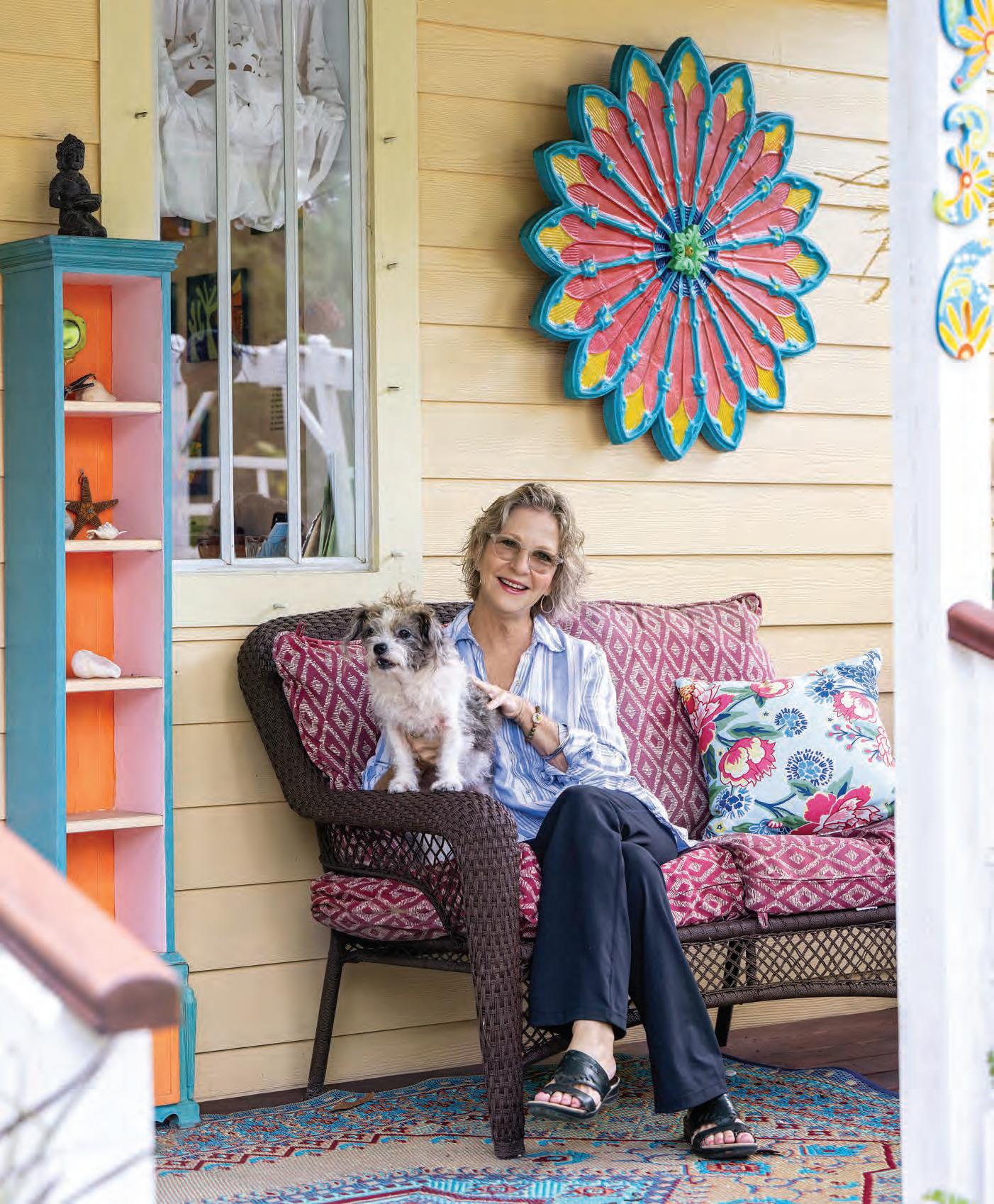


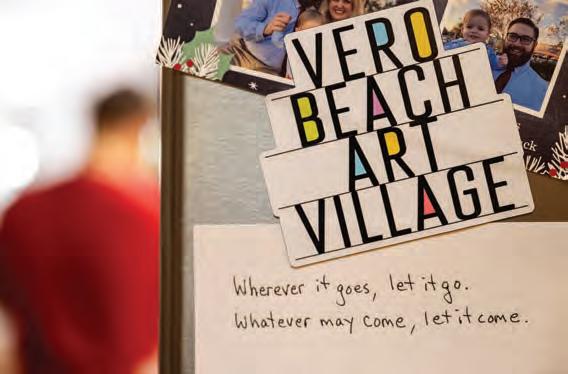
“I didn’t plan any of it; opportunity just showed up and I said yes.”
— DAWN MILLER

of directors, went through all the hoops, and here we are.”
Miller leads the way into what was once the living room and is now an open studio where tables, easels, and art supplies await enthusiastic students whose painting prowess can be seen lining walls, windowsills, and shelves, and even hanging from the ceiling. Bursts of color on canvas bags, silk scarves, and fence posts are just the tip of their creative iceberg.
“Wednesdays and Thursdays are full days, as up to seven students are here for three to six hours. They come in, sign up, and declare what their personal goal is for the day. Then it’s nonstop. I have two wonderful volunteers for each three-hour class, and I couldn’t do without them.
“Everything we do is aimed at increasing their independence and social skills. The art making is the vehicle we use to improve these goals. We do a lot of painting; we also work with clay, beads, fabric, even coconuts.” Miller looks upward, indicating a colorful school of coconut “fish” swimming overhead.
“Then we have lunch prep, which is a lot of fun,” she continues. “The stu-
dents set the table, we go over table manners, and they help with the cooking, learning safe and sanitary cooking skills. We started with things like English muffin pizzas and grilled cheese sandwiches. Now, we’re getting fancy with chicken quesadillas and spaghetti and meatballs with garden salad! We give them options and let them choose, which is important, as so many things in their lives are out of their personal control.”
“This program has helped me communicate much more explicitly,” says Miller, smiling as she recalls a particular instance. “I had asked one of the students to pass me a cookie, and she did: she threw it at me. So I learned to say, ‘Pick up a cookie and hand it to me, please.’”
After the dishes are washed, the floor swept, and trash taken out, it’s time for music and a choreographed dance routine in the backyard that has everyone swaying and moving to the beat. The energy level soars.
Next comes what Miller refers to as service jobs, a way for Village Arts participants to think of the needs of others. One student gives Miller’s rescue pup, Ellie, treats; another
118 VERO BEACH MAGAZINE
Above and left: Miller works with her students. Right: Caregiver Kayla Woodworth assists Elizabeth with sketching.


gives the laid-back pooch a bath; one waters garden plants; another fills the birdbath. At the end of their time together, there’s a sense of accomplishment and sheer joy.
The joy level was off the charts this past October when their artistic creations were showcased in Art at the Emerson’s “Celebrating Special Needs Village Artists” exhibition and reception. It was standing-room only.
If you had told Miller that one day she would own a house where others would come to nurture their inner artists, she would have called you crazy. While art was an important part of her life when growing up on Maryland’s Chesapeake Bay, she graduated with a psychology degree, went on to earn a master’s in biology, and became a trained facilitator and mediator dealing with crisis management and child custody cases—a far cry from her artistic roots.
That all changed when Miller moved to Vero Beach and began teaching classes at the Vero Beach Museum of Art 15 years ago. Since then she has taught students of all ages and skill levels at a number of other locations, including the Alzheimer and Parkinson Association of Indian River County, Senior Resource Association, Indian River Estates, and in her home.
“I didn’t plan any of it; opportunities just showed up and I said yes,” Miller smiles as she reflects on the past and the path that brought her




“What I value, what makes me truly happy, is service to other people.”
— DAWN MILLER
to where she finds herself today, living and teaching in a storybook cottage with a yellow mailbox and a blue-and-orange Village Arts VB sign out front.
“I had been living down the street and keeping my eye on this cute little house,” she explains. “The minute it went up for sale I knew it had to be mine. The first thing I did after I bought it was paint the dark chocolate brown walls a cheerful yellow. It opened everything up. I also added front and back porches to create more outdoor living space.
“Another thing—I love to garden, and there was a big backyard, but it was nasty,” she says, wrinkling her nose.

120 VERO BEACH MAGAZINE
Right: After sketching on canvas, art student Peter plans his latest creation. Below: Caregivers and volunteers pitch in to help students.
“Let’s just say it needed a lot of work.”
Once the yard was cleared, Miller added flower and vegetable beds, fruit trees, and sitting spots. Later, once the Art Village neighborhood was rezoned, she built a small house that is rented as an artist’s studio and gallery or a living space. As Miller points out, “Its use is always evolving.”
Over the years, Miller, whose preferred medium is soft pastels, has won numerous awards, most recently first place in the “varied techniques” category at the A.E. Backus Museum’s “Best of the Best 2023” annual juried art show. Her portrait of an elderly woman appearing lost and confused, titled Where Am I? Are You There? is a poignant reminder of the effects aging can have, and a reflection of Miller’s experiences working with individuals who are memory challenged.
“I used to travel all up and down the East Coast and teach art classes, but it wasn’t as fulfilling as some of the other things I was doing or wanted to do,” Miller admits. “Then I went to a women’s conference where we were given play money and we got to bid on what we value the most. While most of the younger women bid on something materialistic, I realized that as I age, what I value, what makes me truly happy, is service to other people, and that’s what I want to be doing. There’s a deep contentment and gratitude in coming to this place in my life.”
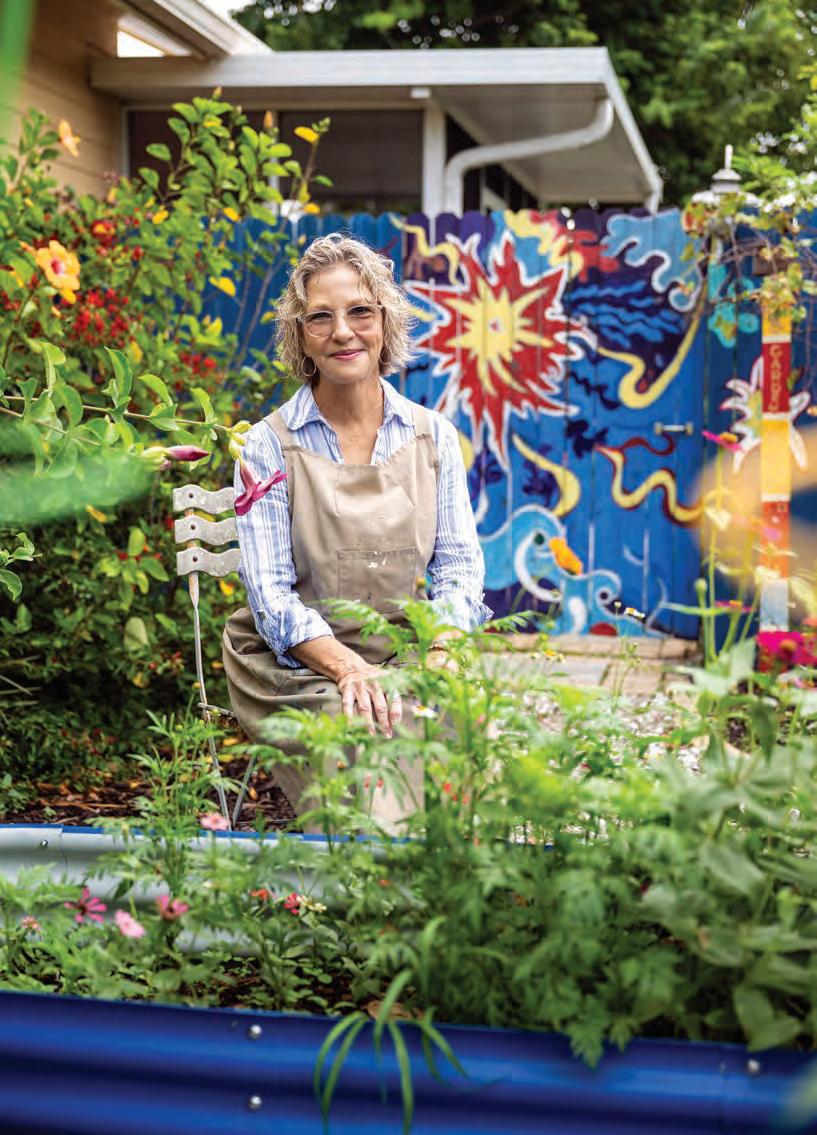


MARCH 2024 121
Above: Miller’s garden is filled with colorful flower and vegetable beds, bright murals, and places to sit and reflect. Left: Peter is the first to show off his painting.

Playland with a Purpose
A COUPLE’S SEASIDE CABANA WELCOMES WHAT THEY VALUE MOST: FAMILY, NATURE, AND PHILANTHROPIC CAUSES
BY RENÁE TESAURO | PHOTOGRAPHY BY LAUREN RUBENSTEIN
The parcel of land on South A1A sat vacant for almost five years, awaiting its destiny. But destiny works in mysterious ways, and what emerged from the ground up was unlike anything Kris Trustey had envisioned when she and her husband, Joe, purchased the lot along with the adjacent oceanfront estate in April 2015.
“We originally thought of installing walking trails around it, as a place of meditative

respite after losing our son the prior year,” says Trustey. But, three months after they purchased the property, tragedy struck again: Joe and the couple’s 18-year-old daughter, Anna, were killed in a plane crash.
Through the ensuing weeks, months, and years of grieving and continual healing, Trustey eventually found new love with Sean McGraw, a former priest and professor at the University of Notre Dame and now a recurring
MARCH 2024 123
Kris Trustey and Sean McGraw developed a shared vision for the property next to their home that turned it into a place of peace and reflection.


visiting professor of political science at Boston College.
Following their marriage in 2019, the couple took a fresh look at the vacant lot with the idea of creating a cabana that welcomes the things they hold most dear: family, nature, and their philanthropic causes. To execute their vision, they turned to Mark Sartain, owner
of Sartain and Associates landscape architecture, and Page Franzel of Page 2 Design, who had fine-tuned the interiors of the main and guest houses.
“Knowing that the structure would be a small component of the entire property, we brought in the landscape architect at the beginning rather than at the end of the project,” explains
Trustey, to achieve architectural continuity with the main and guest houses. “We spent considerable time with Mark and Page thinking about the possibilities that could be incorporated into the overall design of the property and structure.”
Both nature lovers, they shared the main objective of creating an indoor-outdoor space in which to experience both the ocean to the east and the sunsets to the west. The result would be a place for healing with resort-style amenities.
Before the shovels went into the ground, a significant amount of fill was added to raise the elevation of the lot in relation to the adjacent prop-
erty and create walkways connecting to the main house and driveway. Two years and many brainstorming sessions later, the vacant lot was home to a 2,600-square-foot cabana; a large patio area with firepit and pergola; a great lawn for games and outdoor gatherings; a 25-meter, infinity-edge lap pool; a tennis court and pavilion; an outdoor grilling area; and a regulation-size bocce court.
“Kris is a CPA, so she values balance and symmetry,” says McGraw. “The blue tennis court, blue tile on the pool, and blue ocean create this perfect symmetry with the natural environment. It was fun to watch Kris and Mark work collaboratively to make sure that the center of
124 VERO BEACH MAGAZINE
Above and left: Kris Trustey worked with landscape architect Mark Sartain on the layout of the property, with an eye toward symmetry and balance. Right: The patio is an inviting area that can seat guests around a firepit.
SAM WOLFE
SAM WOLFE



the cabana is perfectly aligned with the center of the firepit, the center of the pool, the center of the tennis court, and the center of the oak tree nestled in the parking area.”
Even the pergola at the front of the cabana lines up directly with the view from the dining room of the main house, he points out.
“I was honored to be invited to the table and have an opportunity to work on this project, from its initial thought bubbles to its completion,” remarks Sartain. “Page
126 VERO BEACH MAGAZINE
Winding paths from the home on the south property lead to the cabana.
Right: Colors incorporated into the interior were chosen to reflect the tones in the cabana’s natural surroundings.

has a real talent for spatial design, and RCL Development did a fantastic job executing the technical details. It’s easy to give an architect credit, but the multitalented tradespeople make it happen, and I owe them a huge sum of gratitude.”
What’s unique about the result, according to Sartain, is that there are quiet, intimate spaces within the large-scale compound, making it feel spatially right whether there are
two or 200 people there. “I’ve worked on at least 300 projects in Vero Beach and this one ranks among the very top.”
The cabana is designed to be totally open to the outdoors, with screens that can be lowered from the porches at the flick of a switch as well as quadruple retractable pocket doors on both east- and west-facing sides. The interior includes a large open gathering space with a generous
seating area, a dining table that seats 12, a fully functional chef’s kitchen with granitetopped island, and a rear bar area leading to the outdoor grill and bocci court.
“Kris and Sean were very emotionally connected to this project and, therefore, very involved in its creation,” says Franzel. “I considered it a personal endeavor to make a perfect retreat for them in every sense.”
Trustey and Franzel collaborated on tile and granite selections for the kitchen and bath; creative backsplashes fashioned out of mother-ofpearl, abalone, and brushed stainless steel; custom furniture, lighting, and accessories; and a palette of warm beiges and subtle colors inspired by Mother Nature.
“I enjoy all kinds of decor, but I especially love tranquility and peace,” says Trustey. “I
MARCH 2024 127

wanted something that allows me to breathe easily. The ocean changes color all day, and the colors in here blend seamlessly with the outdoors.”
To complement the white oak engineered hardwood floors, Franzel applied an acid lime wash to the soaring oak ceiling and interior mahogany doors. She designed a pair of ceruse oak built-ins on either side of the conversation area to house large-screen TVs, and
remote-controlled retractable solar shades were installed to soften the effects of the bright morning sun.
Trustey and McGraw are quick to point out that it was intentional not to include bedrooms in the cabana. “We want it to be a shared space,” Trustey says.
“I know what I like and don’t like,” she adds. “But to make it all come together, that’s where Page came in. She did a good job of listening, right
down to the idea for the two TVs,” which provide the perfect opportunity for checking in on football or March Madness scores amidst all the outdoor activities.
“It’s a bit of a playland,” smiles Trustey, adding that McGraw’s buddies have affectionately renamed the property “Splendida Fundida” from its original name, Splendida Dimora. It’s a playland with a purpose.
“Creating ‘a gathering space for
128 VERO BEACH MAGAZINE
In addition to color choices, the idea of bringing the outdoors inside is enhanced by the retractable pocket doors on both the east and west sides of the structure.

“This space is an invitation into the light and a place for healing.”
— SEAN MCGRAW
good’ was central to the overall design of the cabana,” says Trustey, who, with McGraw, generously supports several philanthropic causes through personal giving and their family foundation.
“We wanted this space to be a place for meaningful conversations about important issues,” says McGraw. “We care about mental health and education. In this serene, quiet, safe space you end up having those kinds of honest conversations. Everyone has had darkness in their lives. This space is an invitation into the light and a place for healing.”
Trustey and McGraw can attest to the healing power of their cabana by the sea. “It’s a great integration of indoor-outdoor living that truly reflects our lifestyle,” says McGraw, who swims or jogs in the pool daily. “Bringing the outdoors in gives us peace and a sense that we are part of something bigger than ourselves.”
“The nice thing about having the property for a number of years is that we had the opportunity to think about what we wanted and what would work best,” reflects Trustey, who says the cabana has become a daily respite from their busy lives when they’re in residence from January through May. “We leave our work behind in the main house and love coming over here to sit by the firepit with a glass of wine. We enjoy watching the sunset as it reflects off the ocean and sets over the river.”
“Kris makes fun of me because I never want to leave,” chuckles McGraw, but Trustey admits she’s making progress.
“I finally convinced him to go out to dinner!”

MARCH 2024 129

OPPORTUNITIES GOLDEN
130 VERO BEACH MAGAZINE

FOR BARBARA DU PONT, UNFORGETTABLE PHOTOGRAPHS ARE BORN OF PATIENCE AND LIGHT
BY TERESA LEE RUSHWORTH PHOTOGRAPHY BY BARBARA DU PONT
Barbara du Pont is not a daredevil. She is a composed, elegant widow, mother of two, grandmother of five, and co-owner of an art gallery. But anyone who thinks she wouldn’t brave 40-foot seas en route to Antarctica or hop into an open Land Rover in the wilds of Botswana in order to capture the wonders of nature with her camera would be mistaken.
Well, the 40-foot seas are probably behind her at this stage of life, but even after visiting nearly 20


MARCH 2024 131
Clockwise from above: The Perfect Perch , leopard, South Africa; Barbara du Pont at home; Brotherly Love , lions, South Africa
SAM WOLFE
“Photographing animals in the wild takes patience and a little bit of luck.”
– BARBARA DU PONT
countries on all seven continents, du Pont is far from finished. It’s not that there are places she has never visited but longs to; it’s just that her photographer’s eye is keenly aware of the endless possibilities. “It’s always different,” she says of her returns to familiar locales and subjects.
Du Pont and her late husband, Hal, traveled to South Africa and Botswana, their two favorite destinations, two or three times a year to photograph the intriguing wildlife. Hal had been enamored of the African landscapes and their inhabitants since childhood, having been introduced to the exotic continent on family vacations, and Barbara joined him in that fascination. She even identifies a particular smell with Africa, one that she finds captivating.
Barbara du Pont is one of Gallery 14’s eight artist-owners, the only one whose art


 Above: Baby Tempo, African elephant, Botswana
Left: Wild Dog , African wild dog, South Africa
Opposite page: A Bit of a Stretch , serval cat, South Africa
Above: Baby Tempo, African elephant, Botswana
Left: Wild Dog , African wild dog, South Africa
Opposite page: A Bit of a Stretch , serval cat, South Africa

form is photography. She was there at the gallery’s beginning 16 years ago, a milestone that also marked her foray into selling her work.
Her interest in photography began when her first husband, an avid surfer, asked her to stand on the shore and take pictures of him in action. As her knowledge and skills developed, she discovered a love for the art of photography, and she has never looked back.
The New York native relocated to Vero Beach in 1983 and married Hal in 1997. By then, film was being supplanted by digital technology, freeing photographers from the constraints of a limited number of exposures, and the couple embarked together on the adventure into the excit-
ing new possibilities. Their first excursion using digital equipment was to South Africa. “We always brought a laptop so we could review the photos at the end of the day,” she says.
Mother animals with their babies are one of du Pont’s recurring themes. Her favorite animals? Elephants, “because they’re so intelligent,” she explains.
Between Africa trips, Barbara and Hal toted their cameras to Ireland, Scotland, Italy, Spain, Portugal, Holland, Japan, and many other destinations—always during the off-season, so as to minimize the number of accidental photobombers and “competing” photographers. In Holland, the celebrated tulip gardens took center
stage. In Italy, gorgeous landscapes and some architectural subjects filled their viewfinders. Despite having been to Italy four or five times, du Pont would like to return and photograph more scenery; she finds the winding, tree-lined roads of Tuscany particularly appealing.
But wildlife will always be du Pont’s first photographic love. The sheer variety of species and behaviors is compelling. She has photographed the famed “snow monkeys” of Japan on several occasions, a project that entails a winter journey to an elevation of nearly 3,000 feet in the Nagano Prefecture, where the Japanese macaques are known to lounge in the local hot springs. These monkeys are accustomed to the
MARCH 2024 133
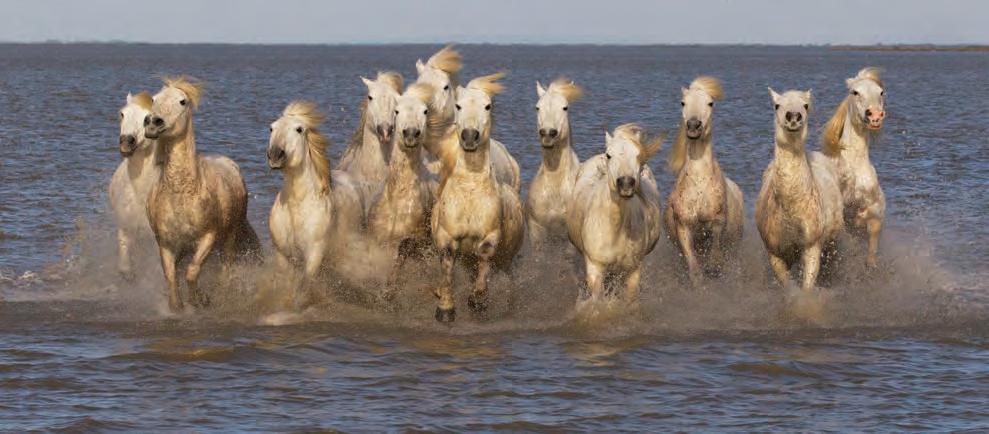
presence of their many human visitors, to whom they are largely indifferent, since feeding or touching of the monkeys by guests is strictly prohibited.
In the Camargue region in the South of France, herds of wild horses roam free on the beaches, and, knowing (or at
least hoping) that the horses will sidestep them, photographers position themselves in front of the galloping animals. This approach probably feels more dangerous than it actually is, and it results in some breathtaking images.
The dynamic, unpredictable nature of
Left: Running on Water, wild horses, France
Below: The Oakum Boys , juvenile king penguins, South Georgia and the South Sandwich Islands
wildlife is no doubt part of the allure for both artist and viewer; animals demonstrate no limit of poignant, amusing, and even perplexing behaviors. But not all creatures are acclimated to human proximity, and a certain danger is inherent to any expedition into the wild. Du Pont has

134 VERO BEACH MAGAZINE

had a few brief brushes with peril, but she seems to consider them all just part of the journey.
Her eldest grandson, Jake, “quite the photographer himself,” accompanied her on safari twice as a preteen, having apparently inherited his grandmother’s spirit of adventure in addition to her photographic prowess. “He was even chased by a hippo while sitting in the front of the Land Rover, in the tracker’s seat,” du Pont relates. “It was pretty scary, since the hippo came out of the bush unexpectedly. The driver put it into reverse and we were soon safely out of its way.”
One of du Pont’s most terrifying experiences was traversing the Drake Passage— the deep, treacherous waterway between South America and Antarctica—in a 400foot Russian icebreaker.
Several geographical and meteoro -
logical factors make this 600mile stretch of sea among the most tumultuous on Earth; it is not unusual for travelers to encounter 40-foot swells and gale-force winds, and even the most intrepid seafarers have been known to succumb to seasickness. Du Pont was no exception.
But she made it to Antarctica, her remotest destination to date, where she photographed the small but spunky Adélie penguins. While there, she also boarded a small, inflatable Zodiac boat to approach and photograph the impressive leopard seals that, alas, feed on the aforementioned penguins. Such is the circle of life.

On the virtually uninhabited island of
South Georgia, the British territory on which Ernest Shackleton is buried, du Pont photographed the larger and more colorful king penguins, whose juveniles are referred to as “oakum boys”—a nickname bestowed by 19th-century sailors
MARCH 2024 135
Above: Trusting Each Other, Japanese macaques, Japan
Right: Not Far Behind , African elephants, Botswana


who thought they resembled the color of oakum, the material used to pack the seams and joints of their wooden boats.
At the planet’s opposite extremity, du Pont’s lens found itself zooming in on the polar bears of the Arctic Circle—creatures so ferocious that the tourists leaning over the boat’s rails to snap photos were ordered to stay back 5 feet after one of the bears managed to lunge up the side of the hull, snatching and tearing a man’s pant leg. “Luckily,” du Pont says, “he had several layers on, and it just ripped the outside waterproof pants.”
Yes, fortitude and a sense of adventure are key characteristics of zealous wildlife photographers. But, du Pont says, patience plays the biggest role in getting the shot. “Photographing animals in the wild takes patience and a little bit of luck,” she says. “Being in the right place at the right time is an old adage, but it still rings true.
136 VERO BEACH MAGAZINE
Above: Vista View, king penguins, South Georgia and the South Sandwich Islands Left: Golden Spar, polar bears, Arctic Circle
“We always had our own driver, so that we could follow any particular animal for as long as it took to get the best shot. Waiting for the golden light and for the animal to look your way makes it all worthwhile.”
Indeed, she once waited two hours for a three-minute window to frame a leopard in the optimal light. The “golden light,” as she calls it, “makes all the difference” by lending a softer, warmer tone to the subject. And, as is often the case in photography, timing is everything.
Du Pont explains: “The ‘golden hour’ is generally the hour right after dawn and right before dusk when the sun is at its lowest, and therefore your subjects become more dimensional and interesting.”
With her love of travel and endless photographic curiosity, it will be interesting to see which of the world’s wonders Barbara du Pont decides to focus on in the future.


MARCH 2024 137
Above: A Winter’s Nap , arctic fox, Canada
Below: Steller’s Eagle Flying , Steller’s sea eagle, Japan






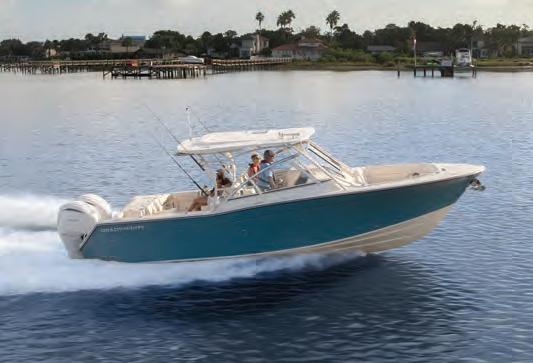




Corporate Air · Now taking reservations for our new 40,000 sq. ft. hangar expansion · Largest ramp space on the Treasure Coast! · Lowest jet fuel prices in Vero Beach - GUARANTEED! · Over 35 years of offering exceptional customer service Serving Vero Beach On The Waterfront For Over 65 YEARS! SALES · · SERVICE · · SHIP’S STORE Invest in Happiness... 772-562-7922 | 12 ROYAL PALM POINTE | VERO BEACH | WWW.VEROMARINE.COM

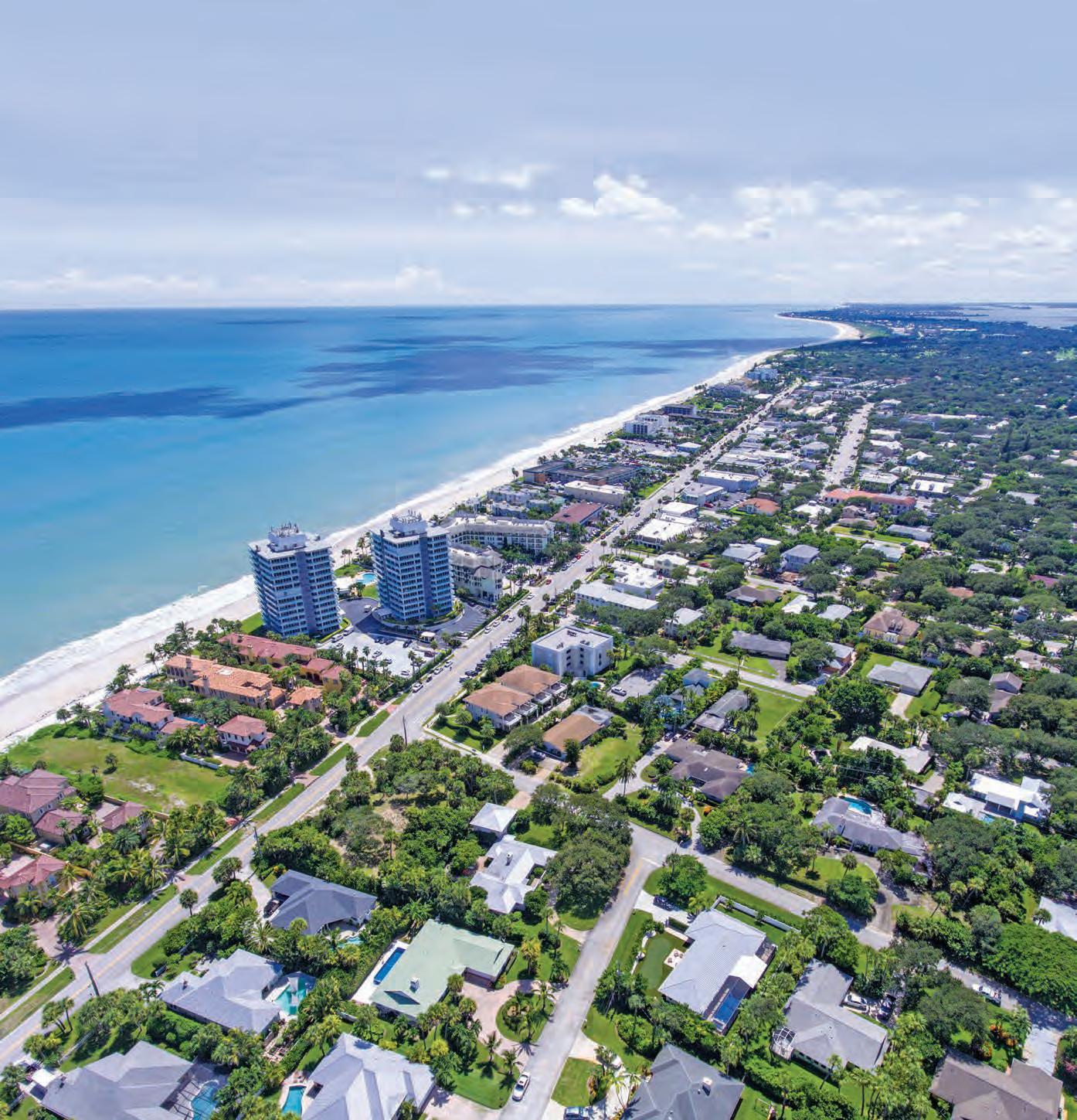

Christine R. McLaughlin, Lic. Broker Sales • Rentals • All Property Types • All Price Ranges 3201 Cardinal Drive, #7 • Vero Beach, FL 32963 Cell: 772-538-0683 www.propertyinvero.com • shamrock19@earthlink.net Beachside Specialist


140 VERO BEACH MAGAZINE On The March Local People and Products Always Keep Things Interesting New & Noteworthy PARTNER CONTENT Local artist Lida Stifel’s new pieces will be at M. Maison March 1–8. The artist will personally present her work, which includes coastal landscapes, still life, and figure paintings, at the opening cocktail reception March 8 from 2 to 6 p.m. M. MAISON 3403 Ocean Drive | 772-231-4300 | mmaisonvero.com STILL SPECTACULAR MARCH 8: ARTIST’S NEW WORK AT M. MAISON Elise Geary’s painting Taking Flight was awarded Best of Show at the recent Vero Beach Art Club exhibition “Big, Bold, and Beautiful.” Be sure to visit Geary in the same location as last year at Under the Oaks to see more of her award-winning work. OCEAN DRIVE GALLERY 3349 Ocean Drive, Suite 8, 2nd Floor | 772-579-7667 Elevator located in alcove behind Lyra Home oceandrivegalleryverobeach.com FLY BY THE BOOTH MARCH 8–10: ARTIST TO SHOW AT UNDER THE OAKS Beach Buddies by Lida Stifel, oil on board, 16 x 20 inches






CITRON BISTRO BELLE COSE VILLAGE SHOPS 6140 N HIGHWAY A1A WWW.VILLAGESHOPSVEROBEACH.COM FAHERTY MEGHAN CANDLER TOMMY BAHAMA ALIMENTARI GOURMET MARKET | BELLE COSE | CITRON BISTRO | CLIFF NORRIS REAL ESTATE COASTAL COMFORTS | FAHERTY | G. MATHEOS EYEWEAR | HOOS ARCHITECTURE | ISLAND CASHMERE J. MCLAUGHLIN | JEAN-PIERRE KLIFA | JOHNNY WAS | MEGHAN CANDLER GALLERY | NOTEWORTHY BY DESIGN OODLES OF WALLPAPER | SALON DEL MAR | SANDRA MORGAN INTERIORS | TOMMY BAHAMA J. MCLAUGHLIN
DOUBLE THE STYLE
MARCH 22–23: TRUNK SHOWS AT COOPER & CO.


Cooper & Co. will host another set of trunk shows featuring Barbara Lohmann and Maison Common. Prepare to find the best pieces to add to your stylish and always-evolving collection.
LIVE FROM NEW YORK
MARCH 22–23: STEPHANIE ALBERTSON APPEARANCE AND TRUNK SHOW

The Laughing Dog Gallery is delighted to welcome New York artist Stephanie Albertson for a two-day event. Her spectacular 22-karat-gold and gemstone jewels—charms, chains, and earrings, are favorites of jewelry aficionados and those who appreciate something truly unique. COOPER
772-231-9889
CHICKING IN
MARCH 22–23: ANNUAL EASTER EVENT AT LYRA

Lyra Home will host its annual “Pick-A-Chick” Easter event. Shop and save when you pick a chick at checkout for a discount of 10 to 30 percent off your purchase (certain items excluded).
2910 Cardinal Drive | 772-234-6711 | thelaughingdoggallery.com
HOP TO IT
MARCH 30: EASTER SALE AT TRIMMINGS

Celebrate Easter weekend with an egg hunt at Trimmings! Eggs will be filled with prizes and discounts, so stop by, find an egg, and reap some savings.
142 VERO BEACH MAGAZINE TRIMMINGS HOME GARDEN AND GIFTS 3201 Cardinal Drive | 772-213-8069 | shoptrimmingsvb.com LYRA HOME 3355 Ocean Drive | 772-257-4777 | lyrahome.com
& CO.
GALLERY
3435 Ocean Drive |
THE LAUGHING DOG
PARTNER CONTENT New & Noteworthy

3403
Across from Bobby’s 772.231.4300
mmaisonvero.com
Ocean Drive
FURNITURE ❘ ACCESSORIES ❘ LIGHTING INTERIORS ❘ LIFESTYLE BOUTIQUE mmaisonvero

New
DIG AROUND
BUSINESS OFFERS VARIETY OF ITEMS

Digg Gardens not only has a variety of indoor and outdoor plants, but it also has a gift shop filled with charming pieces for yourself or others. Visit the shop and find the perfect gift for the perfect recipient.
DIGG GARDENS
7430 U.S. Hwy. 1 | 772-360-2131 | digggardens.com
CLEAN ROUTINE
NEW FAUCET OPTION AVAILABLE

European Kitchen & Bath presents this Aquno Select kitchen faucet. Featuring a laminar spray, needle spray, and SatinFlow pull-out, it offers a crystal-clear spray type. It’s highly efficient with the day-today kitchen routine with very little splash back.
EUROPEAN KITCHEN & BATH
4003 U.S. Hwy. 1 | 772-494-2694 | europeansink.com
144 VERO BEACH MAGAZINE
& Noteworthy
A SHOPPER NEVER FORGETS
VARIETY OF DECOR PIECES AT FANTASTIC FINDS
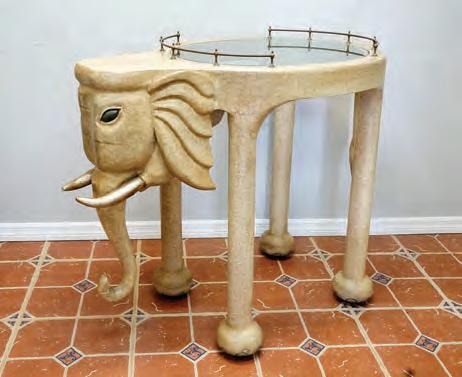
This unique carved wood elephant bar cart on casters was made by luxury custom furniture manufacturer Marge Carson Inc., founded in 1947. It measures 47 by 26 by 39 inches and is one of many distinctive items available at Fantastic Finds.
FANTASTIC FINDS
4300 U.S. Hwy. 1 | 772-794-7574 | fantastic-finds.com
SMOOTH IDEA
NEW PRODUCT GAINING POPULARITY

A new powerhouse product is quickly becoming a fan favorite. With its custom formulation, this medical-grade retinoic acid cream works to unclog pores, boost collagen, stimulate skin cell turnover, and even out discoloration while smoothing the skin’s texture.
ICONIC DERMATOLOGY
4800 20th St. | 772-758-1310 | iconicderm.com



MARCH 2024 145
3401 OCEAN DRIVE VERO BEACH GRADUATE GEMOLOGISTS CUSTOM DESIGN JEWELRY & WATCH REPAIR
Mother -of -Pearl Blue Topaz Gold Wood
PARTNER CONTENT


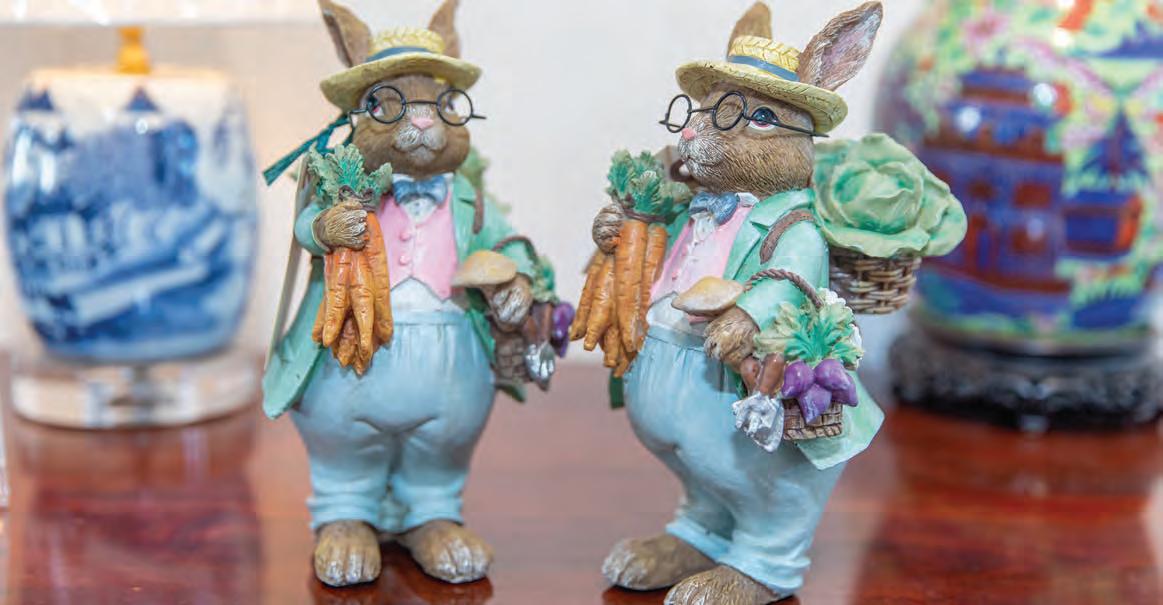


146 VERO BEACH MAGAZINE Happy Easter! 3201 Cardinal Drive |Vero Beach|772-213-8069 SHOPTRIMMINGSVB.COM 11 am–5 pm Monday–Friday Open Saturdays 11 am–3 pm ALL THETRIMMINGS ATTRIMMINGS New & Noteworthy Henrik Simonsen’s work is inspired by traditional Scandinavian art and design, echoing nature with its bold shapes and vivid colors. Visit the gallery to see why some say that each work is a living, breathing phenomenon. Visit The House of Lights to explore its selection of hanging baskets! These pendants and chandeliers complement any coastal decor. Hang around the showroom and see which speaks to your style. FINDLAY GALLERIES 165 Worth Ave., Palm Beach | 561-655-2090 | findlaygalleries.com THE HOUSE OF LIGHTS 1034 South Harbor City Blvd., Melbourne | 800-541-3048 thehouseoflights.com BUILDING BEAUTY RECENT WORKS AT FINDLAY A TISKET A TASKET UNIQUE ADORNMENTS AT HOUSE OF LIGHTS Yellow Tree by Henrik Simonsen, oil on linen, 59 x 55 1/8 inches PARTNER CONTENT


4

4
Nestled




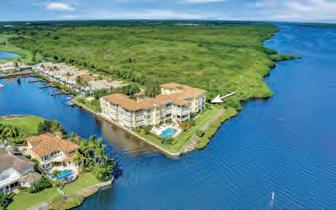
2911 OCEAN DRIVE, VERO BEACH, FL 32963 • WWW.CHARLOTTETERRY.COM
SANDFLY LANE $5,850,800
855
BR/3.5 BA
among live oaks in old Riomar is an exceptional 2023 build designed by Peter Moor AA. 4 bedroom, 3.5 bath, 3,595 sq ft exuding beauty, comfort, and functionality.
FLAMINGO DRIVE $4,995,000
3765
BR/4.5 BA
in the heart of Central Beach on Flamingo Drive this 1956 mid-century split home boasts over 3,800 sq ft of living space on over an acre. When Distinction & Location Are Your Top Priorities 246 OCEAN WAY $8,500,000
BR/3.5 BA Unparalleled panoramic views from each level of this 2-story, 6,636 square-foot home. Over 120’ of ocean frontage on this highly elevated .83-acre lot. Charlotte Terry 772.538.2388 charlotte@charlotteterry.com Patty Valdes 772.473.8810 patty@charlotteterry.com Maria Caldarone 772.713.7139 maria@charlotteterry.com
N HARBOR VILLAGE $1,695,000
BR/3 BA Luxurious Riverpoint condo overlooking the river and nature preserve! 3,000+ sq ft of living space, 2-car garage, extra ac storage, and private elevator to foyer. 835 10th Ave. S.W. Vero Beach, FL 32962 www.verobeachroofing.com Tel (772)770-3782 Licensed/Insured CCC# 018986, CCC# 1325908, CCC# 1330283 ROOFING • ROOF REPLACEMENT & REPAIRS • IN-HOUSE METAL ROOFING SHOP • MAINTENANCE • EMERGENCY RESPONSE • RELIABLE ROOF INSPECTIONS Quality Begins With Your Choice Of Contractor
Located
3
5620
4
New & Noteworthy
BUICK’S BEST
LINUS SHOWCASES TOP OPTION

Available in base Preferred, mid-level Sport Touring, and upscale Avenir trims, the new Envista has a turbocharged 1.2-liter 3-cylinder engine that works with a 6-speed automatic transmission.
LINUS CADILLAC BUICK GMC
1401 U.S. Hwy. 1 | 772-562-1700 linusautomotive.com | linuscadillac.com

Red light wellness is now offered at Mind and Body of Vero. Call to learn more and get scheduled to enjoy several benefits of this treatment, which may improve skin complexion, reduce inflammation, help mend sun damage, and increase energy.
MIND AND BODY OF VERO
1040 37th Place, Suite 202 | 772-400-2020 mindandbodyofvero.com
STAND STILL & ENJOY
ARTIST FRANE MLINAR ON EXHIBIT

Meghan Candler Gallery is delighted to exhibit a new collection of paintings by Frane Mlinar, a leading master of the Croatian realism movement. His distinctive, crisply painted boats with their serene stillness and outstanding color palettes are both beautiful and technically superb.
MEGHAN CANDLER GALLERY
6160 Hwy. A1A | Village Shops | 772-234-8811 meghancandlergallery.com

Oriflamme fire tables are available in a wide variety of shapes, sizes, colors, and materials, as well as propane or natural gas options. The finished product is a beautiful centerpiece for your outdoor setting. Visit the store to select yours.
148 VERO BEACH MAGAZINE
Summer Beauty by Frane Mlinar, oil on canvas, 36 x 48 inches
TO WELLNESS
NORDIC COMFORT HOME FURNISHINGS 1875 14th Ave.
GLOWING REVIEWS DISCOVER ORIFLAMME GAS FIRE TABLES WELCOME
NEW WELLNESS EXPERIENCE OFFERED
| 772-453-0220 | nordiccomfortfurnishings.com
PARTNER CONTENT

COOPER & CO Women’s Designer Clothing & Accessories 3435 Ocean Drive Across from Vero Beach Hotel & Spa (772) 231-9889 MARCH 22 & 23
10-5
10-5 MAISON COMMON BARBARA LOHMANN & BARBARA LOHMANN
TRUNK SHOW > >
Friday
Saturday
FALL
ROYAL & RARE
NEW CUSTOM JEWELRY AVAILABLE

Royal Palm Jewel presents one-of-a-kind earrings featuring rubellite with diamonds flanked by rare Paraiba and sapphires. Available in 18-karat white gold, you won’t want to miss these fabulous adornments.
ROYAL PALM JEWEL
53 Royal Palm Pointe | 772-766-3165 | royalpalmjewel.com

IF THE SHOE FITS
NEW SHOE LINE AT SASSY

Built on a desire to support the indigenous communities of Paraguay and preserve their precious craftsmanship, Amambaih merges sustainability, artisanship, and luxury. Each of the brand’s footwear creations draws upon vibrant, luscious fabrics that are handwoven by female artisans in Paraguay.
SASSY BOUTIQUE
3365 Ocean Drive | 772-234-3998

150 VERO BEACH MAGAZINE
PARTNER CONTENT
& Noteworthy
New




3554 OCEAN DRIVE
DOUBLE PENTHOUSE 1 & 4 VERO BEACH, FLORIDA 32963
A once in a lifetime opportunity awaits you on iconic Ocean Drive! Voted ‘’The BEST VIEW in Vero Beach,” this extremely rare double penthouse unit has everything you desire & more! Enjoy surreal sunrises from your oceanfront balcony/master suite, take in breathtaking sunsets & river views from your family room, or relax & watch all the hustle & bustle of Ocean Drive. Luxury upgrades sure to appease even the most disconcerting buyer. 2 master suites + 3rd bedroom, 3 full baths, with possible 4th bedroom & 4th bathroom conversion. The opportunities are endless!
SPECIAL FEATURES
OCEANFRONT
SURREAL SUNRISES BREATHTAKING SUNSETS
MARBLE FLOORS
CUSTOM CHERRYWOOD CABINETS
GRANITE COUNTERTOPS
IMPACT WINDOWS ACCORDION SHUTTERS RIVER VIEWS

COLLEEN JENNINGS, REALTOR
1021 Beachland Blvd. | Vero Beach, FL 32963
Direct: 772-559-8125
Office: 772-231-0001
billeroproperties.com






New & Noteworthy
HANGING AROUND
NEW DECOR PIECES AT STUDIO

Sandra Morgan Interiors at the Village Shops presents a fresh group of large wall baskets in indigo and white that can be used as artwork. These baskets are handwoven by ladies in Rwanda and would make a fabulous addition to many spaces.
SANDRA MORGAN INTERIORS & ART PRIV É 6174 Hwy. A1A | Village Shops | 203-629-8121 sandramorganinteriors.com
LET’S HEAR IT
GROUP RECOGNIZED AS TOP TEAM

Brian Shambo
The Shambo Schwibner Wealth Management Group was recently recognized by Forbes as one of the “Best in State Wealth Management Teams.” Managing director Brian Shambo was also recognized by Forbes, Barron’s, InvestmentNews, and On Wall Street as a top advisor.
SHAMBO | SCHWIBNER | SCHWARTZ WEALTH MGMT. GROUP 660 Beachland Blvd., Suite 302 | 772-231-9051 fa.ml.com/shamboschwibner
NO RUFF VISITS
PETS WELCOME AT HOTEL

Staybridge Suites offers transparent guidelines for dogs, cats, and other pets, so you can travel easily with your favorite companions. Wherever you go, your pet goes too.
STAYBRIDGE SUITES 5155 20th St. | 772-562-6000 | staybridge.com/verobeachfl
VERO’S VETERANS
ORGANIZATIONS REVOLUTIONIZING VETERAN ADVOCACY

United Way’s Powered by Purpose speaker series spotlighted Florida veterans’ critical needs. Meredith Egan and speakers Kris Hasenauer (Emerald Medical), Cynthia Ryan (Veterans Council of IRC), and Melissa Arndt (IRC Veteran Services) presented innovative solutions emphasizing mental health support, benefits access, and comprehensive care.
UNITED WAY FOUNDATION OF INDIAN RIVER COUNTY 1836 14th Ave. | 772-569-8900 | unitedwayirc.org
152 VERO BEACH MAGAZINE
Kris Hasenauer, Jasper, Cynthia Ryan, Melissa Arndt
CONSIDER IT HAND-LED
BEAUTY STUDIO UPHOLDS BEST PRACTICES

The Jessyca’s Beauty Studio team is made up of trained, educated, licensed, and insured nail artists who take tremendous pride in ensuring all materials are cleaned, sanitized, and disinfected using antibacterial soap, Barbicide, ultrasonic cleaning, autoclave, and UV light treatment.
JESSYCA’S BEAUTY STUDIO
1535 U.S. Hwy. 1 | 772-882-8273 | jessycasbeautystudio.com
DREAM A LITTLE DIAMOND
NEWEST TECHNOLOGY AT LEIGH JEWELERS

Leigh Jewelers has expanded its custom design department with inhouse 3D printing. A resin can be grown on-site for custom design clients to try on their custom piece before final production. Call to make an appointment to create a piece of one-of-a-kind jewelry.
LEIGH JEWELERS
3401 Ocean Drive | 772-234-8522 | leighjewelers.com
Federico Herrero
A Piece of Waterfall in the Sound of Crickets

January 27 – April 26, 2024
An expansive solo exhibition featuring a selection of recent paintings and monotypes by Costa Rican artist Federico Herrero.
The Gallery at Windsor 3125 Windsor Boulevard, Vero Beach, FL 32963 windsorflorida.com/gallery
By appointment | 772 388 4071 gallery@windsorflorida.com
MARCH 2024 153
PARTNER CONTENT
Huracan, 2023, Oil and acrylic on canvas, 78 3/4 x 63 in., 200 x 160 cm
PARTNER CONTENT
CUSTOM

VB Home presents new Lee Industries custom sofa upholstery with a 4-to-6-week turnaround. Featured here is the trundle bed, offering a fabulous use of space that can be designed with your theme or style in mind.
615 Beachland Blvd. | 772-492-9348 | vbhome.us


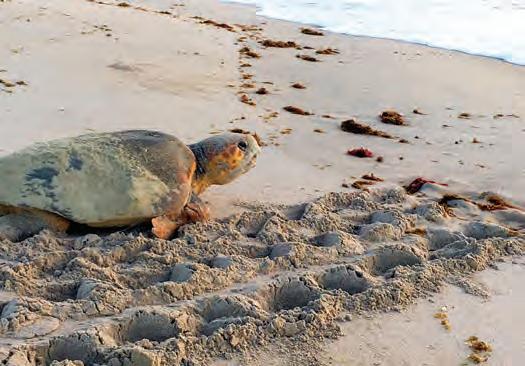
Sea turtle nesting season begins in Florida March 1. Visit LED Capstone Lighting & Fans for all turtle lighting options to help avoid disturbances by having appropriate “turtle-safe” light bulbs and fixtures that are certified wildlife safe and fit code-enforcement guidelines.


154 VERO BEACH MAGAZINE
VB HOME
LED CAPSTONE LIGHTING & FAN SHOWROOM 4005
U.S. Hwy. 1 | 772-205-2529 | ledcapstone.com LEAD BY DESIGN
FURNITURE CHOICES AT VB HOME SLOW & STEADY & SAFE LED CAPSTONE HELPS WITH TURTLE LIGHTING NEEDS
7430 US Highway 1 | Vero Beach | 772.360.2131 | digggardens.com LOST TREE PRESERVE NEW HOMES IN VERO BEACH FROM THE LOW $400s AMENITIES OPEN | LOW HOA 12 MINUTES TO BEACH RyanHomes.com/Lost-Tree-2 Lost Tree Preserve 6540 Pomello Court Vero Beach, FL 32697 561.359.0506 New & Noteworthy PARTNER CONTENT

Unique Lattice inspired precious gemstone, key to your heart pendant and matching earrings set in 18 karat gold.


RoyalPalmJewel.com
THROUGH THE PRIVACY GLASS
VERO GLASS NOW OFFERING SMART GLASS TECHNOLOGY

Vero Glass is pleased to introduce Smart Glass Technologies to its wide range of window and door products. SGT is a leader in the industry of switchable privacy glass, which can be changed from transparent to opaque with the flip of a switch. Stop by the showroom to discover all the ways this technology can enhance your home or office.
VERO GLASS & MIRROR 1705 Old Dixie Hwy. | 772-567-3123 | veroglass.com
TAKE A CRUISE
NEW FOOTWEAR AT VERNON SCOTT

156 VERO BEACH MAGAZINE
818 Beachland Blvd. | 772-231-3733 | vernonscott32963.com
VERNON
SCOTT RESORT WEAR
53 Royal Palm Pointe Vero Beach, Florida 772-766-3165
COLLECTION
ROYAL PALM JEWEL FINE JEWELRY
Vernon Scott Resort Wear has the newest Peter Millar knit drivers. Designed in three colors, this style provides a timeless, lightweight shoe selection. Visit the store to snag a pair, or
all three.
PARTNER CONTENT New & Noteworthy


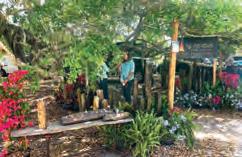








Vero Beach Art Club (772) 231-0303 www.undertheoaksartshow.com 73rd Annual Under The Oaks Fine Art & Craft Show Friday, March 8 thru Sunday, March 10 2024 • Over 200 of the finest artists in the country • Add to your collection of fine art • Food from your favorite local caterers • Voted #2 in nationally ranked fine art shows In Riverside Park 3001 Riverside Park Drive Friday and Saturday 9am-5pm Sunday 10am-4pm


Realtor Cathy Curley of DSRE has been recognized as the No. 3 real estate agent in Indian River County, based on information obtained from the MLS of the REALTORS Association of IRC for the 2023 year! Incredibly proud and grateful, she extends big thanks to the clients who put their trust and faith in her, and she promises to continue to work hard at exceeding expectations, giving back to the community she loves, and making real estate a fun and memorable experience.










158 VERO BEACH MAGAZINE PARTNER CONTENT
YSF Community Sailing announces the appointment of Chris Drake as executive director, as Stu Keiller transitions from that position into work on the planning and construction of the organization’s new community sailing center set to open in early 2026. Drake and his family moved to Vero Beach from Shelter Island, New York, in 2018.
1535 U.S. HWY 1 | VERO BEACH | BOOK ONLINE WWW.JESSYCASBEAUTYSTUDIO.COM FUME FREE, HEALTHY & HOLISTIC BEAUTY TREATMENTS JESSYCA’S
Triple sanitized BOUTIQUE NAIL SALON offering high grade treatments such as nails, pedicures, lash extensions, lash care/brow care, permanent makeup and makeup tutorials; using essential oils and organic ingredients. 2023/2024 SEASON 2023/2024 SEASON MAIN STAGE PERFORMANCES ACCESSIBLE/FAMILY FRIENDLY PERFORMANCES NEW CLASSICS April 19 | 7:30pm April 20 | 2:00pm & 7:30pm For tickets, and all things Ballet Vero Beach, please visit balletverobeach.org or scan this QR Code! THE SLEEPING PRINCESS April 21 | 2:00pm SAVE THE DATE APRIL 26, 2024 6:00PM New & Noteworthy
Welcome Congratulations
BEAUTY STUDIO


Sponsors
Presenting Sponsor: VERO BEACH OUTLETS
Cleveland Clinic Indian River Hospital
George E. Warren LLC
Dr. and Mrs. Paul Minotty
Florida Power & Light Company
Jim and Jean Ueltschi
Au Pair in America
Premier Plastic Surgery & Aesthetics – John Michael Sarback M.D.
93.7 WGYL
97.1 OCEAN FM

Designers
Alexandra Nuttall Design
Andi Beck Interior Design and Jennifer Grant
Andrea Giles and Alysia Hines
Colleen Wixon
Darien Santos
Deborah Pariseau
Dillard's, Vero Beach
Elly Jones
Environmental Learning Center
Sue Lakin and Sharon Mills
Lisa Sarbak and Robyn Nolan
M.C. Gorman
Marylou Robins
Monica Scurry-Anderson
The Tree Amigos –
Nancy Large
Lyn Law
Barbara Woodward
Trinity Omniscient Care, Inc.
Tykes & Teens
Vero Beach Art Club
Winterfest is the signature fundraising event for Riverside Theatre’s educational programs with a mission to give every child the chance to participate in the performing arts, regardless of financial need.




772-231-6990 • RiversideTheatre.com Ernst Karl Eugen Koerner, The Temple of Karnak, The Great Hypostyle Hall, (detail), 1890. Oil on canvas, 31 1/4 x 18 ¼ in. Dahesh Museum of Art, New York, 1995.114. ON VIEW January 27 – April 28, 2024 3001 Riverside Park Drive www.vbmuseum.org / 772.231.0707 Ancient Egypt & the Napoleonic Era: Masterworks from the Dahesh Museum of Art This exhibition was organized by the Dahesh Museum of Art, New York City.


















JOIN US FOR SUNDAY BRUNCH! from 10AM to 2PM Open daily at 4pm for dinner 1919 14th Avenue, Vero Beach, FL 32960 postandvinevb.com food drink Est. 2017 SCAN ME! PostVine_0224_VBM.indd 3 02-Jan-24 10:36:51 GARDEN CENTER | LANDSCAPING | WEDDINGS WWW.ROCKCITYGARDENS.COM
THE DISH
The Source’s Dignity Food Trucks are serving up opportunities for a better life.

162
THE DISH | OFF THE VINE MARCH 2024 161
Local Flavor
KIM BOTTALICO
Secret Recipe
DIGNITY FOOD TRUCKS ARE SERVING UP OPPORTUNITIES FOR A BETTER LIFE
BY CHRIS FASOLINO PHOTOGRAPHY BY KIM BOTTALICO
For Toni Moore, cooking brings her back to memories of family. For Russell Walker, cooking has been part of dramatic changes in his life. For you, both Moore and Walker are part of the story behind the food trucks that you have likely seen at a variety of Vero Beach locations.
Featuring an award-winning barbecue sauce and serving an imaginative pineapple bowl, Dignity Food Trucks are part of a series of programs from The Source that aim to blend philanthropy and culinary arts, as Walker’s story shows.
“When I came here, I was homeless,” he says. “They told me about the cooking program. It was hard, but I stayed with it. They taught me how to properly sanitize and handle food, and they taught me about seasonings.” Today, Walker is no longer homeless, and he is running one of the food trucks.
Moore is the kitchen manager, and she oversees the culinary program, which, she explains, offers education and experience in restaurant-style service, catering, and food trucks, in addition to providing certification that can give graduates an advantage when it comes to finding jobs.
“This is my second career,” Moore says. She never expected to go into the culinary field, although she learned cooking skills as a child. “At an early age, I heard my grandmother say that the way to a man’s heart is through his stomach—so I followed her into the kitchen,” she laughs. “My grandmother and my mom did everything from scratch.”
Growing up in Fort Pierce and then attending college in North Carolina, Moore pursued a computer science career path, which took her far from the
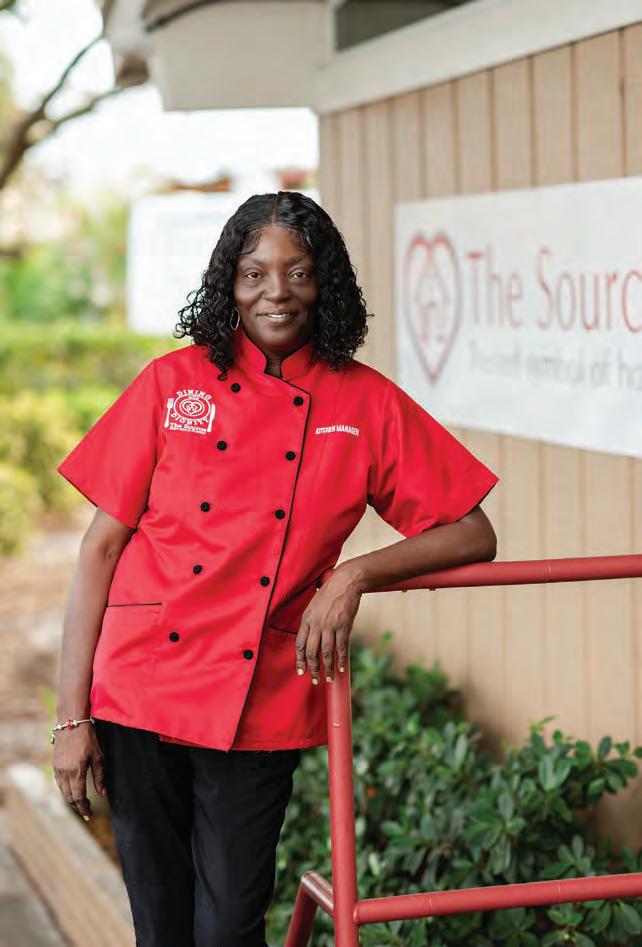
kitchen—until she decided to “try something different” and exchanged coding for cooking.
Dignity Food Trucks use a secret-recipe barbecue sauce called “Mo’s.” It is named in memory of Maureen Archer, a beloved associate who passed away in 2022. Mo’s Sauce has won first-place honors at competitions in Vero Beach and on the Space Coast.
“It’s got a little kick, but not too much,” Moore says. “It’s a little sweet and a little sour.” It enhances the pineapple bowls, which are half-pineapples filled with yellow rice along with either shrimp or chicken.
As kitchen manager, does Moore herself have a favorite recipe? “My favorite is whatever you like,” she says, “because if the customer is happy, I’m happy.”
Toni Moore, kitchen manager for The Source, enjoys sharing her culinary talent and keeping her customers happy.
162 VERO BEACH MAGAZINE
DISH
THE
ENTERTAINING
APPETIZER
Shrimp Cocktail
The flavorful cocktail sauce provides a vibrant combination of horseradish, citrus, and spice.
SERVES 4
24 large shrimp (21–25 count per pound, raw, thawed, deveined, and easy to peel)
1/2 tsp. salt
Half a lemon (optional)
8–10 peppercorns (optional)
Handful fresh parsley (optional)
Cocktail sauce
In a large saucepan, add water until 3/4 full. Add salt. If using lemon, squeeze the juice into the pot and then add the peel and flesh. Add peppercorns and parsley if using. Bring to a rapid boil over high heat. Remove from heat. When water stops boiling, add the shrimp and stir. Cover and let sit 4–5 minutes, until shrimp are opaque and pink. Meanwhile, prepare an ice bath: in a large bowl, put 2 cups of ice cubes and fill halfway with cold water. When shrimp are cooked, drain off the hot liquid and transfer shrimp (but not the aromatics) to the ice bath. Let sit for a few minutes to fully cool off before draining. Peel shrimp but leave the tails on.
Divide cocktail sauce among 4 small bowls, wine glasses, or martini glasses. Hang shrimp from the rims. Serve immediately.

COCKTAIL SAUCE:
1 cup ketchup
2 tbsp. horseradish
Pinch of salt
1 tsp. lemon juice (optional)
1/2 tsp. Worcestershire sauce (optional)
1/2 tsp. hot sauce, such as Tabasco (optional)
Combine all ingredients in a medium bowl.
MARCH 2024 163

ENTR ÉE
Orange Glazed Chicken
Contrasting yet complementary flavors, a distinctive blend of spices, and a honey glaze give this dish interest and complexity.
SERVES 2
2 half chicken breasts or thighs, bone-in and skin-on
3 tbsp. butter, melted
1/2 tsp. smoked paprika
1/2 tsp. chili powder
1/2 tsp. onion powder
1 tsp. garlic powder
Salt and black pepper to taste
Orange honey glaze
1 tsp. fresh rosemary, chopped fine, for garnish
1 tsp. fresh thyme leaves, for garnish
ORANGE HONEY GLAZE
3/4 cup honey
Zest of one orange
1/2 cup fresh orange juice
1/4 cup apple cider
1 tbsp. Dijon mustard
Salt and black pepper to taste
Mix all ingredients in a small bowl. Reserve half to serve with the chicken. Use the rest to baste while the chicken cooks.
Preheat oven to 375 degrees Fahrenheit.
Line a half sheet pan with aluminum foil. Place the chicken breasts bone-side down on the pan. Brush with melted butter and sprinkle with paprika, chili powder, onion powder, garlic powder, salt, and pepper. Brush with a little orange honey glaze. Insert a digital thermometer so you can check the internal temperature. Cook for 30 minutes, then continue to baste with orange honey glaze every 10 minutes until the chicken is done. Allow chicken to rest 10 minutes before slicing.
Sprinkle with fresh rosemary and thyme and serve with the reserved orange honey glaze.
164 VERO
MAGAZINE THE DISH
BEACH

Strawberry Parfait
A refreshing and healthful dessert featuring Greek yogurt, honey, and fresh strawberries.
SERVES 2
1 cup plain Greek yogurt (full fat)
2 tbsp. honey
1 cup fresh strawberries
1 cup granola, any kind
Chop strawberries into small pieces. Using a whisk, thoroughly mix the yogurt and honey.
In a small glass cup or jar, assemble each parfait using 1/4 cup of each ingredient at a time. Layer in this order: yogurt, granola, and strawberries. Repeat until filled to the top.
MARCH 2024 165
DESSERT
MADEIRA
Madeira wine was enjoyed by our colonial ancestors and was a favorite of both Benjamin Franklin and George Washington.

A Wine for the Ages
MADEIRA WAS AN EARLY-AMERICAN LUXURY WE CAN SHARE WITH OUR FOUNDING FATHERS
BY CHRIS FASOLINO


From colonial times through the early days of the republic, the after-dinner drink of choice in America was Madeira wine. Shipped from the Portuguese island of Madeira, this fortified wine was a fitting choice for the close of a banquet or for a quiet evening by the fireside.

Benjamin Franklin loved Madeira wine, and with his scientific curiosity, he was fascinated by the unusual climate of the island itself. Franklin was the first person to chart the Gulf Stream, and he noted its effects on the island of Madeira, where tropical fruits and spices flourished along with the vineyards.
George Washington favored Madeira accompanied by walnuts for dessert. James Fenimore Cooper, author of The Last of the Mohicans, wrote a wryly touching story about an American soldier and a British soldier who came to respect each other because they were both men of honor—and because they were both connoisseurs of Madeira.
Today, Madeira is rather overshadowed by other fortified
wines, particularly port and sherry. And while I’m undoubtedly a proponent of good port or sherry, Madeira should not be forgotten. Indeed, its relative obscurity today makes it a great choice for entertaining; it comes as a pleasant surprise.
The venerable company of Henriques & Henriques offers a selection of fine Madeira wines.
Along with the various Portuguese grape varieties that are used, the length of time spent aging in oak casks is a major distinction. Five years of aging produces a wine that is amber in color—as Cooper said Madeira should be—and brimming with caramelized brown sugar and vanilla flavors. Already, the winemaker’s description “full, generous and rich” is very apt.
Double the aging time and the flavors become even deeper, with a 10-year-old Boal Madeira
166 VERO BEACH MAGAZINE
OFF THE VINE


having stronger notes of oak and nuances reminiscent of honey. A 20-year-old Madeira will boast increasing complexity, and in the historic category of “Very Old Reserves,” the sky’s the limit—both in age and in price. Some of these wines, from the Henriques family’s private reserves, predate the company’s founding in 1850. As an after-dinner wine,

Madeira is a great pairing for rich desserts. As per George Washington’s recommendation, it also pairs well with walnuts; you might toast the walnuts and dust them with cinnamon and freshly grated nutmeg. In any case, if you enjoy cream sherry, you will probably love Madeira. It is a taste of history, and a wine worth remembering.

MARCH 2024 167
Henriques & Henriques Madeira wines can take on different flavors at different times in their aging process. The complexity of the flavor grows with age.
SUBSCRIBE TODAY or visit verobeachmagazine.com/qr

Culture & Caring
LOCAL NONPROFITS ENRICH THE COMMUNITY IN COUNTLESS WAYS





Evening of Music
VERO FRIENDS OF ACO
“An Intimate Evening of Beautiful Piano Music” brought music lovers together at Orchid Island Golf & Beach Club December 5. The Vero Friends of the Atlantic Classical Orchestra put on the event, which featured the performance of a program titled “Invitation to Dance” by pianist Drew Petersen. Afterward, he and David Amado, the ACO’s musical director, hosted an outdoor cocktail and hors d’oeuvres reception with the orchestra’s musicians and supporters.


170 VERO BEACH MAGAZINE
THE SCENE
Guests enjoy a performance by pianist Drew Petersen.
David Amado, Drew Petersen, Pat Baker Scott
Genny and Gerry Pearce
Drew Petersen, Phil and Joan Gulley, Rob and Kari Tench, David Amado
Steve and Reggie McCormack, Greg and Lori Clark
Guests face a tough hors d’oeuvres choice.
&
ORCHID ISLAND GOLF
BEACH CLUB
An outdoor reception caps off the evening.






























J.D. POWER AWARDS • GM Ranks Top Automotive Corp • Buick #1 Overall Brand for New Vehicle Quality • Sierra #1 Light Duty Full Size Pickup Truck Believe in Quality. Believe in Linus. BUICK GMC CADILLAC HAPPY ST. PATRICK �S DAY 1401 US HIGHWAY 1 • VERO BEACH, FL 32960 • LINUSCADILLAC.COM • LINUSAUTOMOTIVE.COM • 772-562-1700
THE SCENE




Opening Receptions
GALLERY 14
Artists Jim Cohoe and Joshua McMiller were present to launch their exhibitions, “Nuts to Garden Vases” and “Nature’s Conscience, an Artistic Journey,” respectively, at Gallery 14 in November. The receptions also marked the opening of Gallery 14’s 16th year. In addition to meeting the artists and viewing their work, guests enjoyed wine and cheese as well as desserts supplied by Sweet Desires espresso bar and bakery.
Sponsor: Panacea Eye Center

172 VERO BEACH MAGAZINE
Jason and Kathleen Pogany, Mark Wygonik, Liz Mayo
Jodi Dassow Landry, Mark Landry
Jim Cohoe, Dr. Sarah Khodadadeh, Joshua McMiller
Deborah Polackwich, Rickie Leiter, Rosemary Polsky-Newman
Chris Foster, Ryan Schroeder, Jim Davis

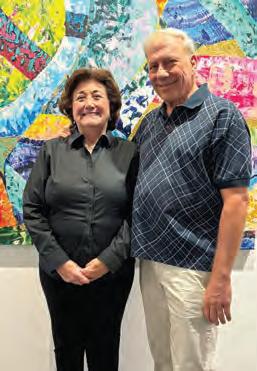


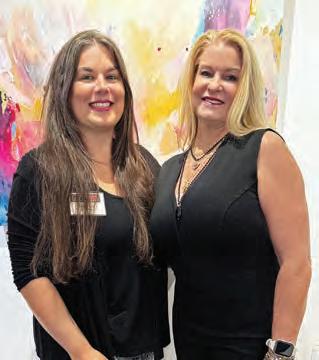


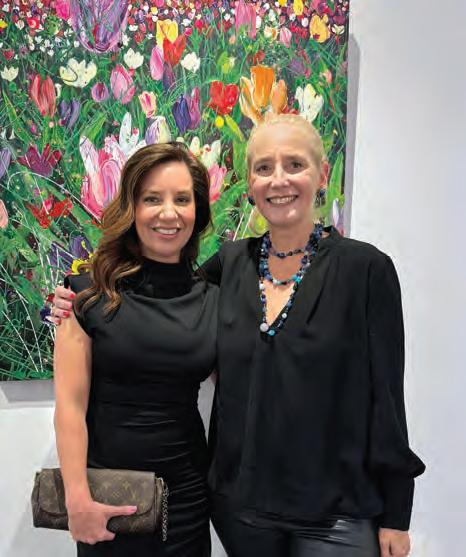
MARCH 2024 173
Debbie Daly, Petra Blackman, Joshua McMiller
Huey Zaplin, Quentin Walter Jessica Leto, Kim Paul
Barbara Landry, Dr. Sarah Khodadadeh, Diane Khodadadeh
Donna and Peter Polk
Barbara Krupp, Dorothy Napp Schindel, Allan Teger
Dana Baker, Christine Hughes
Lila Blakeslee, Joshua McMiller, Paul Genke





“THAT GOLDEN HOUR” 30” X 30” Oil 3349 Ocean Drive, Suite 8, 2nd Floor Vero Beach, FL 32963 Artist Elise Geary 772-579-7667 • eliseartist.com 818 Beachland Blvd 772-231-3733 Mon–Sat 10 to 5 VernonScott32963.com Our Clothing Suits Your Life ON THE BEACH










Shoe Salon and Boutique 3385 Ocean Drive • Vero Beach 772-231-2771 Harbour Bay Plaza • Sewall’s Point 772-221-9973 kempsshoesalon.com A way of life since 1959 ON THE BEACH Vero Beach Bracelet Sterling Silver and 14k Gold, all 14k Gold, or 14k Gold w/Diamonds Exclusively at: 3401 OCEAN DRIVE 772.234.8522 LEIGHJEWELERS.COM CUSTOM DESIGN • JEWELRY & WATCH REPAIR GRADUATE GEMOLOGISTS AVAILABLE FOR PURCHASE IN STORE OR ONLINE Dresses Jewelry The Original Palm Beach Sandal 3309 Ocean Drive • Vero Beach, FL 32963 • 772.226.5998 • PalmBeachSandals.com Sunglasses Scarves & Wraps Bags & Totes Beach Accessories Gifts Home Decor
THE SCENE
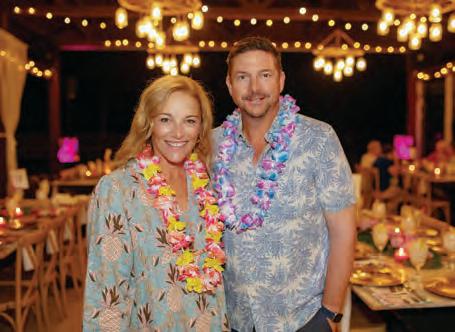
Bow Wow Meow Luau
HALO NO-KILL RESCUE
The lovely Magnolia Manor was the venue for HALO’s Bow Wow Meow Luau, a magical December evening with entertainment by Aloha Productions. Many supporters turned out to enjoy tropical cuisine from Wild Thyme and hula the night away, raising enough money to fund the renovation of an entire 10-suite dog wing at the shelter. The improvements will allow for more sanitary and open conditions, which will lead to happier, healthier dogs available for adoption.



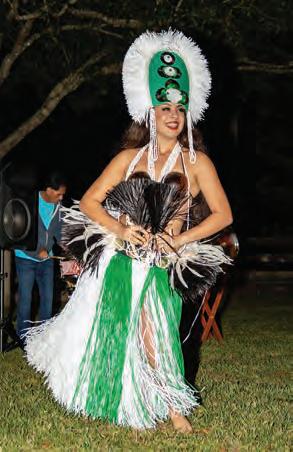


176 VERO BEACH MAGAZINE
Wanda and John Bolton
Kelley Adrahtas
A dancer from Aloha ProductionsHummus in his Hawaiian shirt
Guests enjoy the beautiful setting at Magnolia Manor.
Jacque Petrone, Rob Kyzer, Joey and Allyson King
NORAIR PHOTOGRAPHY

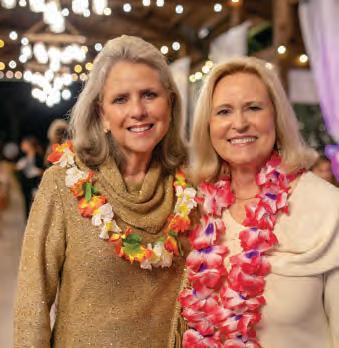





MARCH 2024 177
Karen Loeffler, Page Franzel, Allyson King, Diane Langevin, Lynne Bortree
A dancer represents Samoan warrior tradition.
Hula dancers from Aloha Productions
Michelle Lee with Hummus, Karleen Rogers
Page Franzel, Diane Langevin
Marina Harvey, Melody Weaver
Carol Tapp, Anij Indigo, Carl and Deb Kretchman
NORAIR PHOTOGRAPHY
THE SCENE
Night of Caring
CARE NET PREGNANCY CENTER
More than 350 guests and too many sponsors to mention made Care Net’s 39th annual fall fundraising dinner banquet, A Night of Caring, a huge success. The event took place in November at the Intergenerational Center. Supporters learned about Care Net’s new building, enjoyed an inspiring talk by Dr. William Lile, and celebrated the bestowal of the Legacy of Life Award upon office manager Vicki Fannin in recognition of her two decades of achievements with Care Net.




178 VERO BEACH MAGAZINE
Taylor Knott, Norann Chambers, Paige Chambers, Dr. William Lile, Ross Chambers
Amy Beckley, Reggie McCormack, Dr. Lile, Bonnie Martinelli
Rev. Chris and Kathy Rodriguez, Marty Fite, Dr. Lile
Vicki Fannin, recipient of the Legacy of Life Award







Janet Kipp Tribus 772-766-0636 2304 Seventh Avenue, Vero Beach, FL Open by appointment or by chance Rita Barone 772-359-6283 seventh avenue studio 3121 Ocean Drive | Vero Beach, FL 32963 | 772-321-5535 museboutiquevb museverobeach.com ∙ Studio, 1 Bedroom, and 2 Bedroom Suites ∙ Fully Equipped Kitchens ∙ 24/7 Complimentary Laundry ∙ 24/7 Fitness Center ∙ Heated Outdoor Pool ∙ Outdoor Grills ∙ Pet-Friendly Property ∙ Complimentary Evening Social Mon-Wed ∙ Full Hot Breakfast 7 Days a Week Choose Better EVERYTHING YOU NEED AND SO MUCH MORE! There is something special and distinctive when you stay at the Staybridge Suites hotel in Vero Beach. That's because we get what it takes to make our guests feel more comfortable, connected, and welcome. 5155 20th Street, Vero Beach, FL 32966 (772) 562-6000 | Staybridge.com/VeroBeachFL Featured Amenities
THE SCENE




Fall Luncheon
RIVERSIDE THEATRE
About 500 supporters were on hand for Riverside Theatre’s Friends Fall Luncheon in November. They enjoyed an original presentation created by the theater’s producing artistic director, Allen D. Cornell, followed by lunch catered by Elizabeth D. Kennedy & Co.
Major sponsors:
Barbara Baldwin; Debbie Berghorst and Wheatie Gibb; Rennie Gibb, Catalina Pines, and Kristen Yoshitani; Eva Gurley; Sonia McGowan; Carolyn and Bill Stutt

180 VERO BEACH MAGAZINE
Cindy Rounsavall, Carolyn Stutt
Steve Mazza, Susan Temple, Cathy Padgett
Co-chairs Kristen Yoshitani, Rennie Gibb, and Catalina Pines
Performers take the stage for an original presentation by Allen Cornell.
ANGEL
Myriam Robinson, Debbie Berghorst, Lucy Danis
UDELHOVEN





MARCH 2024 181 ANGEL UDELHOVEN
Ginger Gibson, Sallie Gibson
Colorful decorations invite participants into the luncheon.
The Stark Stage
Carol Price, Karen Meyer
Catalina Pines, Kristen Yoshitani, Sandy McManus, Steve Mazza, Cathy Padgett, Rennie Gibb





Undulant


“Do you ever feel like you’re home, even though you’ve never been there before?”
–
4001 U.S. Hwy. 1 ~ Vero Beach, FL 32960 ~ 772-978-1212 ~ TileMarketVeroBeach.com 220 S. Old Dixie Hwy. ~ Jupiter, FL 33458 ~ 561-299-0295 ~ TileMarketJupiter.com Reimagine | Renovate | Refresh MACATA STONE STONEWORK THAT STANDS THE TEST OF TIME 772-778-3210 • 4440 US Hwy 1, Vero Beach macatastone.com MACATA STONE Kitchen design by Page2Design 4005 US Highway 1 | Vero Beach, FL 32960 | 772-205-2529 | LEDCapstone.com “YOUR LED LIGHTING, TURTLE LIGHTING & CEILING FAN SPECIALISTS”
"blossoms" of LED-lit hand blown
to
this mid-century
Blossom
artisan creation
the
of
and
STARBURST CHANDELIER BY HAMMERTON STUDIO DESIGNERS ROW
glass nod
an organic aesthetic in
inspired starburst design. Each
glass shade is a one-of-a-kind
representing
combined talents
Hammerton’s metal
glass fabrication teams. BLOSSOM
BRITTANY SWARTZ THOMPSON, “Pop the Cork!” p. 102
QUALITY PRODUCTS
EXCEPTIONAL SERVICE
OUTSTANDING VALUE
DESIGNERS ROW
VERO BEACH
4003 U.S. Hwy. 1
772-770-9970
Fax 770-9570
STUART
197 SE Monterey Rd. 772-221-3990
EUROPEANSINK.COM



Twice as nice at a fraction of the price!
Fine Custom & Consignment Furniture
Original Art ~ Persian Rugs ~ Coastal Decor
DESIGN ROW
4300 US Rt. 1
Vero Beach
772-794-7574
fantasticfindsverobeach@outlook.com
Fantastic-Finds.com
THE SCENE





Evening at the Boulevard ST. FRANCIS MANOR
Chefs Anthony and Lisa Damiano of Counter Culture at Boulevard Tennis Club prepared an array of hors d’oeuvres, and members of the Gifford Youth Orchestra provided the entertainment as guests enjoyed a silent auction, a wine pull, and raffles in support of St. Francis Manor. A tennis exhibition topped off the evening, which benefited the manor’s work of providing affordable housing for local seniors aged 62 and over.



184 VERO BEACH MAGAZINE
Charlie Schuler, Chris Lecakes, Ann Schuler
Wendy Orthober, Diane Benkert Mello
Tom Collins, Randy McMillan
Sharon Knowles, Maria Elena Kitchell
Tom Collins, Tim Brueggeman
Ryan Kitchell
Christina and Mike Marshall
Bonnie Matz, Anthony and Lisa Damiano

Pre-Apprenticeship Program
YOUTH GUIDANCE MENTORING ACADEMY


Back in September, Youth Guidance launched the third year of its Pre-Apprenticeship Program with 25 students aged 17 to 24. Through partnerships and donor generosity, the program is offered at no cost and introduces students to five trades: carpentry, electrical, plumbing, HVAC, and welding. Twice each week, they meet for three-hour sessions to study both the academic and practical aspects of these fields—everything from reading a tape measure to wiring outlets to wielding a welding torch. Since 2021, 25 students have graduated from the program, and some have secured employment performing valuable services in the trade sector.




During National Nutrition Month, help us provide nutritious meals to families who don’t always have enough to eat.


MARCH
StopHunger.org
Students learn to use a circular saw.Students create a small house to scale.
Students in the carpentry module build a wall frame.
Aerial li operation is part of the training.




•
•
•
•

“I enjoy all kinds of decor, but I especially love tranquility and peace.”
– KRIS TRUSTEY, “Playland with a Purpose,” p. 122
•

“I didn’t plan any of it; opportunities just showed up and I said yes.”
– DAWN MILLER, “Giving Limits the Brush-Off,” p. 116
VILLAGE SHOPS
Unique Gifts
Home Furnishings
Bed & Bath
Custom Window Treatments
In-Home Design Services
The Village Shops of Vero Beach 6190 Hwy A1A Vero Beach, FL
772-226-7808
www.coastal-comforts.com
Eyeglass and Sunglass Boutique • • Prescription and Non-Prescription Eyewear • new prescriptions filled existing prescriptions duplicated contact lens prescriptions filled • Licensed Optician • Full Lab on Premises • Village Shops | 6200 Highway A1A | 772.492.6400
@
32963
sales@coastal-comforts.com
•




For the joy of it.



VILLAGE SHOPS www.meghancandlergallery.com VILLAGE SHOPS 6160 A1A TUE-SAT 10-5 234-8811 Unique Wine • Sandwiches • Meat & Fresh Produce Cheese • Gift Baskets • Delivery • Events Available 6220 Highway A1A • Village Shops • 772-999-5483 ALIMENTARI GOURMET MARKET Open Monday-Saturday 10-6pm, Sunday 11-4pm LOCATED IN THE VILLAGE SHOPS | 6130 N. A1A | 772-234-1499 At Salon Del Mar we specialize in the art and mastery of haircutting and dimensional color that boost the appearance of fuller, thicker hair.
licensed Trichologists, we know how to treat hair loss and create cuts and styles that enhance the appearance of fuller, thicker hair for a more youthful look. Often, hair loss can be resolved with simple, natural, and non-surgical solutions. With advanced technology we are treating hair loss at the root of the problem. Call
your appointment! THE VILLAGE SHOPS | 6100 N. A1A | 772-231-0085 | MON-SAT 10 TO 5
As
for
March to Your Own Beat
THERE’S SOMETHING IN THE LOCAL ART SCENE TO SUIT EVERYONE’S FANCY

‘A SUMMER BREEZE’
MARCH 1–29
Gallery 14 welcomes the alwayspopular husband-and-wife team of Melissa Mastrangelo and Horacio Lertora with the latest fruits of their 18-year artistic collaboration. “A Summer Breeze: Paintings by Melissa & Horacio” will launch with a reception during the March 1 Gallery Stroll. Mastrangelo’s use of acrylic paint and mid-century ephemera joins Lertora’s handcut stencils and wood tiles to create playful, nostalgic, Floridathemed assemblages that can often be displayed either alone or as part of a multipiece panorama.
Gallery 14 1911 14th Ave.
772-562-5525
gallery14verobeach.com
188 VERO BEACH MAGAZINE
GALLERY GUIDE
Pineapple in Pink by Horacio Lertora and Melissa Mastrangelo, acrylic with mixed media on wooden tiles, 24 x 18 inches
MORE TO SEE
‘ANCIENT EGYPT’
Through April 28
VBMA’s Holmes and Titelman Galleries are currently home to the exhibition “Ancient Egypt & the Napoleonic Era: Masterworks from the Dahesh Museum of Art.”
Vero Beach Museum of Art 3001 Riverside Park Drive 772-231-0707
vbmuseum.org
‘FORM + FIRE’
March 1–22
For the second year, Indian River Clay presents “Form + Fire,” a juried exhibition of varied ceramic works by Florida artists.
Indian River Clay at Raw Space
1795 Old Dixie Hwy. 772-202-8598
indianriverclay.org
ORCHID ISLAND ARTISTS
March 7–May 31
The ELC wraps up its art season with the Orchid Island Art Club Member Show, which will include a meet and greet Wednesday, March 13 from 4:30 to 6:30 p.m.
Environmental Learning Center 255 Live Oak Drive 772-589-5050
discoverelc.org
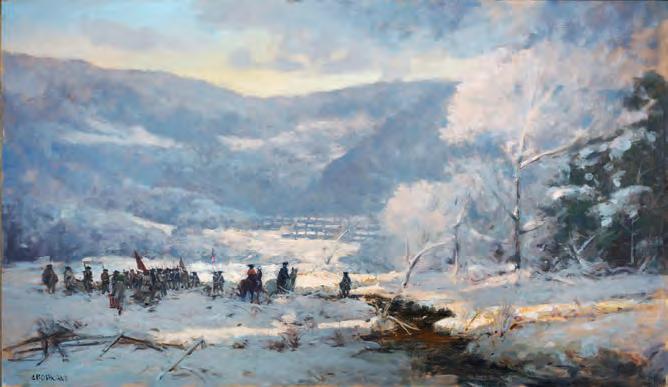

Left: News from America by George H. Boughton, oil on canvas,
MARCH 14–APRIL 27
J.M. Stringer is featuring masters of yesterday and today, including John Phillip Osborne, John C. Traynor, and George Henry Boughton, in its exhibition “History in the Making.” Osborne is known for his study of the infinite effects of light, which he uses to convey the mood of each moment he depicts. Traynor demonstrates the influences of the “old masters,” such as the American tonality painters and the French Impressionists, while imparting his

‘HISTORY IN THE MAKING’ ANDRÉ HAMBOURG
own contemporary techniques. Boughton, who lived from 1833 to 1905, painted many figures in landscapes, particularly peasants at work, along with some historical subjects. Stop by the gallery March 14 to 16 (Thursday 4–8 p.m., Friday and Saturday 11 a.m.–6 p.m.) for the opening.
J.M. Stringer Gallery of Fine Art 3465 Ocean Drive 772-231-3900
jmstringergallery.com
OPENING MARCH 19
Initially set for January, Findlay Galleries’ exhibition of works by celebrated French artist André Hambourg (1909–1999) is now scheduled to open March 19. Working en plein air, he painted scenes that sometimes included crowds of people in Paris, Trouville in Normandy, and as far afield as the markets of Jerusalem, the Maghreb region of Northern Africa, and Abidjan in the Ivory Coast. He also found inspiration in the water and skies of the centuries-old port town of Honfleur as well as London, Venice, and Istanbul. He served as a military correspondent with the French army and later became the official painter of the French navy.
Findlay Galleries
165 Worth Ave., Palm Beach 561-655-2090 findlaygalleries.com
Above: The Epic Heroism of Jockey Hollow by John Phillip Osborne, oil on canvas, 30 x 50 inches
42 x 55 inches
MARCH 2024 189
Le plage, apres midi by André Hambourg, oil on canvas, 8 7/8 x 13 3/4 inches
GALLERY GUIDE
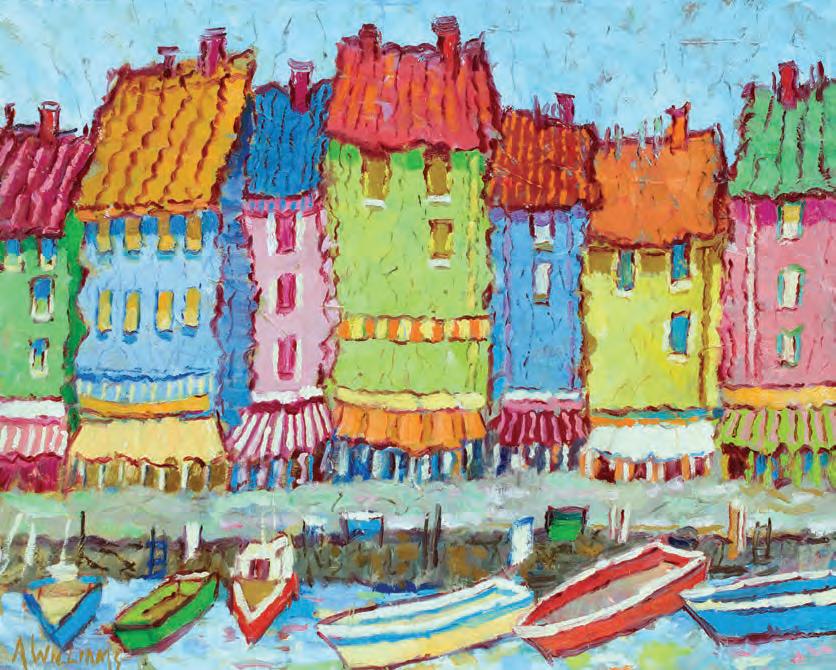
ART AT THE EMERSON
The Emerson Center’s gallery shows works by local artists in six themed exhibitions per year.
1590 27th Ave. 772-778-5880 artattheemerson.com
ARTISTS GUILD GALLERY
This cooperative-owned fine art gallery offers works in diverse styles and media by its ownerartists as well as associate and consignor artists.
1974 14th Ave. 772-299-1234 artistsguildgalleryofvero beach.com
ART WORKS
Various U.S. artists are featured, representing a range of styles. Classes, art parties, and other events are available.
2036 14th Ave., Suite 106 772-559-5230 artworksofvero.com
ENVIRONMENTAL LEARNING CENTER
The Lagoon and Tidal Rooms are dedicated to nature-related art.
255 Live Oak Drive 772-589-5050 discoverelc.org
FINDLAY GALLERIES
Renowned globally for its distinguished roster of contemporary and abstract artists, the gallery specializes in 19th- and 20th-century Impressionism, European Modernism, l’Ecole de Rouen, l’Ecole de Paris, and 20thcentury American art.
165 Worth Ave., Palm Beach 561-655-2090 findlaygalleries.com
THE GALLERIES AT FIRST PRES
This venue displays the works of local artists in quarterly threeartist installments.
520 Royal Palm Blvd. 772-562-9088 firstpresvero.org
GALLERY 14
The gallery features a diverse array of works in a variety of media by its eight owner-artists, along with eight represented artists and rotating monthly guests.
1911 14th Ave. 772-562-5525 gallery14verobeach.com
THE GALLERY AT WINDSOR
This independent art space annually invites curators of museum-quality shows of contemporary art.
3125 Windsor Blvd. 772-388-4071 windsorflorida.com/the-gallery
GALLERY VERITAS
This gallery has periodic exhibitions and adjoins a working studio housing seven artists and an art library.
1422 20th St. 323-547-1188 thegalleryveritas.com
J.M. STRINGER
GALLERY OF FINE ART
The gallery offers worldwide collections of original paintings, objets d’art, sculptures, and select antique furnishings.
3465 Ocean Drive 772-231-3900
jmstringergallery.com
THE LAUGHING DOG GALLERY
The vast showroom offers works from more than 350 contemporary American craftsmen who create art glass, ceramics, sculpture, furniture, and fine art jewelry.
2910 Cardinal Drive 772-234-6711
thelaughingdoggallery.com
MAIN STREET VERO BEACH STUDIOS AND GALLERY
The handcrafted jewelry of Clair Brunetti, who creates custom works and repairs and updates older pieces, is showcased.
2036 14th Ave.
772-643-6782
mainstreetverobeach.org
MEGHAN CANDLER GALLERY
This friendly, uplifting gallery has a beautifully curated collection of paintings by more than 40 contemporary artists of the abstract, Impressionist, and realistic styles.
6160 Hwy. A1A
Village Shops 772-234-8811
meghancandlergallery.com
OCEAN DRIVE GALLERY
The oil abstracts of Elise Geary and representational narrative paintings by Jill Kerwick are featured, along with acrylic rural and outdoor scenes and seascapes by two additional artists.
3349 Ocean Drive, Suite 8 772-579-7667
eliseartist.com
oceandrivegalleryverobeach.com
PALM HOUSE STUDIO & GALLERY
The work of several awardwinning artists is featured, and commissions are welcome.
3227 Ocean Drive, 2nd floor 772-231-6816
palmhousegallery.com
190 VERO BEACH MAGAZINE
Bateaux de Cassis by Alice Williams, oil on canvas, 33 x 41 inches, at Meghan Candler Gallery
RAW SPACE
This innovative alternative cultural venue promotes a spectrum of artistic disciplines
Old Dixie Hwy -artconceptalternative org
SEBASTIAN RIVER ART CLUB
The club offers classes demonstrations workshops and art shows
Main St Sebastian -sebastianriverartclub com
SEVENTH AVENUE STUDIO
The gallery features the abstract art paintings of Rita Barone and the varied works of Janet Kipp Tribus th Ave Barone -Tribus - -
VERO BEACH ART CLUB
This independent nonprofit serves members and the community through education exhibitions social events and monthly meetings with special programs and guest artists
th Ave -verobeachartclub org
VERO BEACH MUSEUM OF ART
The largest accredited art facility on the Treasure Coast VBMA presents international exhibitions from lenders and from its permanent collection also offering classes lectures fi lm studies concerts children’s programs and interactive Art Zone sculpture parks and museum store
Riverside Park Drive -vbmuseum org

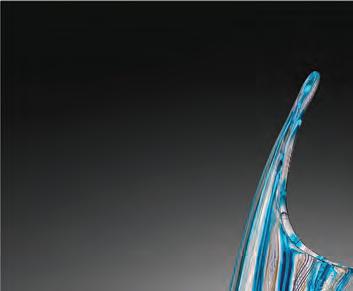






MARCH
artistsguildgalleryofverobeach.com Hibiscus Pelican
1911 14th Avenue, Vero Beach • 772.562.5525 • gallery14verobeach.com GALLERY HOURS: Tuesday-Friday 10am–5pm, Saturday 10am–4pm g a l l e r y 14 March 1–29 | Reception: Friday, March 1, 5–8pm A SUMMER BREEZE by Horatio Lertora & Melissa Mastrangelo
Tangerine Surf Van
Filigree Tusk by David Russell, glass, 18 inches high, at The Laughing Dog Gallery






HOME & GARDEN Explore how Hunter Douglas window treatments transform the light in your home by defining the mood of your unique and beautiful space. We have an intelligent shade design for whatever you need or desire. Additionally, let one of our master craftsmen create custom draperies, reupholster a treasured heirloom or recover the cushions of your watercraft and outdoor furniture. Gallery ® Visit Our New Showroom UPHOLSTERY | FABRIC | DRAPERIES WE’VE TRANSFORMED OUR SHOWROOM . Stop in to learn how we can help you transform your home. Heritance® Hardwood Shutters 1865 Wilbur Avenue | Vero Beach, FL 32960 772-567-1210 | rothinteriorswindowfashions.net Open Monday – Friday from 9:00am to 4:30pm Prepare for hurricane season early, and relax later. Storm Shutters, Gates, and Awnings Showroom & Factory • 1055 Commerce Ave., Vero Beach Toll Free (800)741-2202 • (772) 569-2200 • www.floridashuttersinc.com dansfancity.com 1127 US HWY 1, Vero Beach

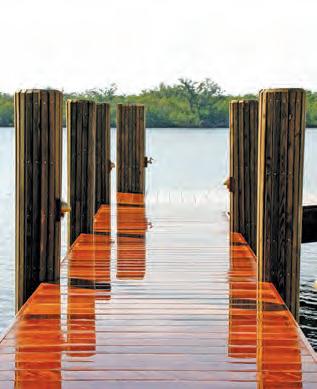




HOME & GARDEN IMPACT WINDOWS & DOORS IMPACT WINDOWS & DOORS Vero Beach: 772.567.7461 www.HBSglass.com Email: info@HBSglass.com Proudly Serving Florida’s East Coast Since 1973 722 Third Place (Old Dixie & Third Place) • Custom windows and doors • Impact windows and doors • Custom shower doors • Window replacement specialists • ALL YOUR GLASS NEEDS • Featuring Competitive Pricing and utilizing our own EXPERT INSTALLERS locally for over 45 years! • Professional Service Before, During, and After Every Sale! Docks • Dune Crossovers • Seawalls • Boat Lifts • Service • Marine Permitting 772-559-8629 Licensed and Insured www.deckmastersmarine.com GOLF COURSE CONSTRUCTION Serving Indian River County for over 19 years







HOME & GARDEN CELEBRATING Over 40 Years of Service 1622 91 st Court | Vero Beach, FL 32966 | CoastalVanLines.com Serving Vero Beach since 1981 LOCALLY FAMILY OWNED & OPERATED FULL SERVICE MOVING & AC STORAGE 772-569-6683 (MOVE) Specializing in: • Fine Art • Designer Services • Estate Moving 1936 Commerce Ave. Vero Beach 772.562.2103 825 US #1 Sebastian 772.589.9899 Call us about our 10 year parts and LABOR warranty! RESIDENTIAL COMMERCIAL We Service All Makes And Models. SALES • SERVICE • REPAIR • INSTALLATION We keep you COOL State Lic. #CAC057252 & RAC044628
Maximizing March
COMMUNITY EVENTS ARE AT FULL THROTTLE THIS MONTH
TUnder the Oaks
The Vero Beach Art Club’s 73rd annual Under the Oaks fine arts and craft show, the group’s major fundraiser and one of our most popular local events, will take place at Riverside Park March 8–10. More than 200 artists from far and wide will be displaying their paintings, sculpture, jewelry, and much more in this juried show attended by some 60,000 visitors over three days.
Friday and Saturday hours are 9 a.m. to 5 p.m., and Sunday hours are 10 a.m. to 4 p.m. Admission is free, and lots of food trucks will be on hand. Find all the information you need at verobeachartclub.org. The Art Club can also be reached at 772-231-0303.

TFirefighters’ Fair
It’s time for the 44th annual Indian River County Firefighters’ Fair, which will take place at the county fairgrounds (7955 58th Ave.) March 8–17


This year’s theme is “Lights, Sirens, and Smiles”; among the highlights are two concerts: Dillon Carmichael on Saturday, March 9 at 7 p.m. and Eddie Montgomery of Montgomery Gentry on Sunday, March 10 at 7 p.m. In addition to the rides and food, the 10-day event will include magic shows, a cowboy circus, a demolition derby, youth livestock and agriculture events, and the always-popular firefighter training shows for children. The fair opens at 5 p.m. on weekdays and 1 p.m. on weekends. For more information, check out the fair’s new and improved website, firefightersfair.org, or call 772-571-FAIR (3247).

Car Show
For the 45th year, the Indian River Region of the Antique Automobile Club of America will hold its massive car show, with awards in 16 classes in addition to Best in Show. Take a walk down automotive memory lane March 16 at Riverside Park from 10 a.m. to 4 p.m. More than 300 vehicles are expected, along with a DJ, food trucks, a 50/50 raffle, and a silent auction. The car show is free to attend. The contact information is 772-584-1842 and indianriver.aaca.com
MARCH 2024 195 CALENDAR
TERESA LEE RUSHWORTH
KELLY ROGERS
Eddie Montgomery
CALENDAR
MARCH 4
KARL ROVE
The Distinguished Lecturer Series presents political pundit and author Karl Rove. 4 and 6 p.m.; Stark Main Stage $102, Waxlax Theatre simulcast $87
Riverside Theatre
3250 Riverside Park Drive
772-231-6990
riversidetheatre.com
MARCH 6
QUEEN CONCH
Research professor Megan Davis presents a lecture titled “Celebrating the Queen Conch: A Journey of Restoration with Caribbean Communities.” Registration is required. 4 p.m., free
FAU Harbor Branch
Oceanographic Institute
5600 N. U.S. Hwy. 1, Fort Pierce 772-242-2293
fau.edu/hboi
MARCH 8
9 TO 5: THE MUSICAL
Based on the 1980 movie, this show features music by Dolly Parton and book by Patricia Resnick. Through March 24; Fridays 7:30 p.m., Saturdays 2 and 7:30 p.m., Sundays 2 p.m.; $35–$40
Vero Beach Theatre Guild 2020 San Juan Ave.
772-562-8300
verobeachtheatreguild.com
MARCH 9
CARE NET CAR SHOW
Care Net Pregnancy Center now has a car show! 9 a.m. registration, 10 a.m.–2 p.m. show; free to attend
Care Net Pregnancy Center of IRC at Vero Christian Church 3250 9th St. SW (Oslo Road) 772-569-7939
carenetchampions.org
PLAYTIME IN THE PARK
Bring the little ones to Riverside Park for the 30-minute theatercentered educational program “Spring Tales.” March’s dance component, “Leaping into Literacy,” will take place March 16. 11 a.m., free
Riverside Theatre
3250 Riverside Park Drive 772-231-6990
riversidetheatre.com
SUNSET SATURDAY
Glory Days will play classics from the ’60s through the ’90s. 5–8 p.m., free Vero Beach Chamber of Commerce at Ocean Drive by Humiston Park 772-226-5459 verochamber.com
DAVE MASON
Prolific singer-songwriter and guitarist Dave Mason, formerly of the band Traffic, will perform his hits from the ’60s, ’70s, and beyond. 8 p.m., $47.50–$67.50
Sunrise Theatre
117 S. 2nd St., Fort Pierce 772-461-4775 sunrisetheatre.com
MARCH 10
‘THE 20TH CENTURY’
In keeping with its numerical theme for this season, Treasure Coast Chorale will perform songs by the decades in the concert “The 20th Century: A Musical Extravaganza.” 4 p.m., donations accepted Treasure Coast Chorale at First Baptist Church 2206 16th Ave. treasurecoastchorale.org
BREVARD SYMPHONY
With Paul Huang as guest violinist, the BSO will perform Mozart’s Overture to The Magic Flute; Korngold’s Violin Concerto in D Major, Op. 35; and Modest Mussorgsky’s Pictures at an Exhibition . 7:30 p.m., $85–$90
Indian River Symphonic Association at Community Church of Vero Beach 1901 23rd St. 772-778-1070 irsymphonic.org
MARCH 11
‘THE EARL & THE PHARAOH’
Lady Fiona, the Eighth Countess of Carnarvon, presents “The Earl & the Pharaoh: The Discovery of Tutankhamun,” a lecture on famed Egyptologists Lord Carnarvon and Howard Carter. 4:30 p.m.; $130 members/$158 nonmembers; streaming or Leonhardt Auditorium simulcast $80 members/$95 nonmembers
Vero Beach Museum of Art 3001 Riverside Park Drive 772-231-0707 vbmuseum.org

Kyiv Virtuosi Symphony
TOn March 25, the Indian River Symphonic Association welcomes Dmitry Yablonski and the Kyiv Virtuosi Symphony Orchestra. This 19-piece ensemble of Ukrainian musicians was formed in 2016 and is now based in Chieti, Italy. Young Israeli pianist Alon Kariv will be the featured soloist. Selections will include the Overture from Crystal Palace by Alexey Shor; Piano Concerto No. 2 in A Major by Franz Liszt; and Symphony No. 8 in G Major, Op. 88 by Antonín Dvorák. The concert will take place at Community Church of Vero Beach (1901 23rd St.) at 7:30 p.m. Tickets are $95–$125. For more information, call 772-778-1070 or see irsymphonic.org
ROCK THE BOAT
YSF’s Rock the Boat benefit gala will include a regatta, dinner, an open bar, a raffle, and a live auction. 5 p.m., $225
YSF Community Sailing at Quail Valley River Club 2345 Hwy. A1A 772-492-3243 ysfirc.org
MARCH 12
HISTORY LECTURE
The E-series (Engage, Educate, Entertain) presents author Michael Tougias with a talk on the 1945 sinking of the USS Indianapolis 7 p.m., free
The Emerson Center 1590 27th Ave. 772-778-5880
theemersoncenter.com
196 VERO BEACH MAGAZINE
MICHAEL PAVIA
Alon Kariv
MARCH 13
ARTIST MEET & GREET
The ELC will hold a meet and greet for the Orchid Island Art Club Member Show, which will run through the end of May. 4:30–6:30 p.m., free
Environmental Learning Center 255 Live Oak Drive
772-589-5050 discoverelc.org
GISELLE
Members of the Grand Kyiv Ballet will perform the 19th-century romantic tragedy Giselle. 7:30 p.m., $79–$107
Sunrise Theatre
117 S. 2nd St., Fort Pierce 772-461-4775 sunrisetheatre.com
MARCH 14
ANGELS DINNER
The Boys & Girls Clubs will hold their major fundraiser at the Vero Beach club. In addition to cocktails and dinner, guests will meet BGCIRC members and learn about
their activities at the three Indian River County clubs. 6 p.m., $500 Boys & Girls Clubs of IRC 1729 17th Ave.
772-299-7449 bgcirc.org
WINE & DESIGN
The Art Club invites aspiring painters to bring refreshments and join instructor Christine Thomas in creating their own versions of Blue Heron on Wood Sign . 6–8:30 p.m., $55 members/$65 nonmembers
Vero Beach Art Club
1903 14th Ave.
772-217-3345 verobeachartclub.org
CORK, CANVAS, & COMPANY
Camy DeMario will lead a fun class in painting Mermaid Dreams Participants are welcome to bring beverages and snacks; all art supplies are provided. 6:30–8:30 p.m., $45
Vero Beach Museum of Art 3001 Riverside Park Drive 772-231-0707 vbmuseum.org

Boys & Girls Clubs Angels Dinner, March 14
THE SIXTIES SHOW
This Broadway-style multimedia production revisits the 1960s, with musicians performing a wide selection of hits from that momentous period in musical history. 7 p.m., $45–$90
MusicWorks
at The Emerson Center 1590 27th Ave.
800-595-4849 musicworksconcerts.com
RECURRING EVENTS
EVERY SATURDAY FARMERS MARKET
Browse the wares of more than two dozen vendors at the Vero Beach Farmers Market, at the corner of Ocean Drive and Dahlia Lane. 8 a.m.–noon
Business Inspiring Kindness 2901 Ocean Drive verobeachfarmersmarket.com
EVERY FIRST FRIDAY
FIRST FRIDAY GALLERY STROLL
Pop into some art galleries and then enjoy a beverage and a bite at a restaurant or café. March 1 and April 5, 5–8 p.m.
Main Street Vero Beach Downtown along 14th Avenue 772-643-6782
mainstreetverobeach.org
EVERY LAST FRIDAY
DOWNTOWN FRIDAY
Enjoy a community street party with live music, street vendors, and food trucks. March 29, 6–9 p.m., free
Main Street Vero Beach Downtown along 14th Avenue 772-643-6782
mainstreetverobeach.org
EVERY LAST SATURDAY
VBMA FREE ADMISSION
Admission is free for everyone on the last Saturday of each month. March 30, 10 a.m.–4:30 p.m.
Vero Beach Museum of Art 3001 Riverside Park Drive 772-231-0707
vbmuseum.org
MARCH 15
LOVE OF LITERACY LUNCHEON
Author Will Schwalbe will join Literacy Services in celebrating its Students of the Year and promoting local literacy efforts. 11:30 a.m.–1:30 p.m., $150 Literacy Services of IRC at Bent Pine Golf Club 6001 Clubhouse Drive 772-778-2223 literacyservicesirc.org
JAZZ UNDER THE STARS
Bring a chair or blanket and enjoy the sounds of David Mundy and the Indian River Charter High School Jazz Ensemble at this event funding affordable housing for local seniors. 6–8:30 p.m., $50
St. Francis Manor 1750 20th Ave. 772-562-8575 stfrancismanor.org
PELICAN ISLAND NWR ANNIVERSARY
Celebrate the 121st anniversary of the United States’ first national wildlife refuge, right here in our
own backyard. President Theodore Roosevelt himself (Joe Wiegand) will be on hand to mark the occasion. Through March 17; see website below for all times, costs, and locations
Pelican Island Conservation Society
firstrefuge.org/anniversary
MARCH 16
DOG PARK ANNIVERSARY
It’s been a decade at the dog park! VBDP is planning its 10th anniversary program. 11 a.m., free
Vero Beach Dog Park 3449 Indian River Drive E. verobeachdogpark.org
‘THROUGH THEIR EYES’
Ballet Vero Beach and VBMA join to present “Through Their Eyes: Choreographic Impressions from Foreign Lands.” 3 p.m., $30 members/$36 nonmembers
Vero Beach Museum of Art 3001 Riverside Park Drive 772-231-0707
vbmuseum.org
BLUE JEANS & BBQ
Special Equestrians invites everyone to its barn for this fundraiser catered by 14 Bones. Guests will enjoy music, barbecue, beer and wine, a silent auction, a pony parade, and a student riding demo. 5:30 p.m., $125
Special Equestrians of the Treasure Coast 7065 37th St. 772-562-7603
specialequestrianstreasurecoast.org
MARCH 2024 197
CALENDAR

INTERNATIONAL MUSIC
FESTIVAL
Cellist and vocalist Mike Block will perform a solo show as part of a cross-cultural music series. 7:30 p.m., $25
First Presbyterian Church 520 Royal Palm Blvd. verobeachinternationalmusicfestival.
com
THE HIT MEN
The five musicians of The Hit Men perform songs made famous by the many artists they have played with in the studio and onstage over the decades. 8 p.m., $39.50–$59.50
Sunrise Theatre
117 S. 2nd St., Fort Pierce 772-461-4775
sunrisetheatre.com
FLOWER SHOW
If you enjoy viewing exquisite flower arrangements and horticulture plants, you’ll want to attend the Garden Club’s Flower Show. The theme is “Hidden Treasure.” Also March 17; Saturday 12:30–4:30 p.m., Sunday noon–4 p.m.; free Garden Club of IRC 2526 17th Ave. 772-567-4602
gardenclubofirc.org
MARCH 19
ACADEMY OF ST. MARTIN IN THE FIELDS
The Symphonic Association welcomes the Academy of St. Martin in the Fields, with its world-

Left: Vero Beach Dog Park 10th anniversary, March 16
Above: Pelican Island National Wildlife Refuge 121st anniversary, March 15
renowned music director, Joshua Bell, as violin soloist. Selections include works by Rossini, Bruch, and Brahms. 7:30 p.m., $95–$125
Indian River Symphonic Association at Community Church of Vero Beach 1901 23rd St. 772-778-1070 irsymphonic.org
YANKEE TAVERN
This 2007 thriller by Steven Dietz will be performed on Riverside’s Waxlax Stage. Through April 7, times vary, $65
Riverside Theatre 3250 Riverside Park Drive 772-231-6990 riversidetheatre.com
MARCH 20
‘TRIOS TRANSFORMED’
Three musicians from the Chamber Music Society of Lincoln Center (pianist Wu Han, violinist and violist Arnaud Sussman, and cellist David Finckel) will play trios by Beethoven and Haydn. 7:30 p.m., $65
Trinity Episcopal Church 2365 Pine Ave. 772-567-1146 chambermusicsociety.org
MARCH 21
CONCERT IN THE PARK
VBMA welcomes jazz pianist Mike Telesmanick for a rain-or-shine outdoor concert. Wine and beer cash bar and Off the Hook food truck will be on-site. Bring a chair. 5–7 p.m.,
$10 members/$12 nonmembers
Vero Beach Museum of Art 3001 Riverside Park Drive 772-231-0707 vbmuseum.org
‘BEATLES VS. STONES’
Tribute bands Abbey Road and Satisfaction face off. 7 p.m., $45–$95
MusicWorks
at The Emerson Center 1590 27th Ave. 800-595-4849
musicworksconcerts.com
‘LATIN PASSIONS’
The ACO will perform Bizet’s Carmen Suite No. 1, The Four Seasons of Buenos Aires by Astor Piazzolla, and The Three-Cornered Hat by Manuel de Falla. 7:30 p.m., $30–$65
Atlantic Classical Orchestra at Community Church of Vero Beach 1901 23rd St. 772-460-0851
atlanticclassicalorchestra.com
SWEET CHARITY
The performing arts students of IRSC present the musical comedy Sweet Charity, with music by Cy Coleman and book by Neil Simon. Through March 24; Thursday–Friday 7 p.m., Saturday–Sunday 2 p.m.; $20
McAlpin Fine Arts Center 3209 Virginia Ave., Fort Pierce 772-462-4750
irsc.edu
MARCH 23
NIGHT SOUNDS
The band St. John’s Wood will take the stage at the pavilions, and food trucks will be on hand. 6–9 p.m., regular park admission fees apply Friends of Sebastian Inlet State Park 14251 Hwy. A1A 772-589-2147
friendsofsebastianinletstatepark.org
MARCH 24
ART IN THE PARK
Members of the Art Club will be displaying their creations, which will be available for purchase. Also April 7; 10 a.m.–4 p.m.; free
Vero Beach Art Club at Humiston Park 3000 Ocean Drive 772-217-3345
verobeachartclub.org
‘SINATRA, MARTIN & MORE’
Vocalist and 2004 American Idol finalist John Stevens will join SCSO’s jazz ensemble to perform “My Way,” “Fly Me to the Moon,” and many more favorites. 3 p.m., flexible pricing
Space Coast Symphony Orchestra at The Emerson Center 1590 27th Ave. 855-252-7276
spacecoastsymphony.org
‘SCENES FROM ZARZUELAS’
Singers, dancers, and musicians come together to present stories in the distinctly Spanish genre of the zarzuela. 3 p.m., $15–$100
198 VERO BEACH MAGAZINE
BOB JOY
KELLY ROGERS
THROUGH MARCH
KINKY BOOTS
This show features music by Cyndi Lauper and book by Harvey Fierstein, based on the 2005 British fi lm wri en by Geoff Deane and Tim Firth. Times vary, $45–$105
Riverside Theatre 3250 Riverside Park Drive 772-231-6990 riversidetheatre.com
Vero Beach Opera at VBHS Performing Arts Center th St -verobeachopera org
MARCH
SRA BINGO LUNCHEON
Senior Resource Association will hold its th annual Bingo Luncheon
The theme is “Solid Gold Country ” so dress accordingly if you have a hankerin’ to a m – p m
Senior Resource Association at Oak Harbor Clubhouse S Harbor Drive -seniorresourceassociation org
MARCH
CHICAGO TRIBUTE
Live! from Vero Beach presents
Beginnings a seven-piece Chicago tribute band p m –
MusicWorks at The Emerson Center th Ave -musicworksconcerts com
MARCH
TIPSY TURTLE
Support turtle-friendly initiatives by participating in the Tipsy Turtle -mile run/walk which will include postrace food beverages and activities – a m –
Coastal Connections at Jaycee Beach Park Ocean Drive - -
coastal-connections org
APRIL
HARBOR BRANCH TALK
Professor Colin Polsky will discuss Florida Atlantic University’s new School of Environmental Coastal and Ocean Sustainability ECOS Preregistration is required p m free
FAU Harbor Branch
Oceanographic Institute N U S Hwy Fort Pierce - -
fau edu/hboi
‘OWLS DON’T WALK’
The Sunrise welcomes comedian and actor Kevin James best known for his work on the television series The King of Queens p m –
Sunrise Theatre S nd St Fort Pierce -sunrisetheatre com

















MARCH
ONGOING
Beginnings, March 28 Commercial and Residential Services 5555 US-1 Vero Beach, FL 32967 www.meeksplumbing.com If It Leaks, Call Meeks. Installation, repair, and maintenance of your water heaters, toilets, bathtubs, septic tanks, and much more! 24 hours-a-day, 7 days-a-week (772) 569-2285 RECYCLERIGHT! 4 How to Dispose of BaTTERIEs Single-use alkaline batteries such as 9 volt, C, D, AA, and AAA are safe to dispose of with your regular trash. LITHIUM BATTERIES should NEVER be placed in your recycling OR garbage carts! For more info visit ircrecycles.com or call 770-5112 Avoid Confusion at the Cart! Download the “CARTer’s Corner” APP today! To learn more, call 772-226-3212 or visit indianriver.gov. Lithium batteries, such as rechargeable, cell phone and laptop batteries, and other hazardous household batteries are highly flammable and should NOT be put in a cart. Please bring them to one of the 5 Customer Convenience Centers or to the Main County Landfill. Computer too slow? • Sales & Service • Training • Mac & Windows 4881 North A1A, Vero Beach 772-234-1555 www.autobahnco.com We can help!
EVENTS
CALENDAR
APRIL 4
‘ONE NIGHT IN MEMPHIS’
This show recreates the Dec. 4, 1956 event that saw Elvis Presley, Carl Perkins, Johnny Cash, and Jerry Lee Lewis jamming together at Sun Studios. 7 p.m., $45–$100
MusicWorks
at The Emerson Center 1590 27th Ave. 800-595-4849 musicworksconcerts.com
‘CURTAIN CALL CLASSICS’
IRSC’s jazz and wind ensembles present a concert of jazz, film, and Broadway selections. Through April 6; Thursday–Friday 7 p.m., Saturday–Sunday 2 p.m.; $20
McAlpin Fine Arts Center 3209 Virginia Ave., Fort Pierce 772-462-4750 irsc.edu
APRIL 6
WALK FOR LIFE
Care Net will hold its 40th annual Walk for Life in support of its services to women facing unplanned pregnancies. 8 a.m., entry is free (donors may sponsor walkers)
Care Net Pregnancy Center of IRC at Riverside Park 3280 Riverside Park Drive 772-569-7939 carenetchampions.org
CRAFT SPIRITS FESTIVAL
Distilleries from all over Florida will be represented at the Treasure Coast Craft Spirits Festival benefiting Sunrise Rotary Vero Beach. 2–6 p.m.; $100 general admission (must be age 21 or over) includes unlimited tasting, souvenir glass, appetizers, and bottled water; $30 designated driver ticket (must be 18 or over) includes appetizers and bottled water
Treasure Coast Craft Spirits Festival at Airport Drive treasurecoastspiritsfestival.com

Event co-chairs Ann Cathleen Egan Cronin, Pamela Larrick, and Susan Kintner
Blue Ribbon Luncheon
Hibiscus Children’s Center’s Blue Ribbon Luncheon & Fashion Show, scheduled for 11 a.m. April 3, will be held at Oak Harbor Clubhouse (4755 S. Harbor Drive). This year’s theme is “Up, Up & Away.” Professional models will be sporting the latest fashions from local boutiques, and guests will also enjoy a gourmet lunch and silent auction. Tickets are $175; proceeds help build a brighter future for the teens at Hibiscus House, who have experienced abuse and/or neglect. Further information can be obtained at 772-299-6011, ext. 313 and hibiscuschildrenscenter.org.

200 VERO BEACH MAGAZINE
E S T A B L I S H E D 1 9 7 5 INTERIOR DESIGN STUDIO
ROYAL PALM POINTE,
65
SUITE C 772-770-6007


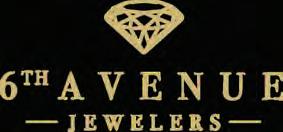

MIRACLE MILE Vero Beach, FL UNUSUAL VENUES • INSPIRED MENUS (772) 563-0646 www.elizabethkennedycatering.com Entertaining with style & distinction for over 39 years. Fresh-Baked Hot Cross Buns Happy Easter! • 2207 7th Avenue, Miracle Mile West Plaza • (772) 778-8919 • consignmentgalleryverobeach.com Featuring the finest gently used brand name consignment home furnishings for your living room, dining room, and bedrooms. 2040 Treasure Coast Plaza, Vero Beach, FL 32960 772-217-8985 www.6thAvenueJewelers.com Happy St. Patrick’s Day!
The Directory
202 VERO BEACH MAGAZINE BUSINESS DIRECTORY ARCHITECTS MOULTON LAYNE PL 772-234-0445 moultonlayne.com 31 AR T GALLERIES & FINE ART ARTISTS GUILD GALLERY 772-299-1234 artistsguildgalleryofverobeach.com 191 ART MIAMI artpbfair.com ............................ 53 FIN DLAY GALLERIES 561-655-2090 findlaygalleries.com 13 GA LLERY 14 772-562-5525 gallery14verobeach.com ................. 191 J .M. STRINGER GALLERY OF FINE ART 772-231-3900 jmstringergallery.com 28 T HE LAUGHING DOG GALLERY 772-234-6711 thelaughingdoggallery.com 26 , 86 MEGHAN CANDLER GALLERY 772-234-8811 meghancandlergallery.com 187 O CEAN DRIVE GALLERY 772-579-7667 oceandrivegalleryverobeach.com 174 P ROVIDENT FINE ART 561-833-0550 providentfineart.com 21 SE VENTH AVENUE STUDIO 772-359-6283 .......................... 179 V ERO BEACH ART CLUB 772-231-0303 verobeachartclub.org 157 V ERO BEACH MUSEUM OF ART 772-231-0707 vbmuseum.org .......................... 159 ATTORNEYS GOULD COOKSEY FENNELL 772-231-1100 gouldcooksey.com 44 LULICH & ATTORNEYS 772-589-5500 lulich.com 15 RO SSWAY SWAN 772-231-4440 rosswayswan.com 48 AU TOMOTIVE SALES & SERVICES LINUS CADILLAC BUICK GMC 772-562-1700 linuscadillac.com 171 M OTOR CITY CLASSIC CARS SERVICE 772-252-3590 motorcityclassiccars.com 155 AVIATION SERVICES CORPORATE AIR 772-562-1199 corporate-air.com 138 BANKING, INVESTMENTS, & FINANCIAL PLANNING GLENMEDE PRIVATE WEALTH 561-571-4917 glenmede.com 96 ME RRILL LYNCH WEALTH MANAGEMENT SHAMBO | SCHWIBNER | SCHWARTZ 772-231-9051 fa.ml.com/shamboschwibner 77 WI LMINGTON TRUST 772-234-1700 wilmingtontrust.com 55 BE AUTY, HAIR, & SPA SERVICES JESSYCA’S BEAUTY STUDIO jessycasbeautystudio.com 158 M IND AND BODY OF VERO 772-400-2020 mindandbodyofvero.com 150 SALON DEL MAR 772-234-1499 187 B OATING & MARINE SERVICES DECKMASTERS LLC 772-559-8629 deckmastersmarine.com 193 V ERO MARINE CENTER 772-562-7922 veromarine.com 138 B RIDAL & GIFT REGISTRIES 6TH AVENUE JEWELERS 772-217-8985 6thavenuejewelers.com 201 L EIGH JEWELERS 772-234-8522 leighjewelers.com 19, 145, 175 M. MAISON 772-231-4300 mmaisonvero.com 143 R OYAL PALM JEWEL 772-766-3165 royalpalmjewel.com 156 TR IMMINGS 772-213-8069 shoptrimmingsvb.com 146 VE RANDA 772-234-3404 verandajewelry.com 1 CATERING & GOURMET MARKETS ALIMENTARI GOURMET MARKET 772-999-5483 alimentarigm.com 187 E LIZABETH D. KENNEDY & COMPANY INC. 772-563-0646 elizabethkennedycatering.com 201
THANK YOU FOR SUPPORTING OUR LOCAL BUSINESSES

MARCH 2024 203 COMPUTERS & AUDIOVISUAL CONSULTING AUTOBAHN COMMUNICATIONS INC. 772-234-1555 autobahnco.com ........................ 199 CO NSTRUCTION & BUILDING SERVICES AR HOMES/BEACHLAND HOMES CORP. 772-492-4018 arhomes.com 70 CA L BUILDERS 772-562-3715 calbuildersinc.com ........................ 41 CR OOM CONSTRUCTION COMPANY 772-562-7474 croomconstruction.com . . . . . . . . . . . . . . . . . . . 5 DECKMASTERS LLC 772-559-8629 deckmastersmarine.com ................ 193 DE SIGNER’S TOUCH FLOORING 772-978-9111 designerstouchflooring.com 4 E MILY ROSE INTERIORS, DESIGN + BUILD 772-321-7868 emilyroseinteriors.com .................. 150 H BS GLASS 772-567-7461 hbsglass.com 193 H URYN CONSTRUCTION 772-234-4130 hurynconstruction.com 33 KMK BUILDERS 772-643-1353 kmkbuildersllc.com 63 RC L DEVELOPMENT 772-234-0140 rcldev.com 61 REI LLY CONSTRUCTION 772-794-9799 building2last.com 27 T. H. WHITFIELD CONSTRUCTION INC. 772-696-3736 thwhitfieldconstruction.com 48 VE RO BEACH ROOFING INC. 772-770-3782 verobeachroofing.com 147 V ERO GLASS 772-567-3123 veroglass.com 79 VERO MILLWORK INC. 772-569-7155 veromillwork.com 11 COU NTY SERVICES INDIAN RIVER COUNTY SOLID WASTE DISPOSAL DISTRICT 772-226-3212 indianriver.gov 199 FASHION & ACCESSORIES COOPER & CO. 772-231-9889 149 G . MATHEOS EYEWEAR 772-492-6400 ......................... 186 ILINEN 772-321-3262 ilinenlifestyle.com 144 K EMP’S SHOE SALON AND BOUTIQUE 772-231-2771 kempsshoesalon.com ................... 175 M . MAISON 772-231-4300 mmaisonvero.com 143 MU SE 772-321-5535 museverobeach.com 179 KELLY ROGERS

204 VERO BEACH MAGAZINE PALM BEACH SANDALS 772-226-5998 palmbeachsandals.com 175 R OYAL PALM JEWEL 772-766-3165 royalpalmjewel.com 156 S ASSY BOUTIQUE 772-234-3998 2, 3 V ERNON SCOTT RESORT WEAR MEN & WOMEN 772-231-3733 vernonscott32963.com 174 V ILLAGE SHOPS 772-231-1066 villageshopsverobeach.com 141 F LOORING DESIGNER’S TOUCH FLOORING 772-978-9111 designerstouchflooring.com 4 FLORIDA FLOOR FASHIONS 772-589-4994 floridafloorfashions.com 71 TI LE MARKET & DESIGN CENTER OF VERO BEACH 772-978-1212 tilemarketverobeach.com ............... 182 FURNITURE & ACCESSORIES COASTAL COMFORTS 772-226-7808 coastal-comforts.com 186 CONSIGNMENT GALLERY 772-778-8919 consignmentgalleryverobeach.com 201 DAN’S FAN CITY 772-569-8917 dansfancity.com 192 E UROPEAN KITCHEN & BATH 772-770-9970 europeansink.com ...................... 183 FALASIRI ORIENTAL RUGS 772-562-0150 falasiriorientalrugs.com 72 FA NTASTIC FINDS 772-794-7574 fantastic-finds.com ..................... 183 T HE LAUGHING DOG GALLERY 772-234-6711 thelaughingdoggallery.com 26 , 86 LED CAPSTONE LIGHTING & FAN SHOWROOM 772-205-2529 ledcapstone.com 182 L .K. DEFRANCES & ASSOCIATES INTERIOR DESIGN 772-234-0078 lkdefrancesandassociates.com 22 M. MAISON 772-231-4300 mmaisonvero.com 143 PAGE 2 DESIGN 772-492-9220 page2design.net 39 S UNSHINE FURNITURE 772-569-0460 sunshinefurniturecasual.com 29 TR IMMINGS 772-213-8069 shoptrimmingsvb.com 146 V B HOME 772-492-9348 vbhome.us 25 GI FTS, STATIONERY, & KEEPSAKES COASTAL COMFORTS 772-226-7808 coastal-comforts.com 186 T HE DANDY LION GIFTS & THRIFTS 772-774-8449 dandyliongiftsandthrifts.com 97 DI GG GARDENS PLANT SHOP 772-360-2131 digggardens.com 154 T HE LAUGHING DOG GALLERY 772-234-6711 thelaughingdoggallery.com 26 , 86 M. MAISON 772-231-4300 mmaisonvero.com 143 NOTEWORTHY BY DESIGN 772-231-0085 187 TR IMMINGS 772-213-8069 shoptrimmingsvb.com 146 VE RANDA 772-234-3404 verandajewelry.com 1 VI LLAGE SHOPS 772-231-1066 villageshopsverobeach.com 141 H OME PRODUCTS & SERVICES BARKER AIR CONDITIONING & HEATING 772-562-2103 barkerac.com 194 BUSINESS DIRECTORY GRIDLEY + GRAVES

MARCH 2024 205 CERAMIC MATRIX 772-778-7784 ceramicmatrix.com 46 DECKMASTERS LLC 772-559-8629 deckmastersmarine.com 193 E UROPEAN KITCHEN & BATH 772-770-9970 europeansink.com 183 F LORIDA SHUTTERS 772-569-2200 floridashuttersinc.com 192 H BS GLASS 772-567-7461 hbsglass.com 193 T HE HOUSE OF LIGHTS & HOME ACCENTS 800-541-3048 thehouseoflights.com 47 LEA H MULLER INTERIORS 772-234-6411 leahmullerinteriors.com 42 LE D CAPSTONE LIGHTING & FAN SHOWROOM 772-205-2529 ledcapstone.com 182 LY RA HOME 772-257-4777 lyrahome.com ........................... 88 ME EKS PLUMBING 772-569-2285 meeksplumbing.com 199 NOR DIC COMFORT HOME FURNISHINGS 772-453-0220 nordiccomfortfurnishings.com ............ 99 ROTH INTERIORS 772-567-1210 rothinteriorswindowfashions.net 192 S UNSHADES OF CENTRAL FLORIDA 407-935-9115 sunshadesofcentralflorida.com ........... 70 TI LE MARKET & DESIGN CENTER OF VERO BEACH 772-978-1212 tilemarketverobeach.com 182 V ERO BEACH ROOFING INC. 772-770-3782 verobeachroofing.com 147 VERO GLASS 772-567-3123 veroglass.com 79 VE RO MILLWORK INC. 772-569-7155 veromillwork.com 11 HOTELS STAYBRIDGE SUITES OF VERO BEACH 772-562-6000 staybridge.com/verobeachfl 179 I NTERIOR DESIGN SERVICES ALEXANDRA NUTTALL DESIGN 772-231-3746 alexandranuttall.com 34 , 35 CERAMIC MATRIX 772-778-7784 ceramicmatrix.com ...................... 46 COA STAL COMFORTS 772-226-7808 coastal-comforts.com 186 COASTAL INTERIORS 772-492-6881 coastal.net ............................. 6, 7 E MILY ROSE INTERIORS, DESIGN + BUILD 772-321-7868 emilyroseinteriors.com 150 I SLAND INTERIORS AT OCEAN REEF 772-770-6007 islandinteriors.net 200 J ENNIFER ELMORE INTERIOR DESIGN 772-569-5522 elmoreinteriors.com 98 LEA H MULLER INTERIORS 772-234-6411 leahmullerinteriors.com 42 L. K. DEFRANCES & ASSOCIATES INTERIOR DESIGN 772-234-0078 lkdefrancesandassociates.com 22 LYR A HOME 772-257-4777 lyrahome.com 88 PAGE 2 DESIGN 772-492-9220 page2design.net 39 PALM BEACH DESIGNER INTERIORS 772-257-6036 palmbeachdesignerfabrics.net 64 , 65 SANDRA MORGAN INTERIORS INC. 772-234-2910 sandramorganinteriors.com 30 SP ECTRUM INTERIOR DESIGN 772-234-4427 spectrumvero.com ..................... 100 T ILE MARKET & DESIGN CENTER OF VERO BEACH 772-978-1212 tilemarketverobeach.com 182 V B HOME 772-492-9348 vbhome.us 25 JE WELRY 6TH AVENUE JEWELERS 772-217-8985 6thavenuejewelers.com 201 T HE LAUGHING DOG GALLERY 772-234-6711 thelaughingdoggallery.com 26 , 86 LEIGH JEWELERS 772-234-8522 leighjewelers.com 19, 145, 175 M. MAISON 772-231-4300 mmaisonvero.com 143 P ROVIDENT JEWELRY 561-833-7755 providentjewelry.com 45 ROYAL PALM JEWEL 772-766-3165 royalpalmjewel.com 156

206 VERO BEACH MAGAZINE BUSINESS DIRECTORY VERANDA 772-234-3404 verandajewelry.com 1 LA NDSCAPING & NURSERIES DIGG GARDENS LANDSCAPE LIGHTING 772-360-2131 digggardens.com 154 R OCK CITY GARDENS 772-589-5835 rockcitygardens.com 160 M EDICAL SERVICES: DENTISTRY DELLA PORTA COSMETIC & RECONSTRUCTIVE DENTISTRY 772-567-1025 drdellaporta.com 84 VE RO ELITE DENTISTRY 772-569-9700 veroelitedentistry.com 151 M EDICAL SERVICES: DERMATOLOGY ICONIC DERMATOLOGY AND COSMETIC SURGERY 772-758-1310 iconicderm.com 83 SE LECT SKIN MD 772-567-1164 selectskinmd.com 87 ME DICAL SERVICES: HOSPITALS CLEVELAND CLINIC INDIAN RIVER HOSPITAL 772-567-4311 ccirh.org ................................ 89 ME DICAL SERVICES: WHOLE HEALTH CARE ISLAND HEALTH CONCIERGE MEDICINE 772-205-6361 islandhealthverobeach.com 81 MOVING, STORAGE, & SHIPPING COASTAL VAN LINES 772-569-6683 coastalvanlines.com 194 N OT-FOR-PROFIT ORGANIZATIONS GIFFORD YOUTH ACHIEVEMENT CENTER 772-794-1005 mygyac.org 58 HUMANE SOCIETY OF VERO BEACH & INDIAN RIVER COUNTY 772-388-3331 hsvb.org 93 IN DIAN RIVER LAND TRUST 772-794-0701 irlt.org 78 MC KEE BOTANICAL GARDEN 772-794-0601 mckeegarden.org 10 SO UTHEASTERN GUIDE DOGS 772-729-5665 guidedogs.org 95 TR EASURE COAST FOOD BANK 772-446-1759 stophunger.org 185 UN ITED WAY FOUNDATION OF INDIAN RIVER COUNTY 772-567-8900 unitedwayirc.org 57 VI SITING NURSE ASSOCIATION 772-202-8570 vnatc.com 59 WHEELS & KEELS FOUNDATION INC. 772-559-9758 wkvero.com ............................ 179 P ERFORMANCE ARTS, ENTERTAINMENT, & MEDIA ATLANTIC CLASSICAL ORCHESTRA 772-460-0850 atlanticclassicalorchestra.com 62 BALLET VERO BEACH 772-269-1065 balletverobeach.org 158 R IVERSIDE THEATRE 772-231-6990 riversidetheatre.com 159 V ERO BEACH FILM FESTIVAL vbfilmfest.org ........................... 169 V ERO BEACH OPERA 772-569-6993 verobeachopera.org 52 REAL ESTATE AMAC | ALEX MACWILLIAM REAL ESTATE 772-231-6509 alexmacwilliam.com ..................... 43 AR H OMES/BEACHLAND HOMES CORP. 772-492-4018 arhomes.com 70 BE RKSHIRE HATHAWAY HOMESERVICES FLORIDA REALTY 772-231-1270 bhhsfloridarealty.com inside front cover BETHANY BURT 772-766-4926 MELINDA PAMPALLONA 772-696-0819 AT BERKSHIRE HATHAWAY HOMESERVICES FLORIDA REALTY bhhsfloridarealty.com 98 CAT HY CURLEY AT DALE SORENSEN REAL ESTATE 772-559-1359 cathycurleyrealestate.com 17
ROGERS
KELLY
CHARLOTTE TERRY GROUP OF ALEX MACWILLIAM REAL ESTATE 772-234-8500 charlotteterry.com 147, back cover
CHRISTINE R. MCLAUGHLIN
139
COLLEEN JENNINGS AT BILLERO & BILLERO 772-559-8125
D IANE DEFRANCISCI 772-538-1614
MARTIN CARDER
THE MOORINGS REALTY SALES CO. 772-231-5131
themoorings.com 20, inside back cover
O’DARE BOGA GROUP
AT ONE SOTHEBY’S INTERNATIONAL REALTY 772-713-5899
odareboga.com.......................... 23
RYAN HOMES
GR AND HARBOR
772-299-6623
91
78
J. K NAPP WITH AMAC | ALEX MACWILLIAM REAL ESTATE 772-913-0395
J OHN’S ISLAND REAL ESTATE COMPANY 772-231-0900
johnsislandrealestate.com 8, 9
Contributing Advertising
THE AD AGENCY
E. Fred Augenstein
772-538-3923, augy@comcast.net
Ad design and production, all media, full service
NICOLACE MARKETING
Maureen Nicolace
772-299-4889, maureen@nicolacemarketing.com
Public relations, marketing plans, media placement, graphic design, marketing, and staff development
SQUARED STUDIOS
Amanda Robinson
772-713-6884, squared-studios.com
Marketing, advertising, and graphic design from concept through production
SKY ADVERTISING
321-777-0140, skyadinc.com
Full-service marketing, including brand creation; photography and videography; digital, print, and broadcast advertising; and website creation
VERO MARKETING
Lindsay Candler
772-473-0654, veromarketing.com
Creative graphic design, print marketing, and website design
MARCH 2024 207
propertyinvero.com
AT SHAMROCK REAL ESTATE 772-538-0683
billeroproperties.com
151
772-696-0131
grandharborproperties.com
BRENDA MONTGOMERY 772-532-4170 AT ALEX MACWILLIAM REAL ESTATE
grandharbor.com
jimknapp.alexmacwilliam.com 101
NVR INC. 561-359-0506 ryanhomes.com/lost-tree-2 154 S HERRY BROWN/SHERRIE COLEMAN AT ONE SOTHEBY’S INTERNATIONAL REALTY 772-633-1472/772-633-0021 verobeachislandrealtor.com 85 WI NDSOR 772-388-8400 windsorflorida.com 49, 153 RESTAURANTS POST & VINE 772-907-5159 postandvinevb.com 160 S HUTTERS & AWNINGS FLORIDA SHUTTERS INC. 772-569-2200 floridashuttersinc.com 192 SUNSHADES OF CENTRAL FLORIDA 407-935-9115 sunshadesofcentralflorida.com 70 TILE & STONE MACATA STONE 772-778-3210 macatastone.com 182 T ILE MARKET & DESIGN CENTER OF VERO BEACH 772-978-1212 tilemarketverobeach.com 182 W EDDINGS & EVENTS LESSING’S HOSPITALITY GROUP 561-693-5352 lessingsweddings.com 36 WI NE & SPIRITS ALIMENTARI GOURMET MARKET 772-999-5483 alimentarigm.com 187 Vero Beach Magazine (ISSN 1097-2013) is published monthly by Palm Beach Media Group, 3375 20th St., Suite 100, Vero Beach, Florida 32960; 772-234-8871. Entire contents copyright © 2024 by Palm Beach Media Group. All rights reserved. No part of this periodical may be reproduced in any form without written permission from the publisher. The publisher is not liable for errors or omissions. Periodical postage is paid in Vero Beach, Florida, and additional mailing offices. SUBSCRIPTIONS: One year $28; two years $45; three years $54. Subscribe online at verobeachmagazine.com or call 772-234-8871 weekdays from 8 a.m.–4 p.m. American Express, Discover, MasterCard and Visa are accepted. Our subscription information is not shared, rented, or sold. POSTMASTER: Please send address changes to Vero Beach Magazine, 3375 20th St., Suite 100, Vero Beach, FL 32960. SUBMISSIONS: Publisher assumes no liability for the care and return of unsolicited materials, including manuscripts and photographs. Postal authorization #018722. Copyright © 2024 Palm Beach Media Group. Vol. XXVII, No. 3, March 2024
ROOTS

100 YEARS
Street Smarts
YEARS BEFORE SEBASTIAN’S 1924 INCORPORATION, MAIN STREET WAS BEGINNING TO BUZZ
BY ELLEN E. STANLEY
What a bustling, thriving town Sebastian was becoming! These photographs of the south side of Main Street looking east were taken by Rodney Kroegel. The closer, ground-level view above was shot in 1918; all we know about the other is that it was taken sometime in the 1910s, with Kroegel perched in the second story of the schoolhouse built around 1905, perhaps in the belfry.
This commercial center of Sebastian was booming. From east to west, the first visible building is the Sebastian Hotel, built in 1912; it would burn to the ground in 1928.
Next to it was the Tompkins Store for a short while, and next was the Vickers Garage, then Vickers Bros. Store. Continuing west in those days, though not visible in these images, would have been the Hall Packing House and another store, perhaps the Deal Store. The Kitching and Hardee stores stood on the opposite side of Main Street for many years.
By this time, the street was no longer rutted and muddy. It had acquired a finish of smooth crushed shell, a better surface for automobiles. This pampering, as well as the new Vickers Garage, was evidence of the growing love affair between
man and Model T. More and more photographs of the time included automobiles with proud drivers or houses with cars and new garages.

The Tompkins Store was eventually bought out by Doc Sloan and moved to his property. Brothers Frank and George Vickers bought the Braddock Store in 1911, converting it to Vickers Bros., with their living quarters on the second floor.
A few other stores came and went in rapid succession on Main Street. However, Vickers Bros. remained, grew, relocated, adopted a stucco exterior, changed owners, and
still exists in a greatly modified form on U.S. Highway 1.
Over the years, the commercial hub of Sebastian gradually shifted to the north-south routes—Central Avenue, Dixie Highway, and U.S. 1—no doubt in response to increased traffic flow through the town.
Ellen E. Stanley is an author, historian, and member of the Sebastian Area Historical Society
208 VERO BEACH MAGAZINE
COURTESY OF SEBASTIAN AREA HISTORICAL SOCIETY KROEGEL COLLECTION




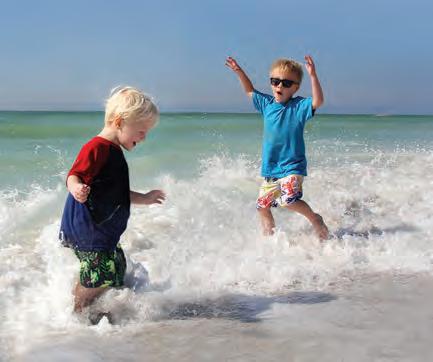
1180 Reef Rd., #B5 Ocean Views, Updated 2 Bdrm in The Billows $935,000 300 Harbour Dr., #205C Newly Renovated 2 Bdrm/2.5 Bath in Porpoise Bay $759,000 1821 Mooringline Dr., #1D Furnished 2 Bdrm + FL Room, Marina Views in Harbour Side $549,000 Enjoy The Moorings life! The Moorings Realty Sales Co. 2125 Windward Way, Vero Beach, Fl 32963 | sales@TheMoorings.com MARSHA SHERRY, BROKER . ERIKA ROSS . DAINA BERTRAND COLLIER PROCTOR . CHRIS BUTLER . AMY SEROVICH 2245 Southwinds Blvd., #104 • $1,550,000 • Ocean Views & Coastal Luxury Renovated 3 Bdrm/3 Bath • Southwinds Oceanfront Community LUXURY WATERFRONT HOMES • CONDOMINIUMS • HOMESITES 772.231.5131 | TheMoorings.com
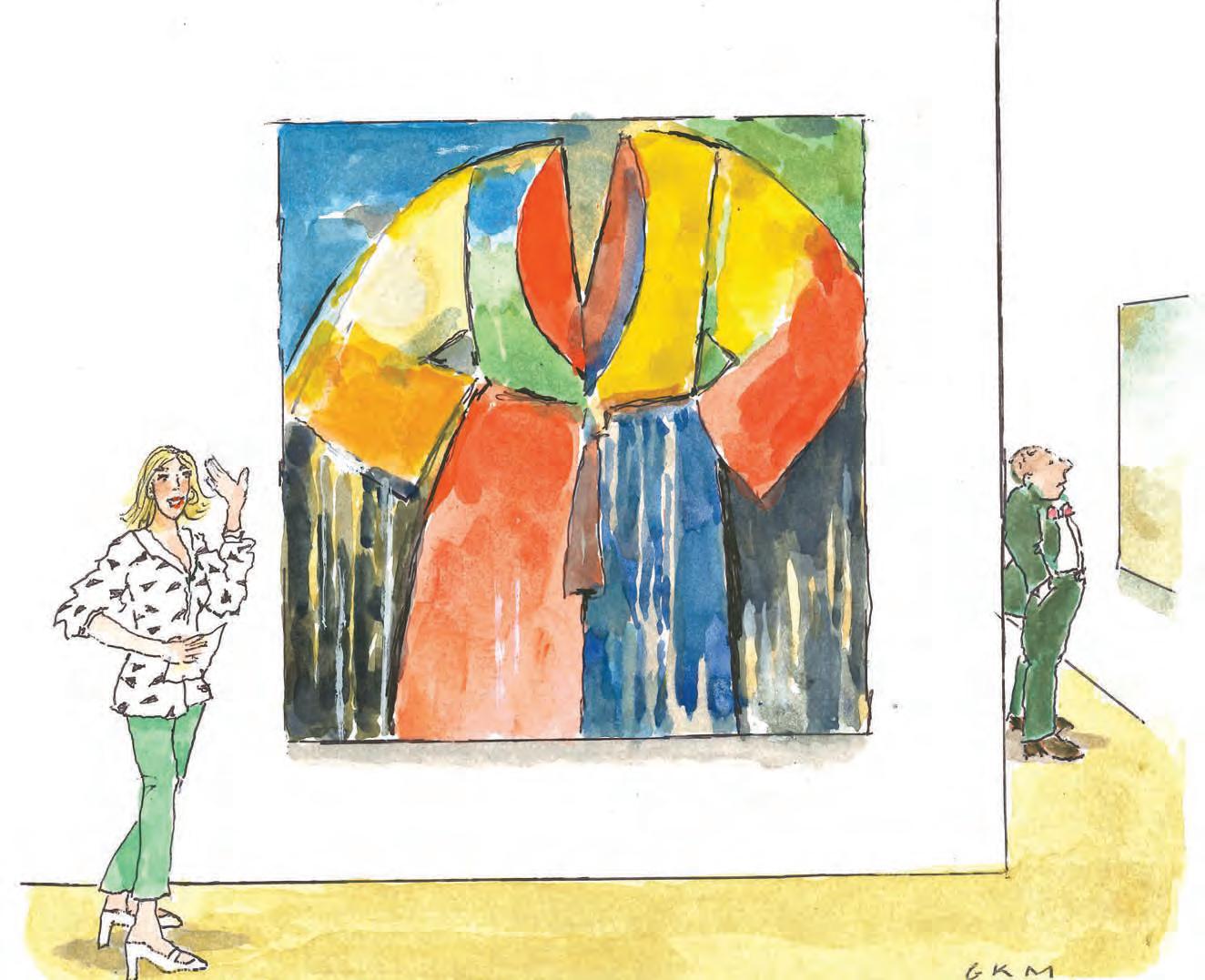
There is an art to a good real estate deal. Call the Charlotte Terry Group for some lessons. CHARLOTTE TERRY h PATTY VALDES h MARIA CALDARONE 2911 Ocean Drive, Vero Beach, Florida 32963 Across from Humiston Park 772.234.8500 h www.charlotteterry.com Charlotte Terry Group of Alex MacWilliam Real Estate, Inc. Two of Vero Beach’s most trusted names in real estate


















































































 800
800





















































 Kelly Rogers editor@verobeachmagazine.com
Kelly Rogers editor@verobeachmagazine.com












 Teri Amey-Arnold, Publisher publisher@verobeachmagazine.com
Teri Amey-Arnold, Publisher publisher@verobeachmagazine.com






































 BY EVELYN WILDE MAYERSON
BY EVELYN WILDE MAYERSON









































































 BY JEFFREY R. PICKERING
BY JEFFREY R. PICKERING





































 WRITTEN AND PHOTOGRAPHED BY PATRICK MERRELL
WRITTEN AND PHOTOGRAPHED BY PATRICK MERRELL






 This Crosley station wagon was on display last year at Sebring Raceway, the site of the Hotshot’s moment of glory 73 years earlier. The grille and propeller on this 1950 are from a 1951 model, swapped in when Darrell Zeran restored it. The greyhound hood ornament is an a ermarket item from another manufacturer.
The bestseller in Crosley’s mail-order business
This Crosley station wagon was on display last year at Sebring Raceway, the site of the Hotshot’s moment of glory 73 years earlier. The grille and propeller on this 1950 are from a 1951 model, swapped in when Darrell Zeran restored it. The greyhound hood ornament is an a ermarket item from another manufacturer.
The bestseller in Crosley’s mail-order business










































 BY RENÁE TESAURO
BY RENÁE TESAURO


















































 BY AMY ROBINSON
BY AMY ROBINSON












































































































































 Above: Baby Tempo, African elephant, Botswana
Left: Wild Dog , African wild dog, South Africa
Opposite page: A Bit of a Stretch , serval cat, South Africa
Above: Baby Tempo, African elephant, Botswana
Left: Wild Dog , African wild dog, South Africa
Opposite page: A Bit of a Stretch , serval cat, South Africa





































































































































































































































































































































































